Western Andalucia
HUELVA TO MÁLAGA – SPAIN















Crossbill Guides: Western Andalucía – Huelva to Málaga - Spain
First print: 2017
Second print: 2024
Initiative, text and research: Dirk Hilbers
Additional research, text and information: John Cantelo, Luc Hoogenstein, Kim Lotterman, Albert Vliegenthart
Editing: John Cantelo, Brian Clews, Cees Hilbers, Riet Hilbers, Kim Lotterman
Illustrations: Horst Wolter
Maps: Dirk Hilbers
Type and image setting: Oscar Lourens
Print: ORO grafic projectmanagement / PNB Letland
ISBN 978-94-91648-33-5
This book is made with FSC-certified paper. The printing process is CO2-neutral through carbon-offsetting. To compensate for the CO2-emissions of the printing processes, we’ve invested in a reafforestation project plus nature conservation in Europe. For more information, scan the qr-code. You can find the certificate of the carbon-offset on our website under ‘downloads’ on the Western Andalucía guidebook page.
All rights reserved. No part of this book may be reproduced in any form by print, photocopy, microfilm or any other means without the written permission of the Crossbill Guides Foundation.
The Crossbill Guides Foundation and its authors have done their utmost to provide accurate and current information and describe only routes, trails and tracks that are safe to explore. However, things do change and readers are strongly urged to check locally for current conditions and for any changes in circumstances. Neither the Crossbill Guides Foundation nor its authors or publishers can accept responsibillity for any loss, injury or inconveniences sustained by readers as a result of the information provided in this guide.
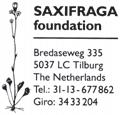
This guidebook is a product of the non-profit foundation Crossbill Guides. By publishing these books we want to introduce more people to the joys of Europe’s beautiful natural heritage and to increase the understanding of the ecological values that underlie conservation efforts. Most of this heritage is protected for ecological reasons and we want to provide insight into these reasons to the public at large. By doing so we hope that more people support the ideas behind nature conservation. For more information about us and our guides you can visit our website at:
WWW.CROSSBILLGUIDES.ORG
Booted Eagle and Black Kite
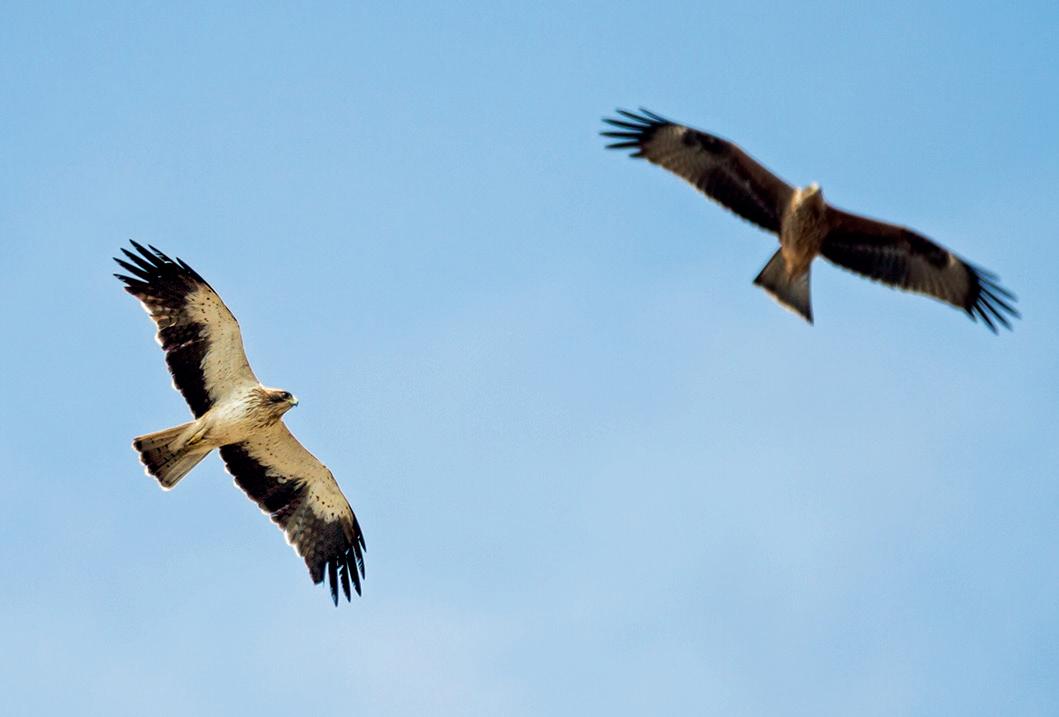
2
Common Chameleon
Marvel at the exotic flora and fauna. In addition to flamingos, vultures and eagles, western Andalucía has odd insectivorous plants, Europe’s largest butterflies, giant spiders, chameleons, terrapins and many more astonishing examples of exciting wildlife.
Purple Gallinule
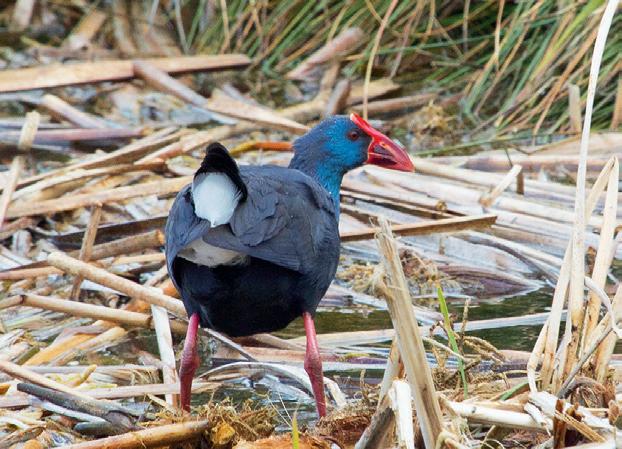
1 Head to Tarifa between late August and late October to witness the great exodus of hundreds of thousands of migrating birds from Europe across the Strait of Gibraltar to Africa (and go back in spring for their return)
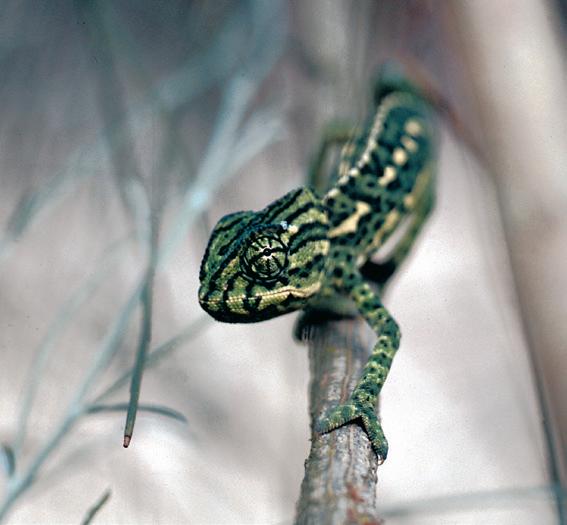
3 Visit Coto Doñana, one of Europe’s most important wetlands. In wet springs, the marshes are alive with countless waders and waterfowl.
Los Alcornocales
4 Walk the hills of the leafy Alcornocales, a large expanse of cork oak woods, pierced by secluded valleys with pretty streams which are havens for rare wildflowers and dragonflies.
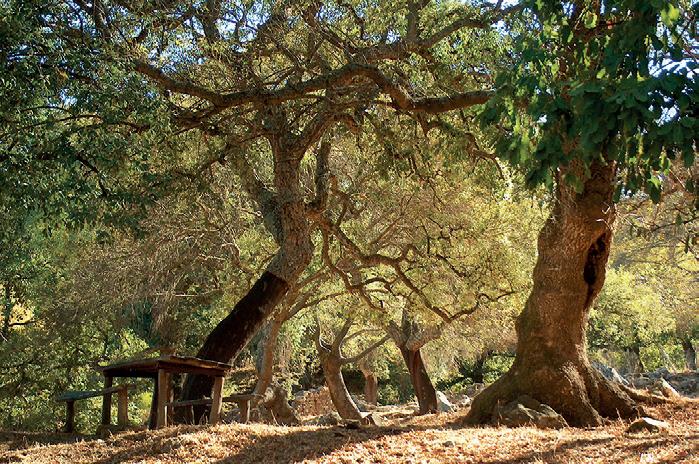

6 The pretty mountains of Sierra de Grazalema and Sierra de las Nieves are a must see. Exposed karst plateaux alternate with lush valleys and the gloomy, but unique, relict forests of Spanish Fir – all with a very rich flora that includes plenty of orchids.

8 Visit the exotic Laguna de Fuente de Piedra, the second-largest steppe lake in Spain and home to Europe’s secondlargest colony of Greater Flamingos.
5 Feel awed by the limestone plateaux of El Torcal, a superb karst landscape that looks like a petrified metropolis.
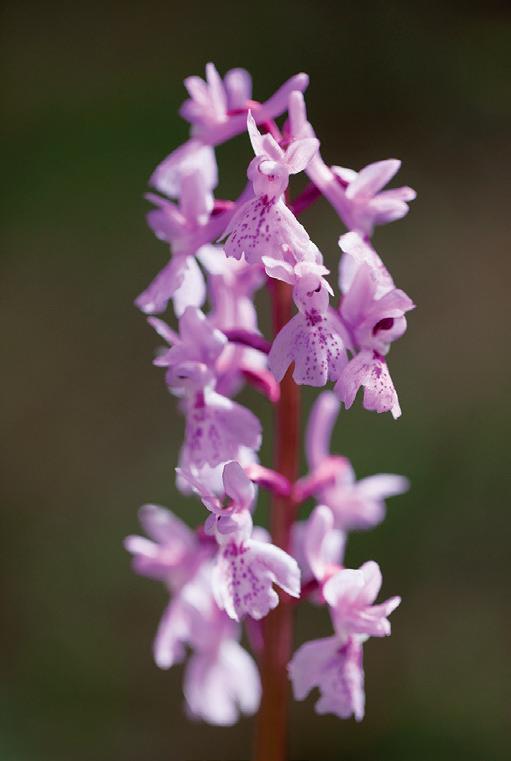
7 Head north to the Sierra de Aracena where traditional pig rearing in open holm oak woods is at the heart of a unique ecosystem which is very rich in birds, above all raptors.

Torcal de Antequera
Spanish Early-purple Orchid* (Orchis olbiensis)
Iberico-pigs in the Sierra Morena.




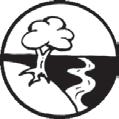

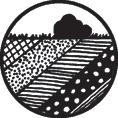
boat trip or ferry crossing
bicycle route
car route beautiful scenery walking route interesting history interesting geology
This guide is meant for all those who enjoy being in and learning about nature, whether you already know all about it or not. It is set up a little differently from most guides. We focus on explaining the natural and ecological features of an area rather than merely describing the site. We choose this approach because the nature of an area is more interesting, enjoyable and valuable when seen in the context of its complex relationships. The interplay of different species with each other and with their environment is astonishing. The clever tricks and gimmicks that are put to use to beat life’s challenges are as fascinating as they are countless. Take our namesake the Crossbill: at first glance it’s just a big finch with an awkward bill. But there is more to the Crossbill than meets the eye. This bill is beautifully adapted for life in coniferous forests. It is used like scissors to cut open pinecones and eat the seeds that are unobtainable for other birds. In the Scandinavian countries where Pine and Spruce take up the greater part of the forests, several Crossbill species have each managed to answer two of life’s most pressing questions: how to get food and avoid direct competition. By evolving crossed bills, each differing subtly, they have secured a monopoly of the seeds produced by cones of varying sizes. So complex is this relationship that scientists are still debating exactly how many different species of Crossbill actually exist. Now this should heighten the appreciation of what at first glance was merely an odd bird with a beak that doesn’t seem to close properly. Once its interrelationships are seen, nature comes alive, wherever you are. To some, impressed by the ‘virtual’ familiarity that television has granted to the wilderness of the Amazon, the vastness of the Serengeti or the sublimity of Yellowstone, European nature may seem a puny surrogate, good merely for the casual stroll. In short, the argument seems to be that if you haven’t seen a Jaguar, Lion or Grizzly Bear, then you haven’t seen the ‘real thing’. Nonsense, of course. But where to go? And how? What is there to see? That is where this guide comes in. We describe the how, the why, the when, the where and the how come of Europe’s most beautiful areas. In clear and accessible language, we explain the nature of Andalucía and refer extensively to routes where the area’s features can be observed best. We try to make Andalucía come alive. We hope that we succeed.
This guidebook contains a descriptive and a practical section. The descriptive part comes first and gives you insight into the most striking and interesting natural features of the area. It provides an understanding of what you will see when you go out exploring. The descriptive part consists of a landscape section (marked with a red bar), describing the habitats, the history and the landscape in general, and of a flora and fauna section (marked with a green bar), which discusses the plants and animals that occur in the region.
The second part offers the practical information (marked with a purple bar). A series of routes (walks and car drives) are carefully selected to give you a good flavour of all the habitats, flora and fauna that western Andalucía has to offer. At the start of each route description, a number of icons give a quick overview of the characteristics of each route. These icons are explained in the margin of this page. The final part of the book (marked with blue squares) provides some basic tourist information and some tips on finding plants, birds and other animals.
There is no need to read the book from cover to cover. Instead, each small chapter stands on its own and refers to the routes most suitable for viewing the particular features described in it. Conversely, descriptions of each route refer to the chapters that explain more in depth the most typical features that can be seen along the way.
In the back of the guide we have included a list of all the mentioned plant and animal species, with their scientific names and translations into German and Dutch. Some species names have an asterix (*) following them. This indicates that there is no official English name for this species and that we have taken the liberty of coining one. We realise this will meet with some reservations by those who are familiar with scientific names. For the sake of readability however, we have decided to translate the scientific name, or, when this made no sense, we gave a name that best describes the species’ appearance or distribution. Please note that we do not want to claim these as the official names. We merely want to make the text easier to follow for those not familiar with scientific names. An overview of the area described in this book is given on the map on page 15. For your convenience we have also turned the inner side of the back flap into a map of the area indicating all the described routes. Descriptions in the explanatory text refer to these routes.

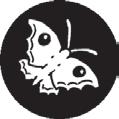






site for snorkelling
interesting for whales and dolphins
visualising the ecological contexts described in this guide interesting flora interesting invertebrate life interesting reptile and amphibian life interesting mammals interesting birdlife
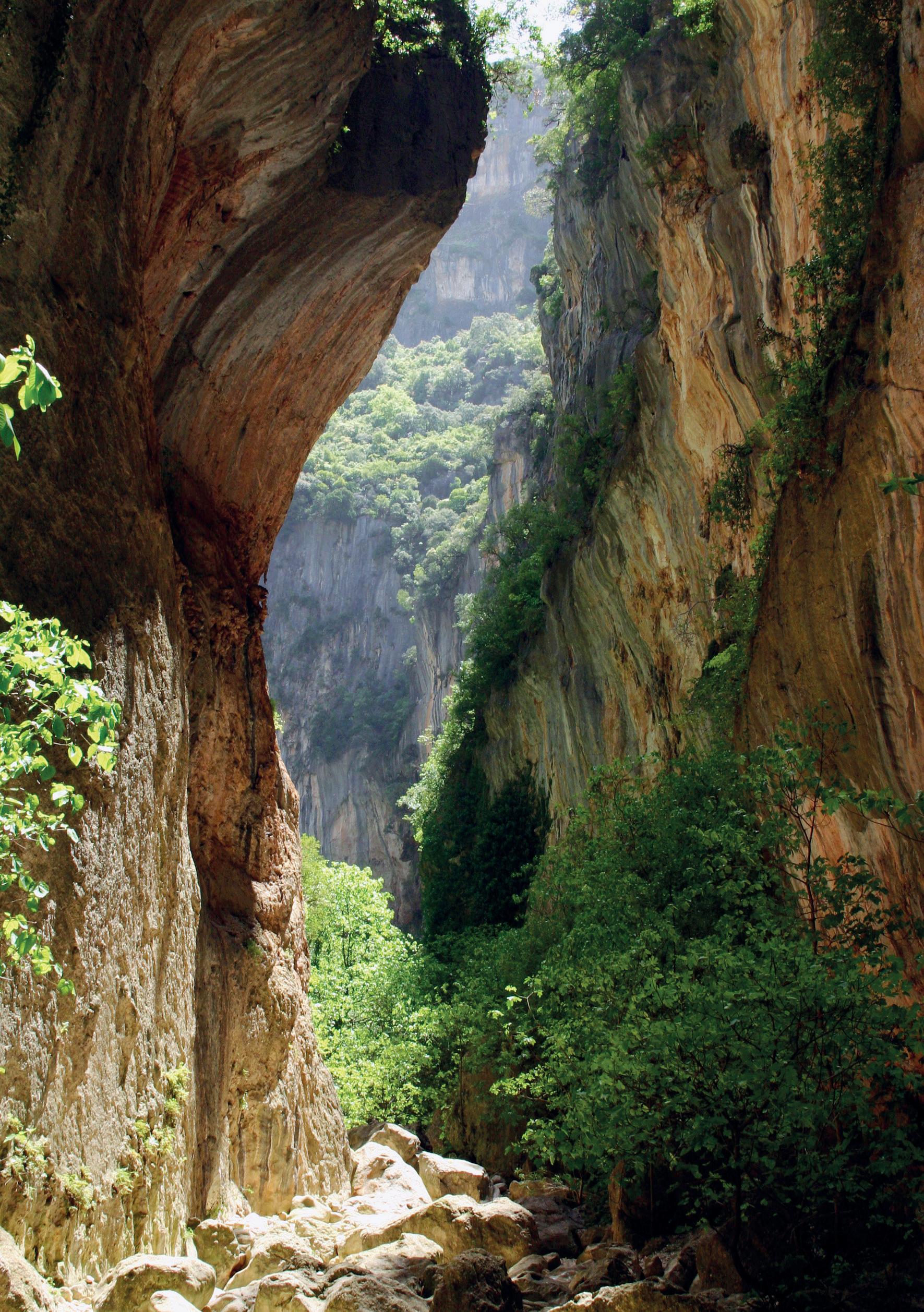
Western Andalucía is a hugely diverse and endlessly fascinating region. Between the barren thirsty karst plateaux high in the mountains and the marshy coastal flats of Coto Doñana lies a superb range of landscapes. There are Arcadian cork oak orchards and cool, shady, jungle-like river valleys, but also natural steppe lakes (rare in Europe!) and rocky plains that are extremely exposed and hot. There are wild gorges that cut deep into the bedrock and equally wild cliffs that tower high above the surrounding land – in short, the variation in landscape of western Andalucía is enormous.
What remains pretty much constant though, is the general intactness of it all. The marshes of Coto Doñana are a true gem. At its margin is a beach which is, at 25 kms, the longest unspoilt one in Spain. Except for a few minor roads and pretty whitewashed villages, the oak woods of the Sierra Morena run, uninterrupted, for hundreds of kilometres. The Alcornocales and Sierra de Grazalema are similarly wild. The wildlife of western Andalucía matches this diversity and grandeur. There are plenty of butterflies, numerous rare dragonflies and scores of reptiles and amphibians. The flora consists of plants adapted to severe drought as well as those that require permanent dampness and everything in between. But nothing beats the birdlife. It is hard to name an area in Europe with a higher diversity of birds. From the familiar iconic ones like Greater Flamingo, Hoopoe and Bee-eater to the more obscure and rare African birds as White-rumped Swift and Rüppell’s Vulture and flagship species of large undisturbed areas such as Spanish Imperial and Bonelli’s Eagle – western Andalucía has it all. In addition, the area is washed over twice a year by millions of migrant birds that cross the Straits of Gibraltar on their way to and from breeding or wintering quarters. You get the picture – visit western Andalucía once and you want to return over and over again. This book will help you get to the best sites and tell you where to go and what to look for. Vámos!
The landscape of western Andalucía has many dramatic features, such as the secluded Garganta Verde gorge (route 14).
Andalucía is the southernmost of the fifteen autonomous regions of mainland Spain. It spreads from the Portuguese border in the west all along the south coast to the autonomous region of Murcia in the east, Castilla–La Mancha in the northeast and Extremadura in the northwest. Andalucía is divided into eight provinces, of which Huelva, Sevilla, Cádiz and Málaga are covered in this guidebook on western Andalucía and others in a second volume on eastern Andalucía.
Overview of western Andalucía Sierra
Castilla –La Mancha
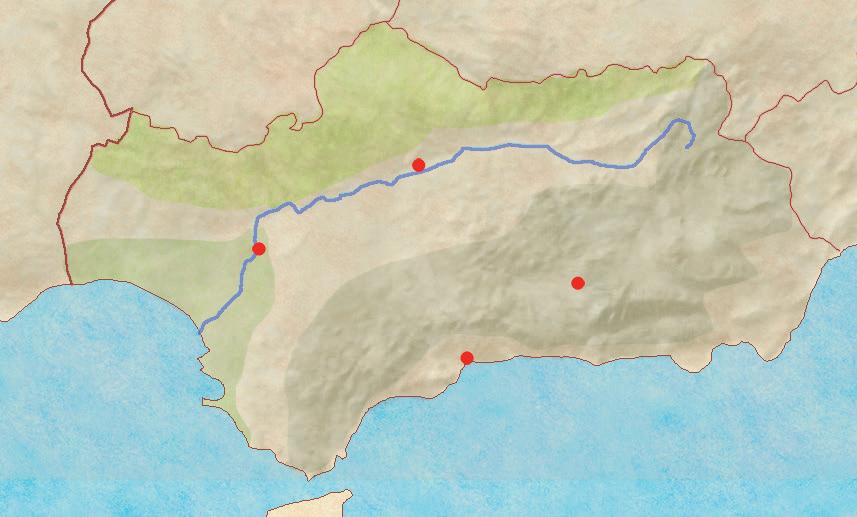
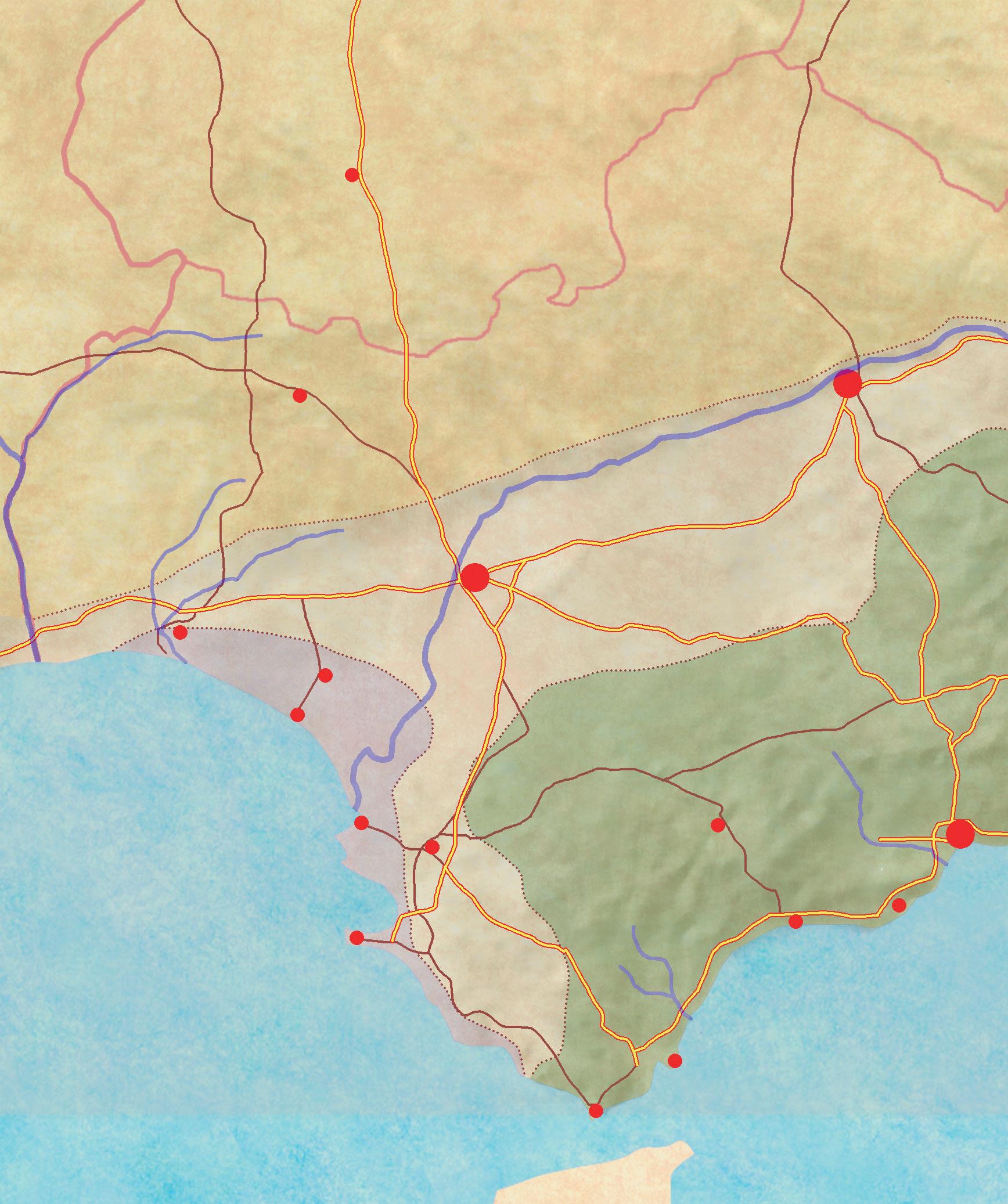
From a topographical perspective, there are four distinctive landscapes in western Andalucía. In the north, bordering Extremadura and Castilla–La Mancha, are the rolling, wooded hills of the Sierra Morena. In the south rise the rugged mountains of the Sierra Baetica, which stretch out from Gibraltar all the way east along the coast towards the Sierra Nevada and Sierra de Cazorla in eastern Andalucía. Like a wedge between these two ranges lies the large lowland depression of the Guadalquivir river. The fourth and final region is the coastal strip, with its mixture of saltmarshes, fossilised dunes and rolling hills.
The Sierra Morena is an extensive, 400 km long range of hills and low mountains that stretch from the Portuguese border to the province of Jaén. The landscape is sparsely populated, covered in dehesas (oak groves), scrubland, some pine and eucalyptus plantations and pockets of original Mediterranean woodland. The landscape and its nature is reminiscent of Extremadura and Castilla–La Mancha, of which it is geologically a part. Almost all of the Sierra Morena is protected by a series of Parques Naturales.
The central basin of Andalucía is the centre of human activity – this is where the big cities of Sevilla, Córdoba, Huelva, and, further east, Jaén are situated. It is also one of the agricultural powerhouses of Spain: endless fields and olive groves surround the towns and villages. The central part of the Guadalquivir basin – roughly the region between Sevilla and Córdoba – is the hottest part of mainland Spain. The natural attraction of this plain lies in the presence of dry steppes (many of which are now degraded) and complexes of temporary lagoons.
The rivers that drain the central basin have formed a large lowland plain all along the Atlantic coast. Extensive coastal marshes, known as
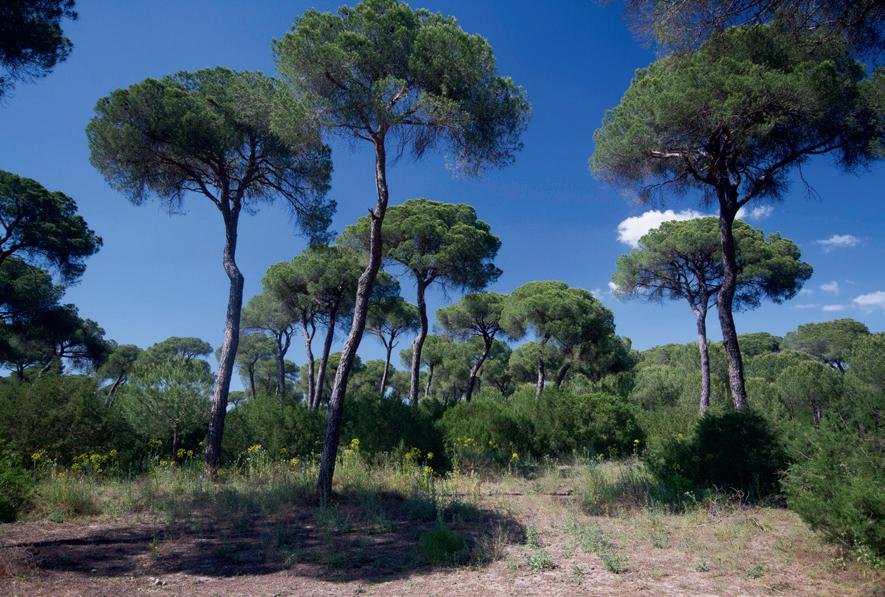
marismas , support a very rich flora and fauna. The largest and most famous of these coastal marshes are those of the Coto Doñana National Park. Together with the surrounding scrublands and umbrella pine forests they are one of the key regions for visiting naturalists. The coast west of Gibraltar is also known as the Costa de la Luz (the coast of light). It is one of the least developed of all the Spanish ‘costas’. Here the salinas and creeks of the Bahía de Cádiz constitute one of the largest areas of estuarine habitat in Spain. Further east, the Campo de Gibraltar forms a mixture of rolling foothills of the Sierra Baetica and river valleys and small estuaries. The almost subtropical climate makes this a distinct region from a biological point of view.
The Costa del Sol, which runs from Algeciras to Málaga, is unlike the Costa de la Luz, heavily developed and, as a result, it is not as attractive for naturalists.
The Sierra Baetica is completely different from the Sierra Morena. The landscape is more varied, with dense cork oak forests in some parts and elsewhere with barren limestone plateaux, dissected by steep gorges. Geologically, the Sierra Baetica is part of a complex range that extends from the Moroccan Rif mountains to Mallorca. They are much younger than the Sierra Morena and the mountains of central Spain, and have a very different flora and fauna.
The section of the Sierra Baetica that lies within the area of this book, has two very different faces. Its western part is dominated by Los Alcornocales – a huge and little populated area of sandstones, covered in cork oak forests and dissected by humid valleys.
East of this area lies a large area of limestone mountains, which are broken up into smaller sierras by areas of lowland. The Sierra de Grazalema is the most famous of these limestone karst sierras. To the west it is a seamless continuation with the Alcornocales, but to the east it borders the lowlands of the town of Ronda which separates it from the Sierra de las Nieves . The latter is the highest massif of western Andalucía (as defined by this book). Further east lie the massifs of El Chorro and Torcal de Antequera, which are a continuation of the same belt of limestone. At the southern edge of the mountains are some of Spain’s most famous beach resorts, such as at Málaga, Torremolinos and Marbella.
The Sierra Morena, the central plains and the Sierra Baetica may be geological and ecological unities, they are certainly not separate regions from a touristic perspective. Travelling the Sierra Morena from west
to east is impossible because of the lack of roads. You could do so in the Sierra Baetica, but the endless series of curves and narrow roads is befuddling and time consuming. It is much easier to combine areas of the Sierras with nearby lowlands – and much more rewarding as well, since the diversity of landscapes, flora and fauna is much greater when combining lowland and mountain areas. Hence the routes and sites described from page 133 onwards, are grouped in sections that are more conveniently covered from a single starting point.

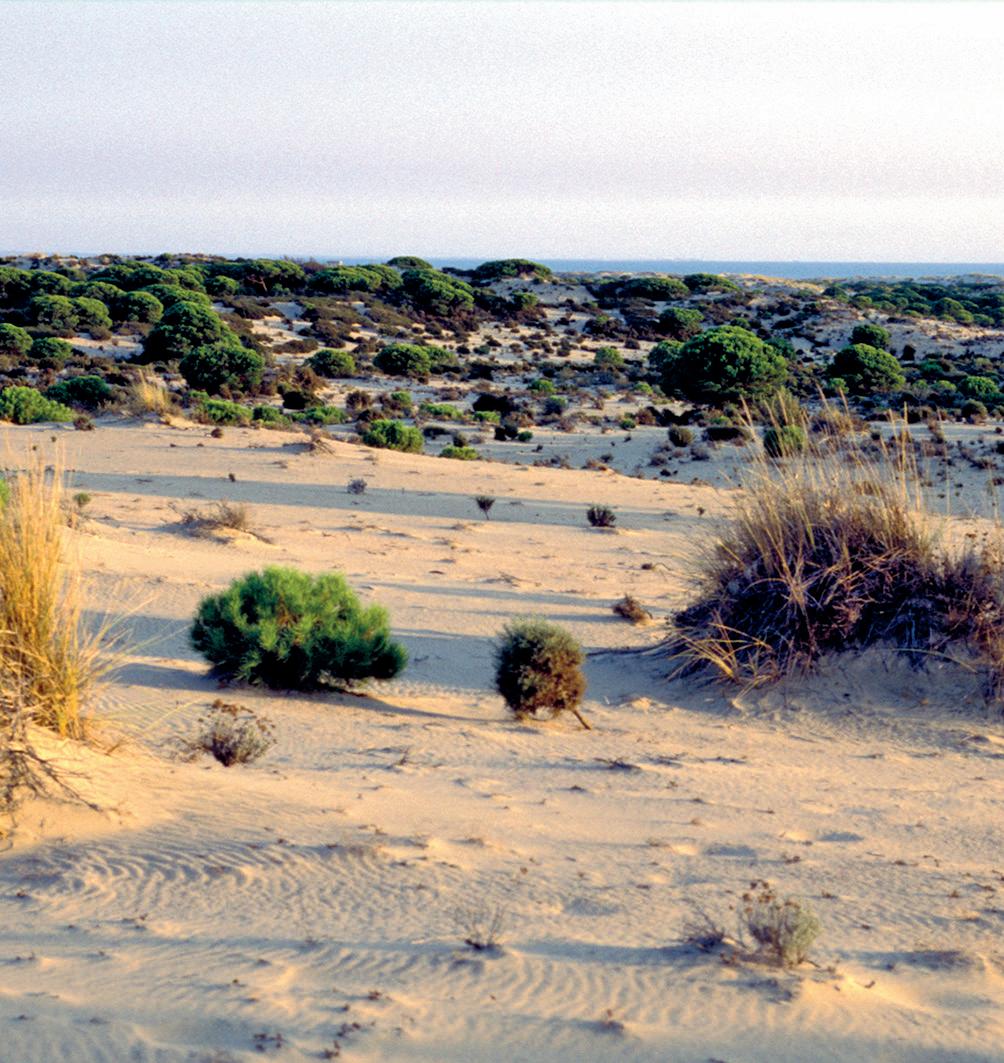

Torcal de Antequera (site C on page 224), one of the most impressive karst plateaux in Europe. The limestones of the old seabed rose vertically, leaving a pattern of horizontal layering in the rock, which is creviced vertically due to the erosive and corrosive workings of rain water. The result resembles a pertrified metropole.
did not leave the Sierra Morena entirely unaffected: especially in the eastern part (Sierra de Andújar and Despeñaperros; covered in our guidebook on eastern Andalucía), the mountains rose and the relief became accentuated.
The Sierra Baetica rose from the bottom of a sea, just like the Hercynian plateaux, but this sea had been full of shelled marine life for millions of years. Their remains had been deposited in thick layers on the ocean floor and compressed into limestone. Hence, large parts of the Baetic mountains consist of limestone – a sharp contrast with the Sierra Morena. Nevertheless, the Sierra Baetica has important pockets of sandstone as well, such as in Los Alcornocales and Montes de Málaga.
Limestone is different from sandstone in about every imaginable way. It erodes easily, which is why the calcareous parts of the Sierra Baetica have dramatic cliffs, barren karsts, and deeply indented valleys, but there are also areas with gently rolling hills where the dissolved minerals were later deposited to form deep nutrient-rich soils, excellent for growing crops. Limestone is also very porous: rain easily sinks into the bedrock, leaving the plateaux dry even in areas with a lot of rain. Elsewhere, the water reappears as streams which carry water throughout the year. And perhaps most importantly, the chemical make-up of limestone is very different from acidic soils, and therefore this bedrock sports a very different flora. This corrosive interplay of water (naturally slightly acidic) and limestone (basic) results in some of the world’s most stunning landscapes: karst. Karst plateaux (karst features are usually on plateaux) are extremely

rocky, with many holes and crevices. Within our region, the limestones happen to be in the region with the highest and most torrential rainfall and as a result, the karst landscapes here are among the most dramatic in Europe. Some crevices have eroded so deeply and criss-cross the plateaux so chaotically, it is as if you are walking deep down in a petrified maze. The Torcal de Antequera (site C on page 224) is, in this respect, the most impressive. The corrosion continues underground as the water seeps through the softest limestone layers. Over millions of years, the water has carved out immense cave systems that make the interior of the karst sierras like a Swiss cheese. Many of these underground caves have collapsed, leaving depressions of various sizes, into which water runs down and accumulates. Here, the water finally returns what it has taken away elsewhere. The suspended limestone sinks down to form a thick layer of nutritious soil. These depressions are called dolines when they are small or poljes when they cover several square kilometres. The poljes are so green and lush that they look artificial in the stony surroundings. To an extent they are, because generations of farmers have taken away the stones to take advantage of these relatively scarce patches of fertile soil (Polje comes from the word for field in Serbo-Croatian). Most settlements in the karst sierras are situated near these poljes and dolines.
Hercynian plateaux
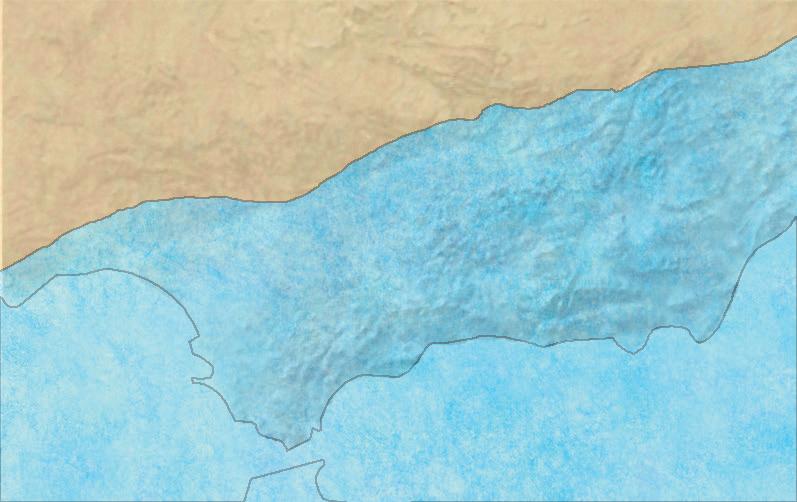
Hercynian plateaux
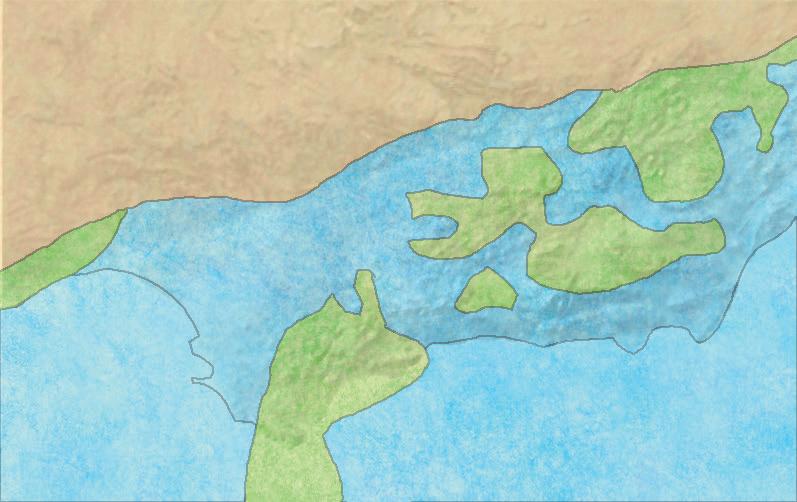
Hercynian plateaux

Hercynian plateaux

With the rise of the Cordillera Baetica (a process which still continues), the landscape of Andalucía changed dramatically. It was no longer a shallow sea at the foot of the Sierra Morena. It became a bay surrounded by mountains – mountains that caught moist oceanic air, causing rainfall which formed rivers that washed down sediments into the bay. These feeder streams deposited so much sediment that the bay gradually filled up leaving at the centre of the basin the mighty Guadalquivir River (Guadalquivir comes from the Arab Al-wadi-al-Kabir – literally the mighty river). This process is ongoing, and has changed the
Andalucía at various stages of geological history.
As the sea winds sweep the huge mobile dunes of Doñana inland, they swallow entire pines.
landscape of lowland Andalucía even in historic times. Seville serves as an excellent example: in Moorish times this city bordered a shallow bay in the Atlantic! What is today the Coto Doñana was then still under the sea.
The Guadalquivir basin is gently undulating. Together with the hot and semi-arid climate, this gives rise to, by European standards, an odd geological phenomenon: endorheic lakes. The relatively wet winter months give rise to small streams that pour into depressions, where lakes are then formed. In the dry summer months these streams, as well as the lakes they feed, dry out. Endorheic lakes are isolated, faced with regular drought and conditions of high salinity, making them unique ecosystems (see page 32).
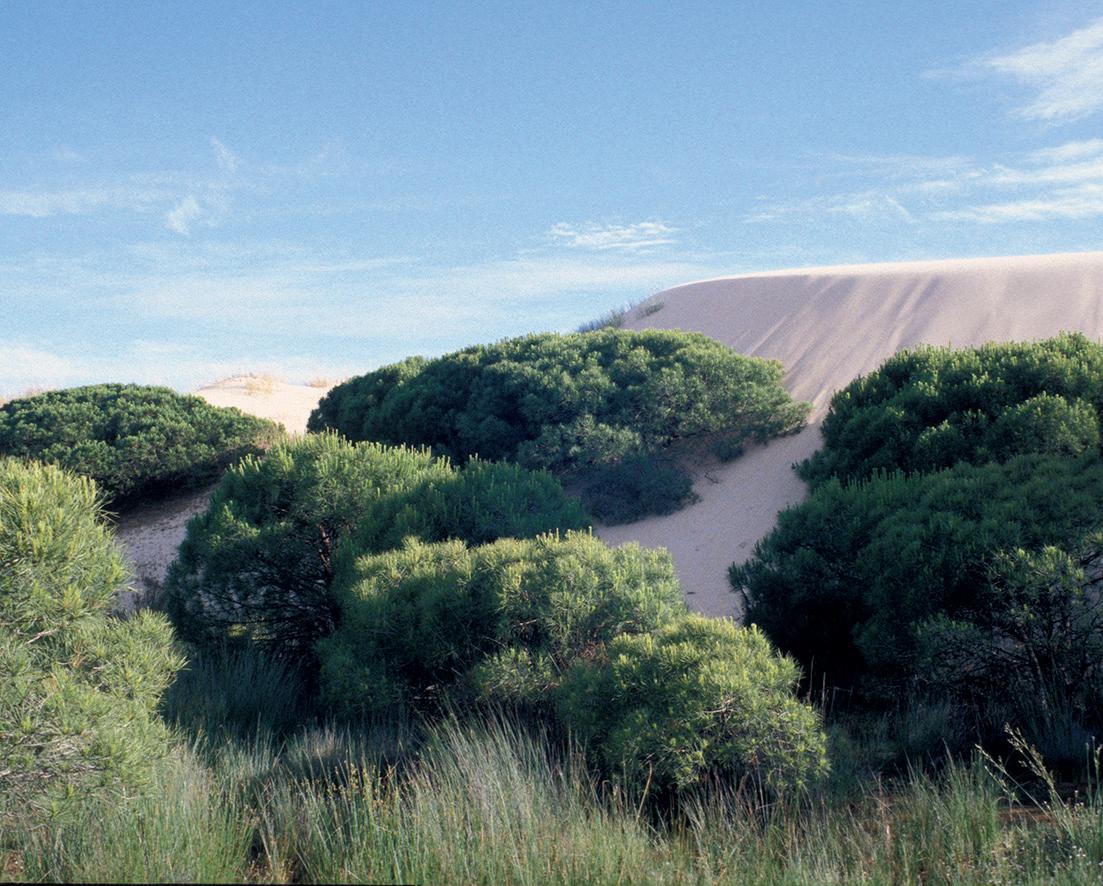
An extraordinary view on the beach of Maneli, near Doñana (route 4). The fossilised dunes (the light substrate), compressed when ancient dunes were submerged by the ocean, are overlain by young sands that are currently being blown over the old dunes.
Most of the Atlantic coast of Andalucía is covered in extensive areas of sand dunes, which culminate in extent and height on the coast of Coto Doñana. Here are some of Europe’s highest sand dunes, some of which overlie escarpments of older, fossilised dunes.
The dunes are a result of the strong westerly currents (and winds), which
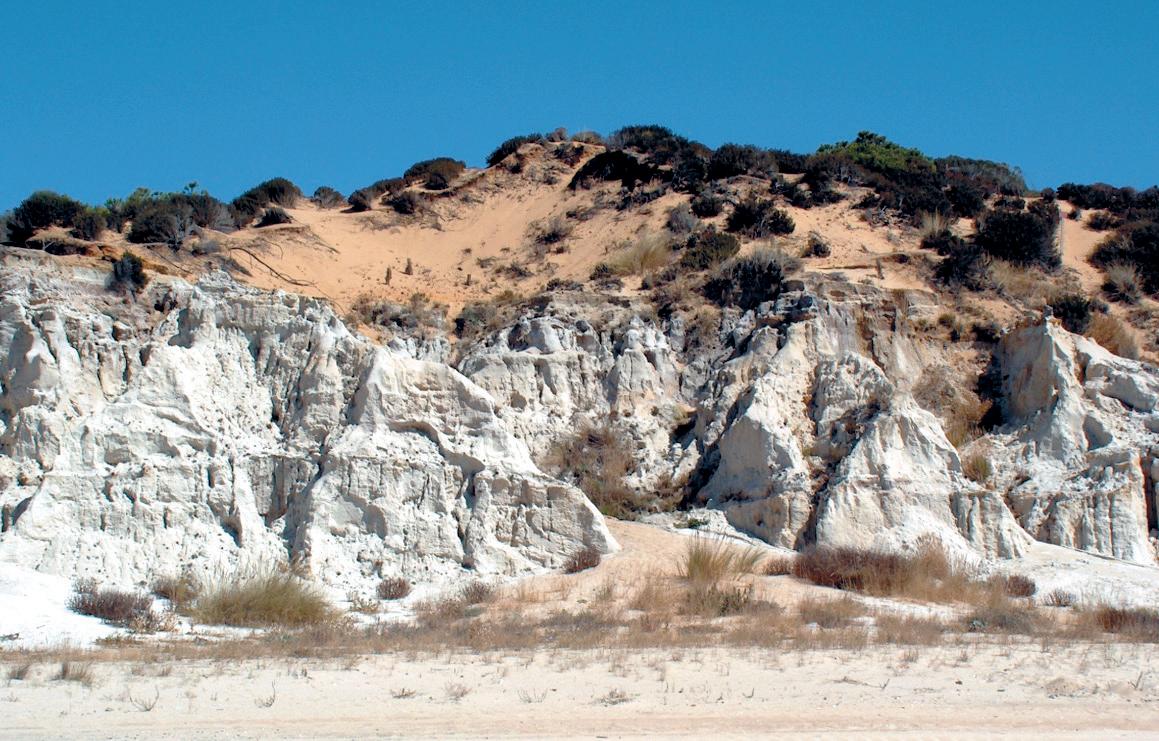
Standing at the shore of Tarifa on a clear day, it seems as if you could almost touch the other side. The Straits of Gibraltar are only fourteen kilometres wide at their narrowest point. Africa is so close you can distinguish its fields and houses with the naked eye. From the earliest times this has been a strategic point of utmost importance, but in geological terms it has played an even greater role. It was the site of one of the most dramatic events in the history of the earth.
In 1970, researchers discovered large salt deposits in the seabed off the shores of Sicily. The seabed also contained remains of small crustaceans adapted to the warm, sunny and highly saline conditions found in shallow lagoons. This discovery gave rise to an extraordinary new scientific insight, namely that at some time the Mediterranean Sea must have dried out almost completely in a process of desiccation on an unimaginable scale.
It is calculated that only 10% of the water that evaporates each year in the Mediterranean Sea, is replaced by the rivers that pour into the basin. The rest comes in from the Atlantic Ocean. When the gates of Gibraltar closed, the Mediterranean Sea evaporated almost entirely in a relatively short period of time. This period of desiccation is referred to as the Messinian salinity crisis . The Mediterranean became the stage of a dramatic empty landscape: a vast, thirsty desert with a few large saline lagoons that shrank with each hot, scorching year. Today, such a moonlike landscape can only be found in the Takla Makan desert in western China.
While the water level continued to drop like an emptying bath tub, the coastal regions of France, Greece and Spain were still in a tectonic rise and towered hundreds of metres above the dried-up seabed. Rivers incised deep gorges or dropped into dramatic depths: a landscape of apocalyptic qualities. Scientists differ in their opinions as to what sealed off the Mediterranean Sea from the Atlantic Ocean and ushered the Messinian Salinity Crisis. It was most likely an ice age that caused the ocean’s water level to drop. Exactly opposite of what is threatening us today. Rivers and lakes froze in the north and no longer replenished the ocean. The combination of the falling sea levels and the rise in the land mass (caused by subterranean forces) cut the Mediterranean off from the Atlantic.
Measured in geological time, the Messinian salinity crisis had an abrupt start, but it ended with a bang – quite literally. A series of earthquakes broke the weakest link of the Baetic Cordillera and the ridge between present-day Gibraltar and Tangier collapsed under the pressure of the Ocean water. Over a length of 15 kilometres a cascade, many times the size of the Niagara Falls, poured into the desert seabed about 300 metres below. It has been estimated that about 65 cubic kilometres(!) of water blasted into the Mediterranean each day through the Gibraltar cascade,
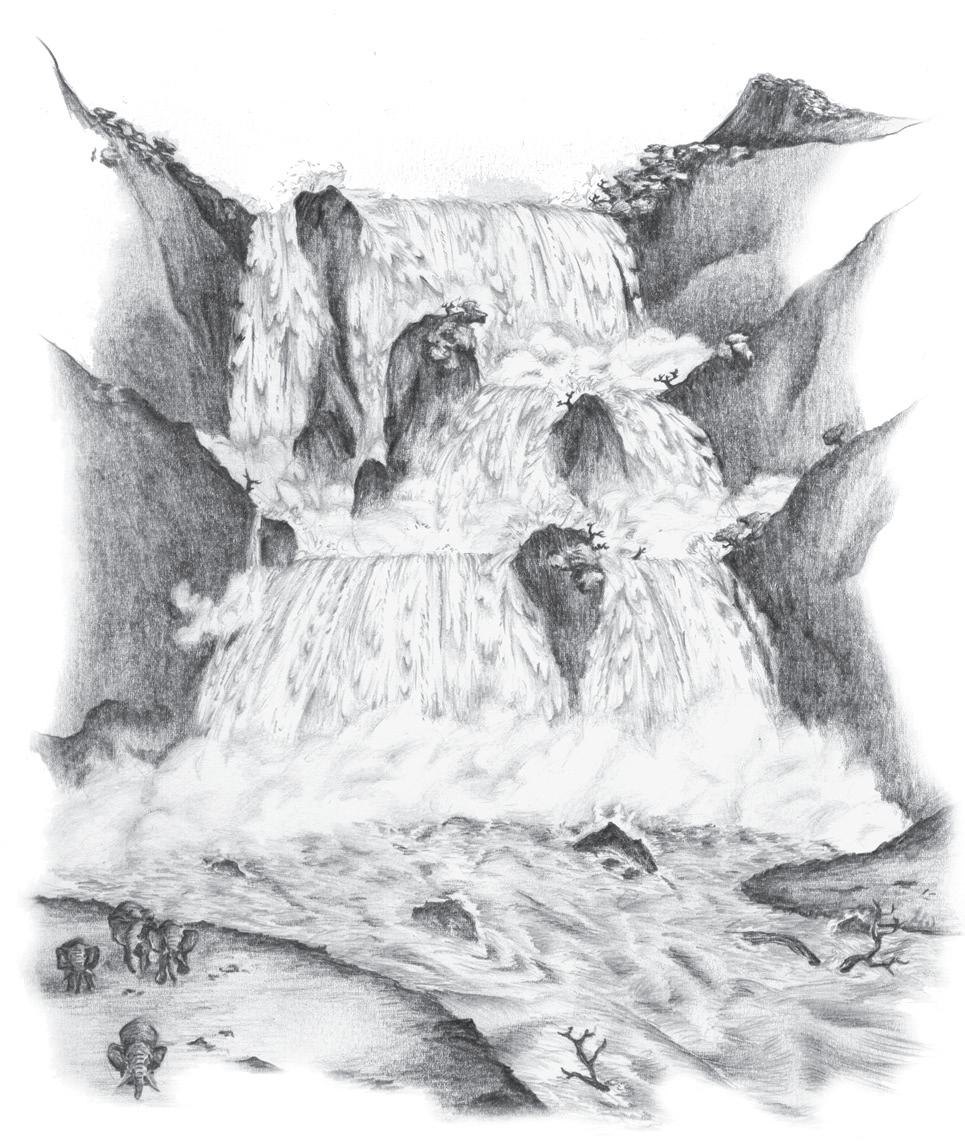
Artist impression of what the ‘Gibraltar Falls’ might have looked like.
filling the entire basin up to its current limits in mere decades. Standing on Europa Point at the tip of Gibraltar today, the sounds of the wind may howl, but just imagine the roar that filled the air if you were to stand there at the end of the salinity crisis.
The chances that somebody actually witnessed the megafalls are very low (although bones of human ancestors found in the Andalucían Sierras precede the date of the Gibraltar catastrophe). However, much later a similar event at the other end of the Mediterranean had a profound impact on both the history and mythology of humankind. The Mediterranean spilled into the Bosphorus and created the present-day Black Sea. This flood is thought by some to be the origin of the biblical story of Noah’s flood.
blow sands into high dunes. The shaping of the current dune landscape started when the seawater levels rose as a result of the warming of the climate following the last ice age. The strong current threw up long sand spits (e.g. the Doñana coast and Punta Umbría south of Huelva). Sheltered from the sea, the rivers slowed and deposited sediments in the bays behind the spits, gradually filling them in to create large areas of marisma salt marsh. Repeated flooding and marine sedimentations fossilised the dunes into a brittle sandstone. Several fault lines (e.g. above Matalascañas (route 1) and near Barbate – route 9) caused the fossilised dunes to emerge as cliffs at the coast – the most prominent of which is the Breña de Barbate. Elsewhere, mobile dunes form enormous and unstoppable ‘tsunamis of sand’, which, swept forth by the wind, rolled inland. In the Doñana National Park and at Bolonia, the massive mobile dunes make for a spectacular landscape.
The whole of western Andalucía has a Mediterranean climate, but one with an Atlantic twist. The summers are, overall, hot and dry and the winters usually cool and quite moist, as is typical for the Mediterranean region. However, the winter cooling is tempered by the western ocean winds.
Together with the Algarve and Almería, the Cádiz coast has the warmest winters in Europe, with the average minimum temperature of over 15° C. Some of the highest summer temperatures of Europe are found in Andalucía as well, but deeper inland, well away from the cooling sea breeze. The Guadalquivir basin between Seville and Córdoba has a more continental type of climate with rather cold winters but some of the hottest summers in the whole of Spain (together with the basins of East Andalucía and Murcia). Ecija, halfway between these two cities, is widely and rightly known as la sartén, the frying pan of Andalucía. Summer daytime temperatures here average over 35° C and are rising with climate change. The prevailing western winds, heavy with water vapour picked up over the ocean, find in the mountains of the Alcornocales and Grazalema their first obstacles. Therefore, the annual rainfall for these mountains is fairly high, in particular in the high Sierra de Grazalema. In fact, with an average of 2200 mm of rain per year, it is the wettest spot in the whole of Spain! This puts it in the same class as England’s wettest region, the Lake District, and so challenges our preconceived ideas of southern Spain. But statistics can be deceiving. The Grazalema soils are not wet. Nearly all rain falls in winter and spring in relatively short, heavy spells. The water seeps right through the cracks in the limestone soil. During the rest of the year, rain is scarce or even absent.
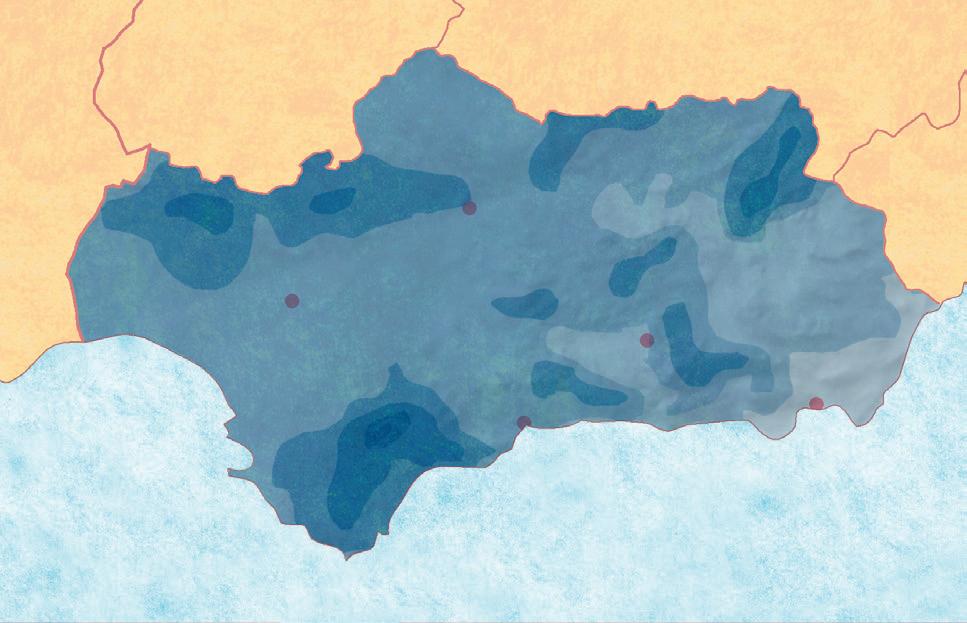
The Sierra de las Nieves (the snowy mountains!) is, with a highpoint of just over 1900 metres, high enough to have a cover of snow in most years (although in keeping with the global climate change, it has snowed considerably less in the last decades).
So all in all, there are four distinct climatic zones in western Andalucía: the relatively cool and precipitous mountains of the Sierra Baetica, the almost subtropical coastal strip with its very mild winters, the more traditional Mediterranean climate of the Sierra Morena and finally, the interior Guadalquivir basin with its continental climate of extremes.
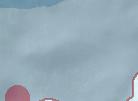




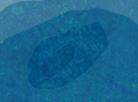
View over the Laguna de Fuente de Piedra, the second-largest natural lake in Spain. It is of vital importance for birds.
water-body that is not part of this great water cycle and whose water will not reach the ocean so directly. Such water-bodies are called endorheic lakes – lakes that have an inflow of water from temporary streams, but no outflow to the sea. The evaporation is simply too strong and the streams that feed these lakes too feeble for these lakes ever to spill out of the depression in which they sit. What remains is an aquatic system that is completely isolated from other water bodies.
Biologically speaking, endorheic lakes are islands. They are isolated from similar habitats. Many aquatic species, fish above all, cannot (naturally) reach these lakes. Without these fish, amphibians and certain kinds of water plants thrive, creating a food chain that is very different from that of other wetlands. In short – the ecosystem of an endorheic lake is unique. The central plain of Andalucía holds quite a number of small endorheic lakes, dotted in the gently rolling tapestry of fields and olive groves. They are especially important for amphibians and pondweeds, plus the birds that feed on these. The rare and threatened White-headed Duck is found mostly on endorheic lakes, and the lakes have important populations of Purple Gallinule, Red-knobbed Coot and Red-crested Pochard. Many endorheic lakes have such a meagre influx of water in winter that they dry out completely during spring. Here the cards are dealt differently again – all the species that occur in these lakes must be able to either flee to other areas (like birds) or to adopt an amphibian lifestyle. Such sites can be teeming with life when conditions are right, or be silent and dormant when dry.
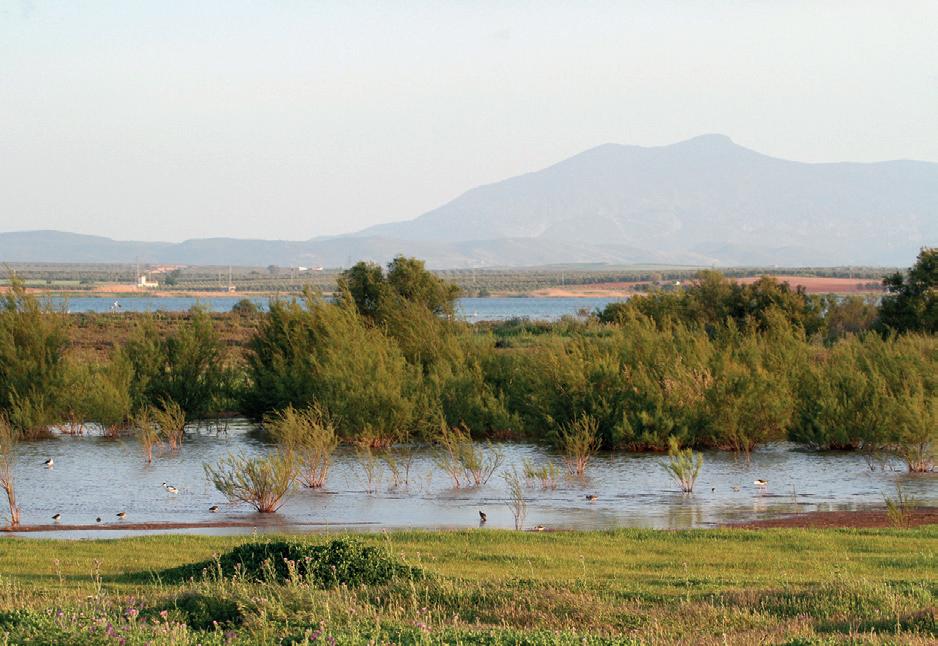
Endorheic lakes can hold fresh or brackish water, depending on the source of the water that feeds them. However, due to the high evaporation, many have become at least slightly brackish, resulting in fringes of saltmarsh, mixed with reeds and bulrushes that root deeper and profit from the periodic inundation in freshwater. This is especially visible in Europe’s largest endorheic lake, the Laguna de Fuente de Piedra (site E on page 226).
Routes 4 and 5 and the sites on page 160 are situated in the Sierra Morena.
The rolling wooded hills of the Sierra Morena run from the Portuguese border eastwards along the edge of Extremadura and Castilla – La Mancha. Geologically, the Sierra Morena marks the southern extreme of the old, Hercynian plateau that forms the bedrock of central Spain (see geology section; page 16). Hence the natural world of the Sierra Morena shows more similarities with central Spain than with the rest of Andalucía. More specifically, the western Sierra Morena, to which we limit ourselves in this guide, resembles Extremadura. Just like Extremadura, the landscape of the Sierra Morena is dominated by open woodlands of Holm oak. If you drive the N433 from Sevilla to Aracena, you cross a landscape that is best described as endless groves of oak trees. This is a beautiful and inviting scenery in spring as the swards between the trees are full of flowers. In summer and autumn, when the grass turns yellow, it has more the feel of a savannah – an association that is strengthened by the broad canopies of the trees. This is the dehesa, a vegetation that is unique to south-west Iberia. It dominates the lower parts of the Hercynian plateaux, from the Sierra Morena west into Portugal and north into Extremadura and the borders of Castilla Leon and Castilla La Mancha. Dehesas are special in many ways, ecologically and culturally (as we’ll discuss further on in this chapter).

Location of the Sierra Morena (light grey). In dark, the part known as Sierra de Aracena, on which we focus in this guide.
Cross-section
the Sierra Morena.
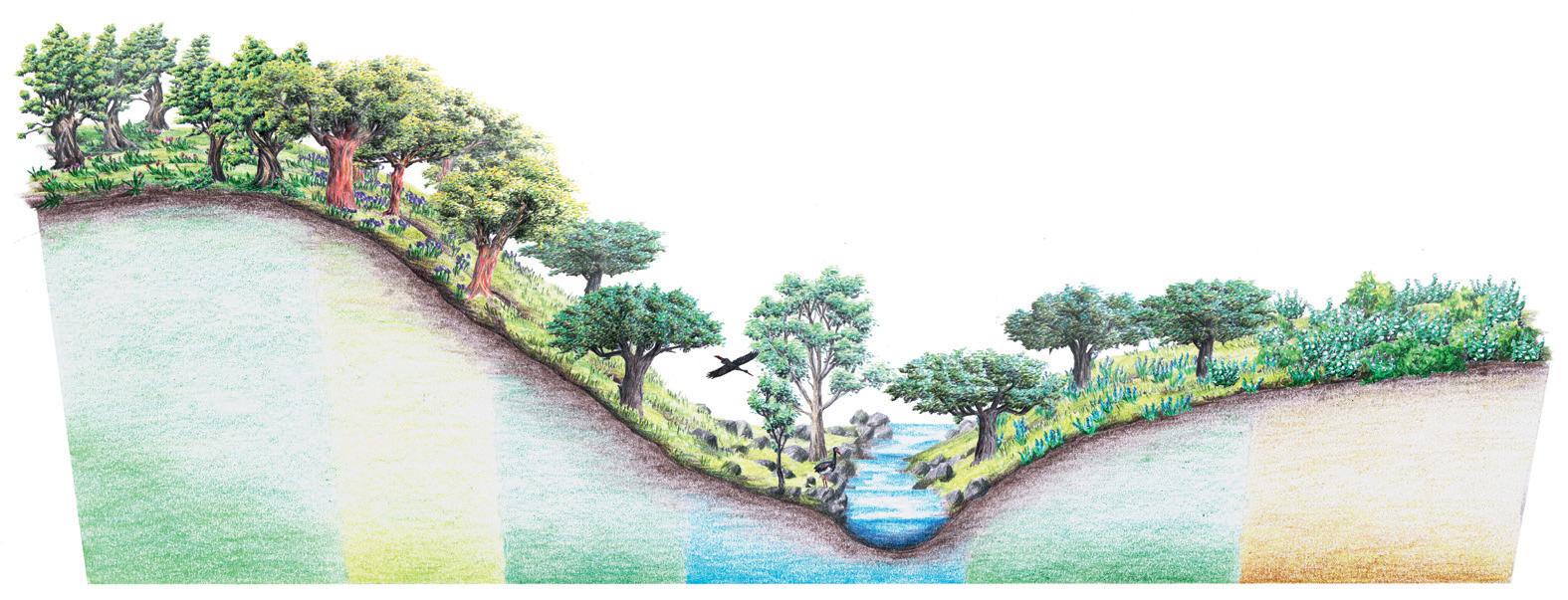
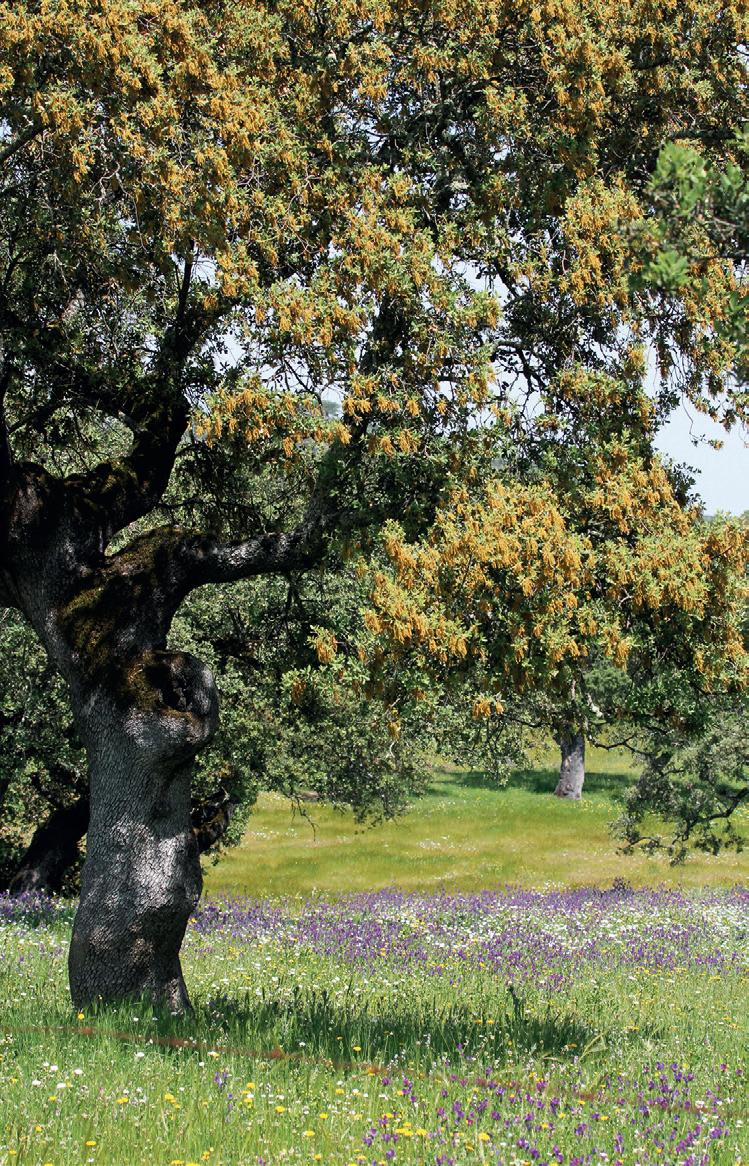
Dehesa is not the only habitat in the Sierra Morena. In spite of its modest elevation (most peaks are 700-900 metres high) and rolling character (in particular in the western section), the Sierra Morena has an excellent variation of habitats that ranges from the river valley via the dehesa-clad slopes up to the higher peaks where scrublands, chestnut groves and Pyrenean Oak woodlands dominate.
The rivers are green, densely vegetated ribbons in the dehesa-clad hills. Most of them have a seasonal water flow. The current is strong in winter as the rains fall and the water, hardly able to penetrate the bedrock, seeks its way above ground down to the valleys. In summer, the rivers dry out to a series of pools in most places, although the shady conditions in the valleys, together with the occasional groundwater source, maintains standing water throughout the dry season.
The broad rivers at low elevations (like the Chanza; route 5) form a very different kind of habitat from the narrow stream valleys higher up. The first tends to be more open, lined with Narrow-leaved Ash and Elm trees and Tamujo* (Securinega tinctoria), a shrub that is endemic to southwestern Spain. In places where the dehesa reaches all the way down into the valley, the riverbanks are open and grassy. Enriched by sediments, they support a much richer flora than the dry slopes. The rivers themselves are clean, with lots of fish, reptiles and amphibians. Spanish Terrapins are quite common, often basking on a rock (or on one another) amidst a thick bed of Water Crow’s-foot – a wonderful spring image of the Sierra Morena. The small and harmless Viperine Snakes are frequent too, hunting for the many tadpoles and frogs. The abundance of food attracts many birds. The dehesa birds (see page 108) join the Iberian Green Woodpeckers, Golden Orioles and Cetti’s Warblers
that live in the riparian vegetation. The brooks higher up in the mountains are clad in a thick vegetation of Alders, Narrow-leaved Ash and Strawberry Trees. These streams are shady and cool and support a flora and fauna that is much more similar to that of northern Europe.
The dehesa covers the largest areas in the Sierra Morena. It is the realm of Short-toed and Booted Eagle, of Black and Griffon Vulture, of Thekla’s Lark and Azure-winged Magpie, of Hoopoe and Bee-eater. It is, in short, a bird paradise. Dehesas are somewhere between a forest, a scrubland and a grassland and combines characteristics of all of these. This becomes clear when you look more closely at the birdlife. In the denser dehesas, especially those with Cork Oaks, you’ll find forest birds like Chaffinch, Nuthatch and Short-toed Treecreeper. Others parts are so open that steppe birds like Calandra Lark finds a home. In rocky places, there are Black-eared Wheatears and Rock Sparrows, while Woodchat and Iberian Grey Shrikes and Dartford and Sardinian Warblers enjoy the scrubby sections. Anyone who visits the dehesa in spring will be impressed by the amount of wildflowers, particularly after a rainy winter. Keep your eye fixed on the grasslands some 50 metres ahead of you and you’ll see more pink, purple, white and yellow than there is green. There are not many habitats in the world with such a profusion of flowers. However, look at the turf right around your feet and you’ll notice that the sea of wildflowers disintegrates into a scatter of flowers and between it is bare soil that is so poor it is not able to sustain a denser vegetation.

Rio Múrtigas near Encinasola with mats of Water Crow’s-foot in the shallow borders.
The dehesa is an agricultural landscape and it is born out of necessity. Intensive crop growth, like the fields and olive groves you find everywhere in the Guadalquivir basin, is not possible in the Sierra Morena. The dehesa
Natural free-ranging pigs in the dehesa. The Ibérico pig is the cornerstone of the dehesa agricultural system.
is the best possible agricultural system for these poor soils. It offers grazing ground for sheep and pannage for pigs, while the trees preserve the soil against desiccation and erosion during the strong winter rains. The trees also provide wood, cork, fodder, branches for making charcoal and, above all, acorns to feed the pigs (with holm oaks offering the best acorns). Every once in so many years, cereals are planted to harvest some crops as well, after which the soil is left to recover.
One of the typical dehesa products is the Jamón Ibérico, the famous and much praised hams. The Sierra de Aracena (the western part of the Sierra Morena that we focus on in this book) has a fine tradition of pig rearing and production of jamon.
Dehesas come in a Holm Oak and Cork Oak variant. Although there is great overlap in the natural range of these trees, they are seldom mixed within a single dehesa. As a rule of thumb, cork oak dehesas are found on richer and damper soils than the holm oak stands. In the Sierra Morena, cork oak dehesas are generally found at higher elevations because of the damper conditions. However, cork oak stands are also found at sea level near Coto Doñana, but here the soils are different.
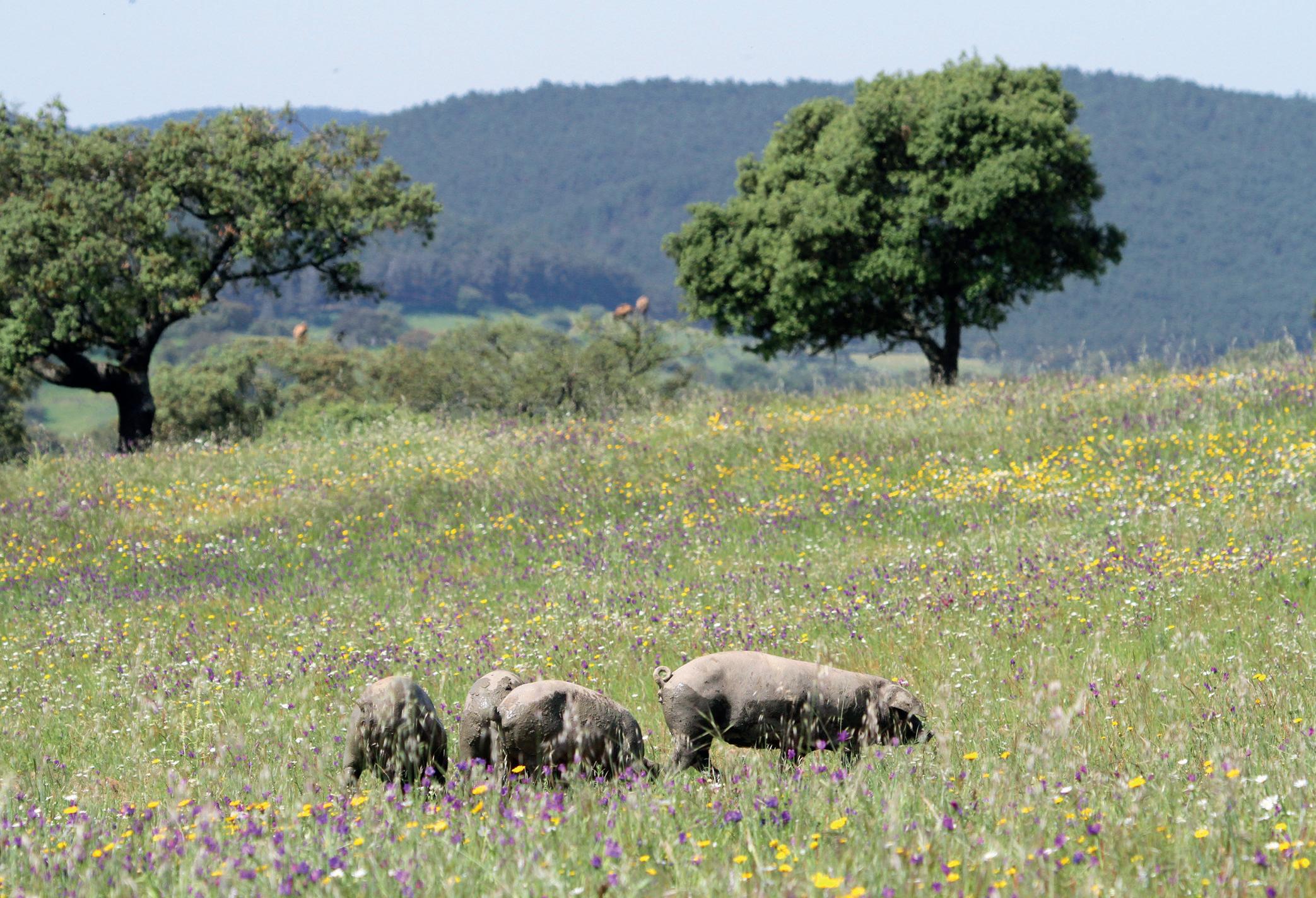
The Iberian ham (Jamón Ibérico) is the most typical product of the dehesa. It is world-wide famous as a delicacy and something the locals are deservedly proud of. One of the main centres of Jamon production is the Sierra de Aracena, in particular the town of Jabugo. To some meat lovers this town is the mecca of ham. The high quality hams are expensive, even in the region itself. This is a direct result of the process of fabrication: the local race of pigs (the black-skinned Ibérico swine) is a free-ranging pig that is held in low numbers in the dehesa and feeds on the acorns of the Holm Oaks. After the slaughter, the leg is salted and hung to dry for 1½ years before it is ready to consume. But then you have an exquisite product, which is locally sold as Jamón Ibérico de Bellota (de bellota meaning fed on acorns). This is the best and most expensive of them all (Similarly good is the paleta – the fore leg). It is also a product that supports the maintenance of the dehesa, so is the most organic, nature-friendly local meat that you can have. However, there are a range of other jamones on the market, which are cheaper.
A step down the ladder is the Jamón Ibérico de cebo, which comes from the same free-ranging Ibérico pig, but this time fed on maize, wheat and whatever is available. The Ibérico ham, by the way, is what abroad is sometimes called Pata Negra – black foot, referring to the skin of the Ibérico pigs. It is not a term that is used much in Spain.
Much cheaper is the Jamón Blanco, which comes from ‘pink’ pigs. As this meat can be salted and dried in the same way as the Ibérico ham, it looks the same, but the taste is different. Also, as these are not free-ranging pigs, the texture is different too. This ham is sold as Jamón Serrano, dried ham.
The Ibérico products are not limited to Jamón. There are wonderful chorizos, dried sausage (Salchichon ) and loins (lomo) as well.
This traditional system of land use, combining crop growing, grazing and forestry within the same area is unique. It is centuries old, boasts a wonderful biodiversity and has withstood the agricultural revolution of the 20th century (which has put so many nature-rich agricultural landscapes in Europe under such severe strain) relatively well, although there are problems with overgrazing and the abandonment of the land. In particular a fungal infestation that kills the trees, known as La Seca (the drought), is considered a major threat in the long term to the dehesa of the Sierra Morena.
In some parts of the Sierra Morena, the dehesa was cleared during the Franco days to make way for Eucalyptus or pine plantations. Such stands are monotonous and ecologically virtually dead.
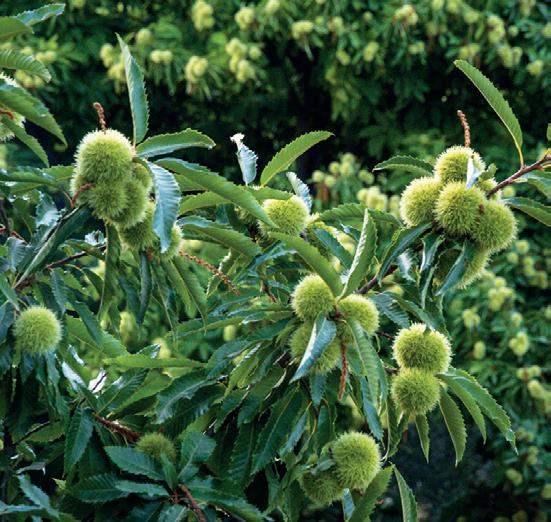
Ancient chestnut groves dominate the higher hills in the Sierra de Aracena. At present, the chestnut culture is experiencing hard times as the profits are too low to maintain the groves.
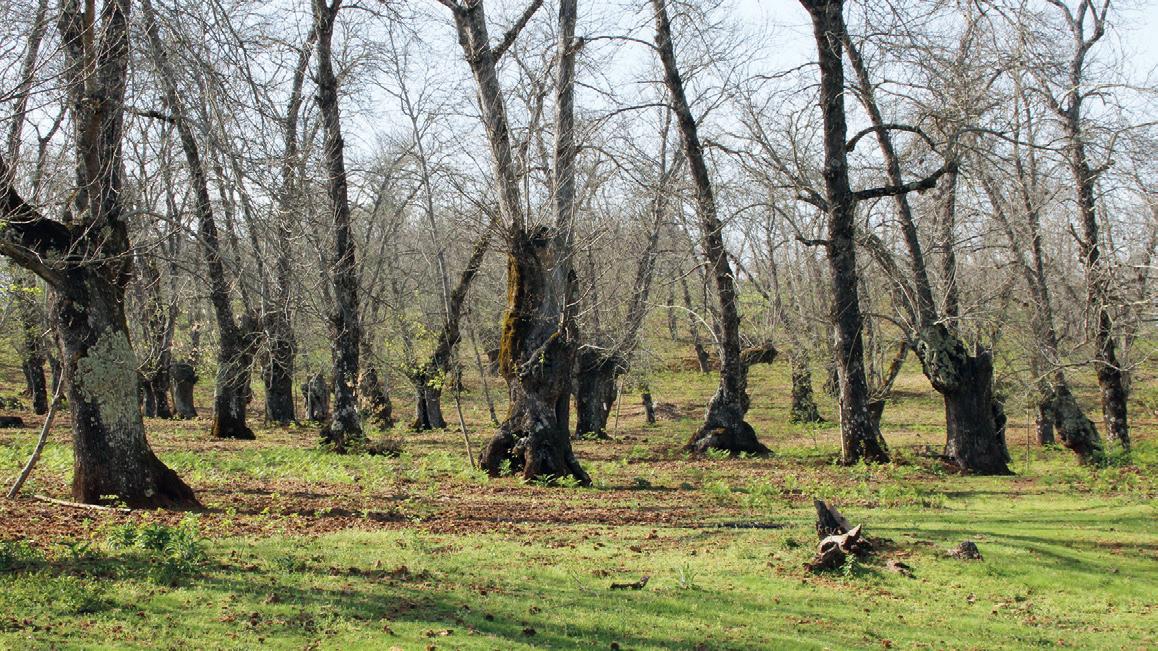
Roughly above 600 metres, the cork oak stands gradually give way to another type of oak: the Pyrenean Oak. Unlike the Cork and Holm Oak with their small and leathery leaves, the Pyrenean Oak has large and deeply lobed leaves which are shed in winter. Also in posture it is much more like the oaks of temperate Europe.
Pyrenean oak woods are now very rare in the Sierra Morena, particularly in the western section, as many have been replaced by chestnut groves. The chestnut groves are a typical feature of the Sierra de Aracena, where the largest chestnut woods of Spain are found. The village of Castaño del Robledo is even named after the chestnut (castaño) as it is surrounded by so many chestnut groves (route 6).
Thick in girth but low in height, the Sweet Chestnuts stand like squat giants on the high hillslopes. The chestnut culture is an ancient one, as are the groves themselves. On average, the trees are between 300 and 400 years old! In particular in October and November, when the leaves turn yellow and the chestnuts fall, they are beautiful.
The chestnut groves are under serious threat – the harvest of chestnuts has declined enormously and the market price for chestnuts is very low. The revenues from other traditional products from the groves (wood, charcoal, grazing pigs) is insufficient to cover the high costs of collecting the chestnuts and maintenance of the trees. Almost 50% of the groves are either neglected or abandoned.
The chestnut zone is like a cool island above the hot low hills of the Sierra de Aracena – a wonderful place for walks. The flora and fauna are different as well. The birdlife has a decidedly temperateEuropean slant to it. Lesser Spotted Woodpecker and Redstart are common birds, as are the more widespread forest birds like tits, finches, Nuthatches and Short-toed Treecreepers. Botanically, the groves are quite attractive, with large stands of the pretty Western Peony as their most typical hallmark.

Routes 10 to 12 and the sites A to E on pages 192-195 lead through the sandstone mountains in and around Los Alcornocales. The prettiest canutos feature on route 11 and 12 and sites A, B and C. Cork oak woods feature on all these sites and routes, but the dense woodlands of Algerian Oak are best on route 12. The most attractive heathland and low scrub is found on route 11 and on the peaks of Aljibe – El Picacho (site A).
The sandstone mountains and loamy hills of Los Alcornocales and bordering Campo de Gibraltar provide a wonderful, leafy wilderness that is unexpected this far south in Spain. Lush river valleys (locally called canutos) cut deep into the surrounding hills, which are covered in dense forests that blend into open cork oak woods and scrubland on the exposed slopes with shallow soils. The rockiest crests and recently burnt areas are reserved for an open mountain heathland that, like the canutos, is one of the area’s specialities.
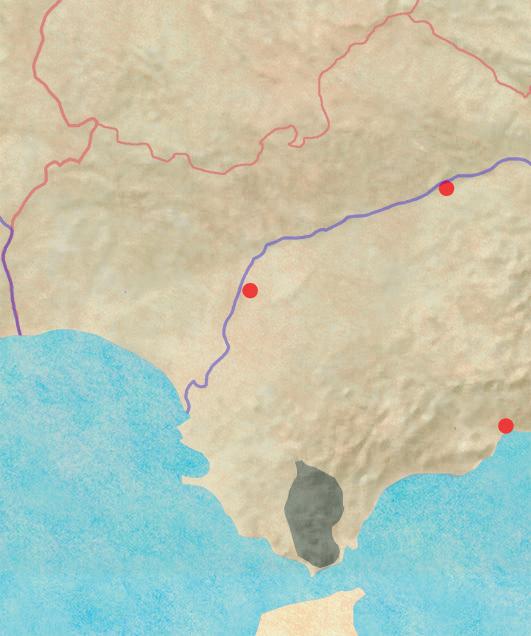
A stroll through the Alcornocales is a thoroughly pleasant experience. Along the rivers and in the woodlands you will find a large variety of wildflowers, while from up in the canopy you are greeted by the songs of Golden Oriole, Bonelli’s Warbler, Blackcap and Iberian Chiffchaff. It is also a great area to hang out on warm summer days, when the shade and water bring the essential coolness and a large number of southern dragonflies buzz along the streams (the Alcornocales form a dragonfly hotspot). Large,
After Franco died in 1975, nothing stood in the way of a liberal democracy. Spain joined the EU in 1986. From that time on, agriculture and nature conservation policies were dictated by the EU’s capricious laws, which are as often brilliant as they are counter-intuitive, contra-productive, contradictory or downright destructive. Huge areas of West Andalucía’s mountains and pretty much all wetlands were put under protection as Important Bird Area (IBA) and / or Natura 2000 site. One example is the dehesa landscape of the Sierra Morena, whose ecological value was formally recognised for the first time, thanks to European law. That same law became one of the first real threats to this ecosystem. New hygiene rules made traditional pig rearing difficult, while the prohibition of leaving dead cattle in the field (due to fears surrounding BSE – mad cow disease) threatened many of the region’s raptors with starvation. Modernised and subsidised agriculture threatens the birdlife of the fields and grasslands and the subsidised improvement of the road network pose new threats to mammals like the Iberian Lynx.
Parallel to these developments, an enormous interest is flowering among the Spanish in exploring their own region. Few places in Europe saw such an increase in local hiking clubs exploring new trails, while, judging from the many school classes on mountain trails, nature education takes a prominent role in the school curriculum. Grass-root initiatives to preserve or even restore habitats are plentiful while reintroduction programs for Iberian Lynx, Osprey, Spanish Imperial Eagle and Bald Ibis indicate a great awareness of the importance to preserve the Spanish natural heritage.
After Franco’s death, Spain rapidly put large swathes of land under protection. The Parque Natural de Sierra de Grazalema was established in 1977, Torcal de Antequera followed in 1978 and Laguna de Fuente de la Piedra in 1983. The year 1989 was an important year for the Parques Naturales – Bahía de Cádiz, Marismas del Odiel, Coto Doñana, Laguna Medina, Los Alcornocales, Sierra de las Nieves and Breña de Barbate all became either Parajes (protected landscapes) or Parques Naturales (nature parks) in that year.
In the first decade of the 21st century, many of endorheic lagoons became protected sites and the Parque Natural del Estrecho was established. Most
became Natura 2000 sites and the marshlands were designated Ramsar sites. The paper protection for most sites was in order. In its nature conservation, Spain adopted the ‘soft approach’, in which nature parks (with the exception of the Coto Doñana National Park) serve both the goals of nature conservation and the local economic development, based on green tourism and the branding of local and organic food. Andalucía was the first and most ardent autonomous region in Spain in adopting this strategy of conservation. Twenty-two parques naturales were created, many of which covered huge areas of which the overwhelming percentage of land was privately owned. In practice, very little changed in these areas in the daily routine of land use. However, the inclusion in the Natura 2000 network, plus the implementation of specific species recovery and habitat restoration plans do help to improve the natural areas. Furthermore, nature tourism (both national and international) has increased tremendously and does indeed put economic value to these areas besides the agricultural gain. Perhaps even more important, the increased interest in nature has led to a re-evaluation of the beauty and the ecological and historical value of these areas, both among the locals and the city folk who come to visit. The increase in hiking clubs, wikiloc trails (see page 241) and birders are testimony to this.
Notwithstanding all the conservation efforts and reintroductions, Andalucía’s natural areas face some serious conservation challenges. Many of them are directly or indirectly related to modern agriculture, tourism and climate change.
Both agriculture and mass tourism use up huge amounts of water. Since the 1990s, Spain has the greatest per capita water consumption in Europe. Much of this, particularly in Andalucía, is due to high levels of consumption by agriculture and tourism. The marismas and endorheic lakes are fed by rainwater, but the Lucíos and lagoons near Matalascañas, so important for being the only permanent wetlands in the area, are influenced by groundwater, which is depleted by heavy extraction for tourism and agriculture. The Huelva coast has become an important region for growing strawberries under plastic. The climate is ideal for producing strawberries early in the season. However, this crop consumes large amounts of water. Worse is the extraordinarily high consumption by golf courses which are watered permanently to keep the greens green. Often constructed at the expense of valuable dune systems and other coastal sites, golf courses can be considered the epitome of wasteful decadence and mindless destruction.
Over the last decades, various iconic species have been reintroduced in western Andalucía.
Osprey Sporadic breeding attempts, often on inland reservoirs, helped to prompt a reintroduction programme between 2003 – 2009, when young birds were released in Huelva (56) and Embalse de Barbate (73), where, by 2013, respectively 3 and 4 pairs were breeding.
Bald Ibis The historical status of this bird in Spain is obscure, but, under the name Cuervo Calvo (Bald Raven), it was last reported in 1616. The last viable wild population of this species in the world is in Morocco where 600 individuals remain. They breed well in captivity, so from 2003 onwards birds from Zoobotánico de Jeréz were reintroduced to the La Janda area. By 2014 two colonies had a total of 24 pairs and 78 free-flying birds.

Spanish Imperial Eagle Between 2002 and 2010 a total of 73 young eagles were released near La Janda, an established wintering site for the species. In 2010 a pair bred nearby for the first time in 50 years. Despite a high death rate (mainly from electrocution) a small population seems to be establishing itself.
Iberian Lynx By 2008 only two viable populations of Iberian Lynx remained – one in Doñana (24 – 33 adults) and the other in the Sierra de Andújar (67 -190 adults). By 2014 however, intensive conservation work has raised the total to 327 individuals and 50 captive-bred lynx have been reintroduced to the Sierra Morena and Montes de Toledo in Castilla–La Mancha, the Matachel Valley (Extremadura) and Guadiana Valley in Portugal. Large recovery projects for Iberian Lynx (here near Mazagon –route 4) seem to have saved this gracious feline from the gates of hell. The Iberian Lynx is still the rarest cat of the world.
Intensification of agricultural practises – the ‘green revolution’ that has destroyed so much of the beautiful and nature-rich countryside in western Europe – has left the mountains of western Andalucía relatively unscathed. The dehesa landscape, the karst plateaux and cork oak forests are not so easy to ‘improve’ (the term that is often used for the practises that boast the agricultural production at the expense of the natural world). The trees, often regarded as inimical to intensive agriculture, are vital for the preservation of the soil, which by nature retains water poorly. However, the products linked with the extensive use of the dehesas and
scrublands – wool, sheep meat, sheep and goat’s cheeses, honey, cork, wood, ham – are expensive to produce in comparison to the industrial meat production and intensive agricultural practises. Fortunately, there is a renewed interest in and appreciation of the original productos del campo, which taste so much better and are uniquely tied to the landscape. A worrying new use of the land is for wind turbines and solar panels. Spain, like many European countries, has developed the production of energy from wind and sun – two sources that are readily available in large parts of western Andalucía. This is a particularly thorny issue, as it is of pivotal importance that we change our energy use, making it hard to criticise the increase of renewable energy production (especially for tourists – be honest, did you arrive in Andalucía by carbon-neutral means?). However, there is no debate that wind and solar parks can have disastrous effects on the flora and fauna, not to mention the scenery. The windiest parts of the region happen to be the lowlands near Tarifa – right in the middle of the busiest stretch of the west European flyway of migratory birds. Evidence suggests the exact siting of turbines can be critical with most of the individuals being killed by a relatively small number of turbines. With this in mind wind farm companies employ observers (especially August – December) to alert control centres when flocks of birds (or even individual rare birds like Spanish Imperial Eagle) approach so turbines with the highest mortality rates can be shut down, thus reducing the risk of bird fatalities. Studies have been done on the effect on bats, which do not have the advantage of intermittent shut downs, with worrying results. At the time of writing several large wind farms off the Cádiz coast are being planned, the impact of which on birds and cetaceans remains uncertain.

Wind turbines in the coastal zone of Tarifa, right beneath the main migration flyway. This is a thorny issue – of course the transition to renewable energy is of vital importance to fight climate change, while at the same time, they have an adverse effect on migrating birds.

Naturally, species diversity is not evenly distributed across the world, but, generally, increases with higher temperature and moisture. Biodiversity hotspot is the technical term for an area with an exceptionally high number of plant and animal species. The tropical rainforests (warm and moist) are world famous for being natural treasure troves. Yet only few people know that the Mediterranean basin is also among the world’s biodiversity hotspots as well.
Within the Mediterranean region there are again specific areas that are much richer than others. Amongst the 10 Mediterranean biodiversity hotspots is the Sierra Baetica (the range that extends north-west from Cádiz to Valencia) of which roughly a third lies in our area. It is literally the top of the tops. Hence, the flora and fauna of western Andalucía is hugely diverse. The number of species far exceeds that of any similarsized area north of the Alps.
Much of this richness comes from its endemics – plants and animals that are confined to just a small area, be it the whole of the Iberian Peninsula or a smaller part like the Sierra Baetica. There are even some that are confined to a still smaller patch. Some plants are found exclusively in the Sierra de Grazalema. Obviously, such species have a special appeal. To understand the why behind this uneven distribution of plant and animal species, you need to look back into the past. When the Iberian tectonic plate got sandwiched between the much larger African and Eurasian land masses, the Pyrenees were formed in the north and the Rif-Baetic chain was pushed up in the south. These east-west oriented mountain chains became, quite literally, hurdles for the flora and fauna as species migrated north and south to the rhythm of the advancing and retreating ice.
During the warm interglacials, cold-adapted species found refuge high up in the mountains, where isolated from northern populations, they evolved into new species.
While the mountains acted as a refuge for cold-loving species, the warmthloving ones found them a formidable, or even impassable, barrier. For some species (e.g. lizards like the Large Psammodromus) the Pyrenees are such a barrier, confining them within the Iberian Peninsula. Yet others, such as the Spanish Psammodromus, found a way into France, but ground to a halt when faced with impassable barriers in the Alps and an inhospitable northern climate.
The Common Chameleon was most probably introduced by the Moors and has established several populations on the warm west coast.
It may come as a surprise, but the Strait of Gibraltar, dividing Europe and Africa, is not nearly such a barrier as the mountains. Many plants and animals of Andalucía are shared with the Moroccan Rif mountains. As these ranges are geologically one and the barrier of the Straits is a relatively young, populations of such species separated fairly recently. Add to this the fact that the climate of coastal Andalucía and coastal Morocco is similar and the distance between both coasts is not that great, then it is logical that there are strong resemblances between these regions. Examples of such Ibero-African endemics (as they are called) are Lorquin’s Blue, Atlantic Orchid and Green-flowered Narcissus. The term Ibero-African is a little deceptive here as many of the species given this label (most notably the plants) do not occur widely in either region, but are instead endemic to limited areas in both the Sierra Baetica in Iberia and in northern Morocco.
The Andalucían coast has also been ‘invaded’ by more widespread African species coming from much further south. These are invariably excellent flyers, such as dragonflies (e.g. Violet and Orange-winged Dropwings and Northern Banded Groundling are African species) and birds like Little and White-rumped Swifts.
Some of these African species clearly benefit from the very mild winter temperatures. The lowlands of western Andalucía stand out in Europe for having exceptionally benign winters. The Atlantic winds are to thank for this. This climate is peculiar enough to boast its own ecological ‘province’ – the Lusitanian region, which covers the lowlands roughly south of a line between Lisbon and Málaga. Examples of typical Lusitanian species are Portuguese Squill and Portuguese Sundew.
The climate also creates a haven for a final curiosity of the flora and fauna of western Andalucía: relicts of the Tertiary era. The Tertiary was the period preceding the ice ages. The climate in the Mediterranean basin was moist and subtropical – a climate that persists in our times only on Madeira and the Canary Islands (which are therefore living museums of the nature and wildlife of the Tertiary). However, secluded and moist valleys in West Andalucía (above all the canutos of the Alcornocales) have a somewhat similar climate and so boast a number of Tertiary species. Most of them are tree and rock dwelling fern species, which give these sites their brilliant ‘jungle feel’. These permanently moist and mild sites have become post-ice age refuges for some temperate European species too.
Paradoxically, you could see a north-European Roe Deer munching away on ferns which have their main distribution in the cloud forests of the Canary Islands!
Main biogeographical regions in western Andalucía

Lusitanian region
e.g. Portuguese Squill (Scilla peruviana)
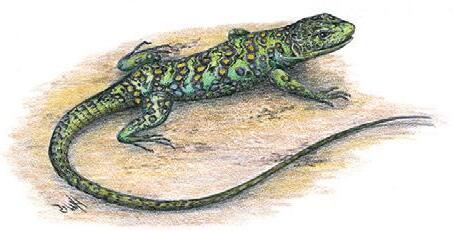
(West)-Mediterranean region
e.g. Ocellated Lizard (Timon lepidus)
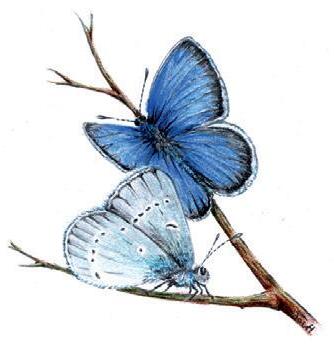
Ibero-African region
e.g. Lorquin’s Blue (Cupido lorquinii)
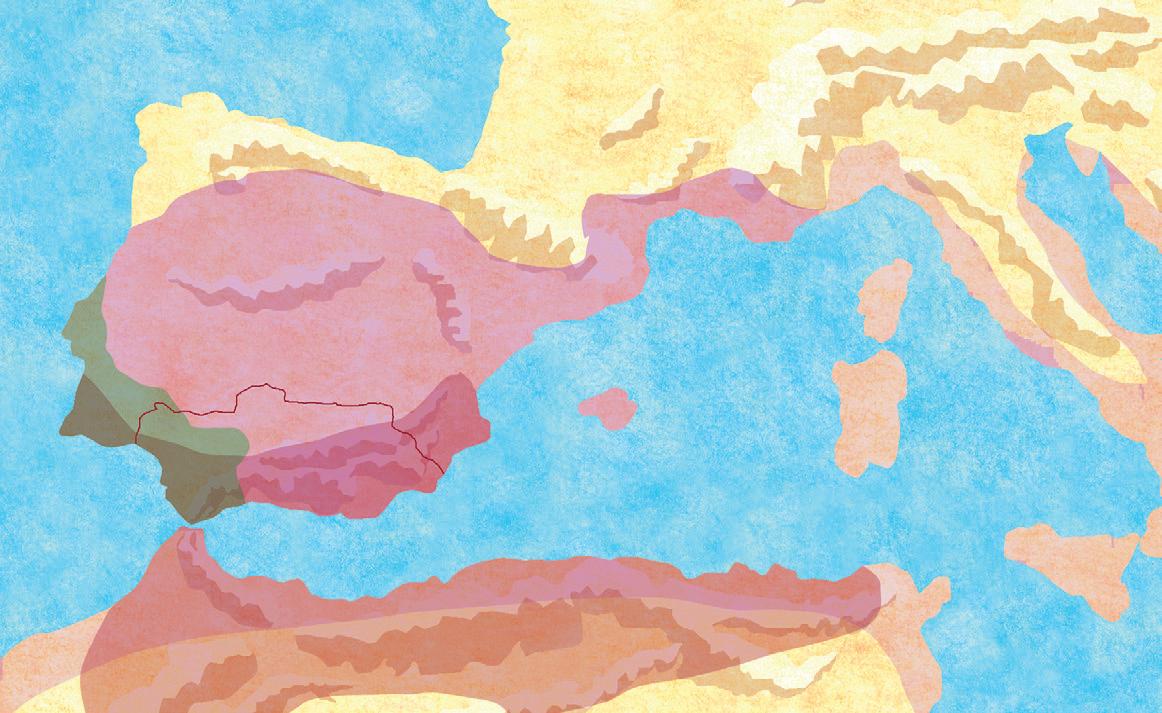
West Mediterranean region
Andalucía
Ibero-African region
Relict species or recent colonists from other biogeographical regions

Macaronesian species (Madeira, Canary Islands)
e.g. Hare’s-foot Fern (Davallia canariensis)
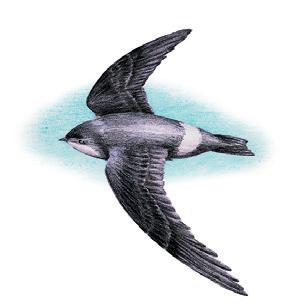
Recent African colonists
e.g. White-rumped Swift (Apus caffer)
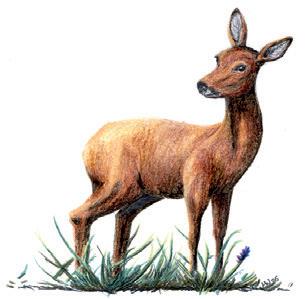
Temperate region species
e.g. Roe Deer (Capreolus capreolus)
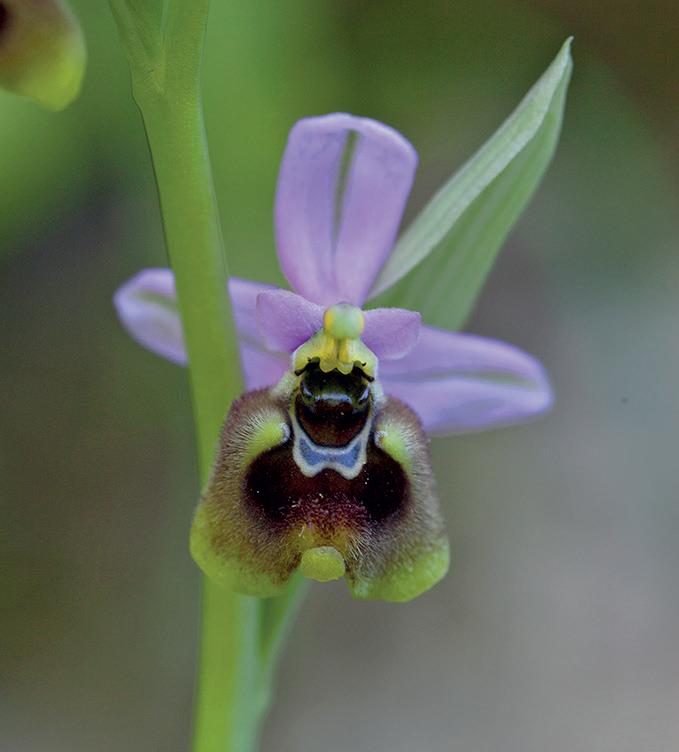
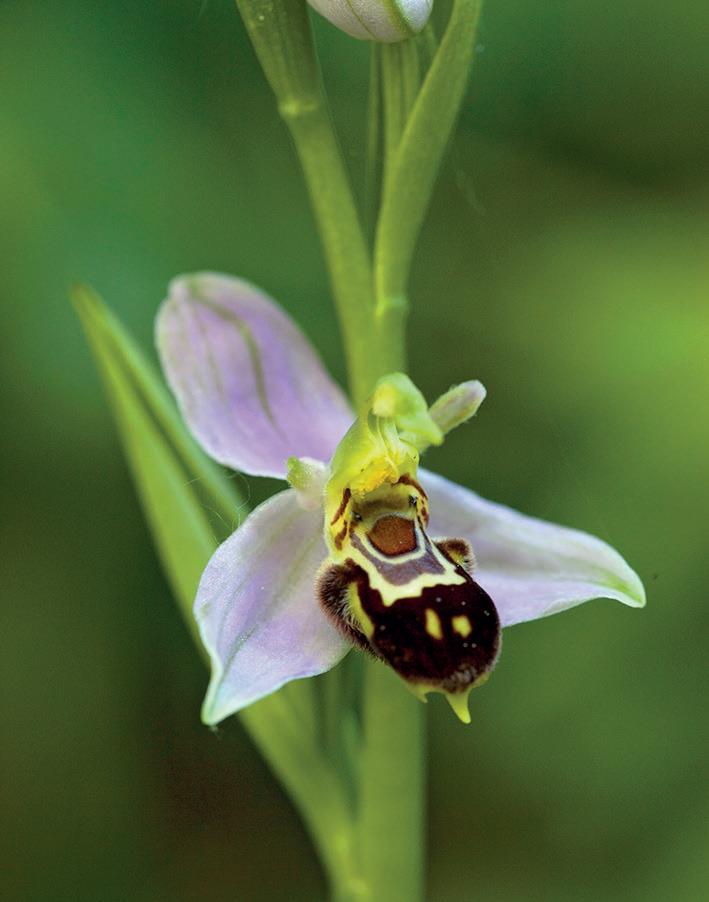
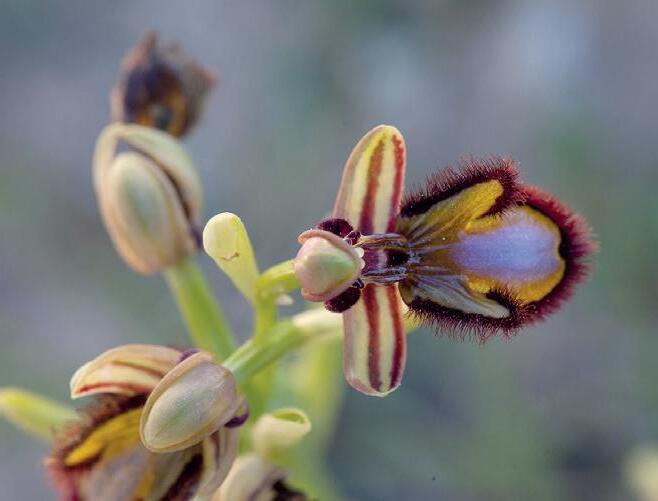
In contrast its relative, the Autumn Lady’s-tresses is quite common in woods in the lowlands in late September and October.
This leaves spring for all the other species of orchids. As with the rest of the flora, limestone boasts a very different orchid flora than the neutral and acidic soil types.
On limestone soils (i.e. Sierra de Grazalema, Las Nieves, Torcal and the coastal sierras east of Marbella), the most numerous spring species are the Spanish Early-purple Orchid (mostly in woodlands) Man and Nakedman Orchid and various species of the bee orchid genus (Ophrys). The most widespread of these is the Yellow Bee Orchid (p. 207). It grows commonly in roadsides, in karst areas and open patches in scrubland. It is frequently joined by the Mirror Orchid, which sports a shiny, bright blue lip lined with a brown hairy ‘beard’. Much rarer is the Lusitanian Mirror Orchid (O. lusitanica), which has a reddish ‘beard’ and a more rounded lip. Sombre Bee, Spanish Omega (the latter recognisable by the white omega sign on the lip) and Woodcock Orchids are frequent too. Less numerous but widespread (also away from limestone soils) is the Sawfly Orchid, which grows in grassy places. It sports hot pink petals and has the largest flowers of the Ophrys species in the area. It looks superficially like the Bee Orchid, which is quite common in the Alcornocales and Grazalema. In grasslands not far from the coast, the small Bumblebee Orchid (p. 187) can form large populations. It is most common in the grassy areas in the Campo de Gibraltar and Alcornocales, but occurs in the karst landscape of the Grazalema as well. The highlight of the region is the very rare Atlantic orchid, with its untypical, saddle-shaped lip. It is a species proper to the North-African Rif mountains, but grows in a few isolated spots in the Sierra de Míjas, Sierra Bermeja and Sierra de las Nieves.


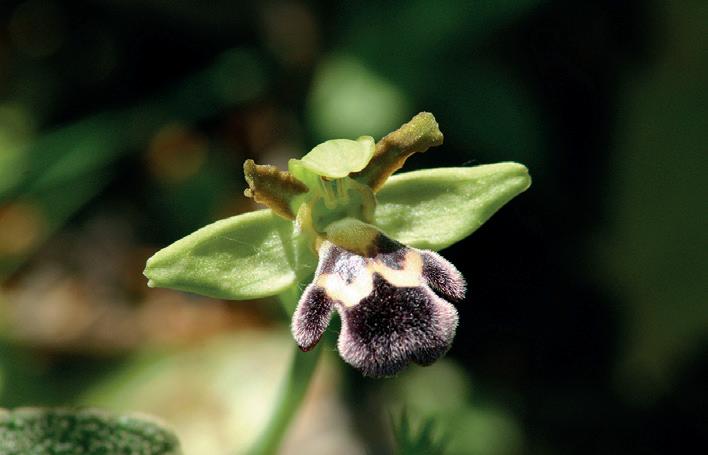
Los Alcornocales is a good area for orchids as well. Apart from the afore-mentioned Bee, Bumblebee and Sawfly Orchids, the cork oak woods are brightened by the purple spikes of Lange’s Orchid. It often grows alongside Tremols’ and Long-leaved Helleborine and the parasitic Violet Bird’s-nest, looking very much like a stout, purple asparagus until it opens its showy flowers. In moist areas in scrubland and grassland, you may encounter Looseflowered, Champagne and Heart-lipped and Common Tongue Orchids (the Small-flowered Tongue Orchid tends to grow on drier places). Moving into the lowlands of Cádiz and the Guadalquivir basin, the number and diversity of orchids drops rapidly. Only the more widespread ones like Sawfly, Yellow Bee, Woodcock and Mirror Orchids can still be found here and there in scrublands. In the lowlands they flower earlier in the year, not infrequently starting to bloom already in the final days of February. The hills of the Sierra Morena are richer, although the uniform and acidic soils are no match to the splendour of the Sierra Baetica. Nevertheless, it is well possible to see good numbers of Tongue and Champagne Orchids (again in wet spots) and Sawfly Orchid (on the richer soils). Heading into the more shady parts of the hills you should be able to find Violet Bird’snest Orchid, Narrow-leaved Helleborine and Dense-flowered Orchid, plus two species that are rare or absent elsewhere: the first is the yellowflowered Sicilian Orchid (Dacthyloriza markusii ) – one of only two representatives of the Dactylorhiza -orchids which are so common in northern Europe. The second is the small Conical Orchid. Look for these in the cork oak dehesas and chestnut forests in the higher parts of the Sierra. Apart from the above, there are a number of other species which occur uncommonly in western Andalucía. On our website you can download a checklist of all the orchids of Andalucía.
Good numbers of bee orchids (Ophrys) occur in the Sierra Baetica. From left to right:
Sawfly Orchid –widespread though usually in low numbers throughout the mountains.
Bee Orchid – locally very common, particularly in roadsides in the Alcornocales.
Mirror Orchid –locally common in grassy patches in light woodland on limestone (together with Yellow Bee; page 207).
Sombre Bee Orchid – locally common in grassy patches in the limestone mountains.
Spanish Omega Orchid – as Sombre Bee but generally less common and more localised.
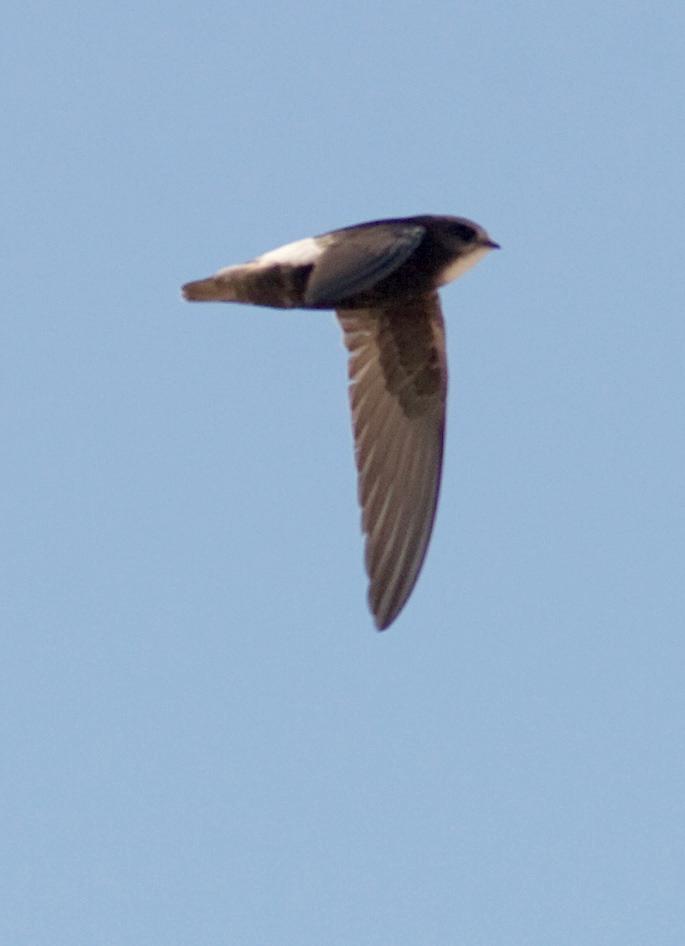
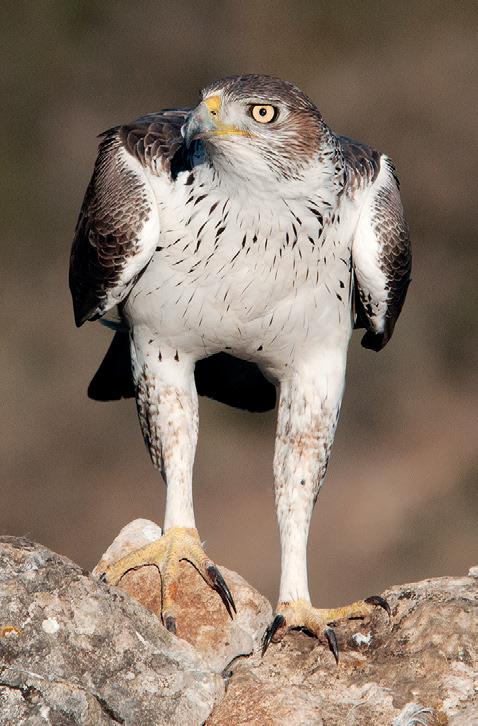
Western Andalucía holds the only European population of Little Swift (top) and has a large population of Bonelli’s Eagle (bottom).
Lesser Kestrel Some of Spain’s largest colonies of this beautiful and scarce species are found here.
Bonelli’s Eagle Western Andalucía holds Europe’s largest population of this rare species.
Spanish Imperial Eagle
The region covered by this book holds around 45 pairs of this rare raptor. It is endemic to the Iberian Peninsula.
Azure-winged Magpie
The region holds a fairly large population of this local, beautiful and sought-after endemic.
Marbled Duck Andalucía holds most of the European population of this rare and threatened bird.
Red-knobbed Coot This is a widespread bird in sub-Saharan Africa, but in Europe it only occurs here and in a few other sites in Spain. It is in sharp decline.
Little and White-rumped Swifts These two swifts are recently arrivals from Africa. Little is restricted to Western Andalucía (mainly in Chipiona). White-rumped is more widely, if thinly, spread and reaches Extremadura and Portugal. White-headed Duck Western Aldanulcia holds a fairly large population of this rare and threatened bird.
Raptor passage There are tens of thousands of migrating Griffon Vultures, Egyptian Vultures, Honey Buzzards, Black Kites, Booted and Short-toed Eagles.
Steppe birds Small but significant numbers of Great and Little Bustard, Black-bellied and Pin-tailed Sandgrouse, Collared Pratincole and Black-winged Kite are found in Western Andalucía. Audouin’s Gull This rare and endemic gull of the Mediterranean basin is common near Tarifa.
Flamingos Europe’s second-largest Greater Flamingo colony breeds in the region.
common, but they are there and can be tracked down with some dedication and a bit of luck.
Because of the short distance to Africa, the region acts as a major bottleneck of migration on the western flyway – one of the two busiest routes for migratory birds. Hence, western Andalucía, more specifically the area between Gibraltar in the east and Coto Doñana in the west, is among the very best areas for watching migratory birds. In autumn, it is quite common to see wheeling ‘kettles’ of raptors and storks gaining altitude for the big crossing southwards (in spring northbound birds tend to arrive in fewer
numbers and at a much lower elevation, but on a broader front). Patches of scrub and woodland at the coast are full with songbirds, waiting for the best moment to make the leap down to Africa (in autumn) or are recovering from the breezy trip over the sea (in spring). The marismas of the Doñana are full of northern waders, while the Guadalquivir acts as a busy ‘route du soleil’ for terns, gulls and waterfowl.
Winter is, for birdwatchers, not such a rewarding time, but even this is relative and while fellow enthusiasts are freezing further north, the daytime temperatures can make you feel smugly warm! With its mild winter climate and access to plenty of food in the woods, fields and dehesas, western Andalucía is hugely important for wintering birds. The paramount importance of Coto Doñana as a wintering area for waterfowl is rather evident, but the dehesas and olive groves attract masses of northern birds as well, in particular finches, thrushes, Chiffchaffs, Blackcaps, pigeons and Cranes. Rocky terrain even houses a few birds of the high mountains in winter, such as Alpine Accentor. A small but growing number of migrant raptors – Lesser Kestrel, Black Kite, Booted and Short-toed Eagle – remain in winter as do larger numbers of White Stork. In all, around 400 species of bird have been recorded in western Andalucía of which a little under 50% breed (some irregularly or in very small numbers), with another 90 odd turning up fairly regularly as migrants or as winter visitors. Raptors pass through in the tens of thousands as do uncountable numbers of smaller migrants. So brace yourself for some serious birding! On page 244 there is a bird list with the best sites and routes for each species. Here we go deeper into the birdlife of the different areas of western Andalucía.

Master in disguise during the day, the Red-necked Nightjar is best observed at dusk. In open pine and oak woods with some shrubs, they can be numerous. From late April, listen for the typical ka-TOK, ka-TOK call.
About 136 species of birds breed in the Coto Doñana National Park on a regular basis. Many more visit, either as a wintering species or as a passing migrant, as the Coto is conveniently close to the migration route over the Strait of Gibraltar to West Africa.
It is during these periods of migration that birdlife is at its most diverse, although in terms of numbers, winter beats all other seasons.
The annual winter census in Doñana has more than once exceeded the 1.2 million mark. The birds are drawn to the area for the food: the marshes (and rice fields) offer enormous amounts of roots, grain, bulbs, mosquitofish and macro-invertebrates (the larger species of insects, shrimp, mollusks, etc).
Many ducks winter in Doñana, mostly belonging to the familiar species that are found across western Europe, like Wigeon, Teal, Mallard, Shoveler and Pintail. Among them are a varying number of Mediterranean species like White-headed Duck (variable, averaging 250) and smaller numbers of Marbled Duck (<50). About 70,000 Greylag Geese gorge themselves on the Sea Club-rush roots each winter. This may not be as impressive to the visitor from northern Europe, but their dining habits are. The geese eat sand after their banquet in order to grind the hard and otherwise indigestible roots. Stumbling upon a group of geese gobbling up sand in the middle of the desert-like sand dunes is one of the stranger birdwatching experiences of the Doñana. Other wintering birds include tens of thousands of Greater Flamingos, Coots and waders like Avocet, Lapwing, Redshank, Black-tailed Godwit, Little Stint, Dunlin and Snipe, plus Osprey.
Most birders visit the marshes in April and May. The temporary marismas are usually flooded at this time of year (see page 30). The quantity of birds all depends on the water level with the best condition being when the marismas are only just submerged. At such times, groups of Flamingos, Spoonbills and herons can be seen in the hundreds, or even thousands,
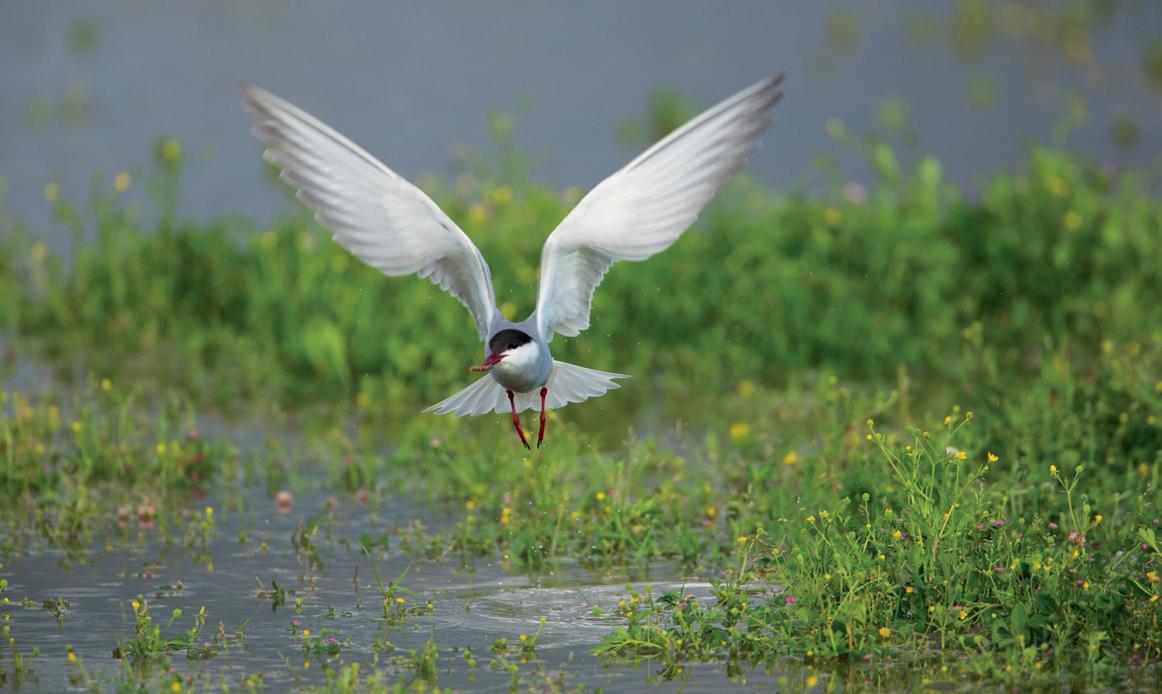
mixed with huge groups of both breeding and migratory waders, above all Black-winged Stilts and Redshanks (breeding) and migratory Spotted Redshanks, Greenshanks, Wood Sandpipers and many more. Collared Pratincoles wheel overhead, sometimes in large flocks, while Little, Gullbilled, Whiskered and migrating Black Terns patrol the flats. Variable numbers of Slender-billed Gull breed (over 500 pairs in good years) and small numbers of Caspian Tern winter (although Cádiz Bay is better for this species). The more saline parts of the marsh (e.g. the saltpans at Algaida) attract Dunlin, Little Stint, Curlew Sandpiper and Grey, Golden and Kentish Plovers (with the latter breeding).
The lagoons outside the core area of Doñana, as well as the lucíos within the marismas are fed with fresh water. This shows strikingly in the birdlife. The rich aquatic vegetation of reeds and bulrushes are home to Pochard, Red-crested Pochard, Gadwall, Shoveler, Little Grebe and Purple Galinule. It is in these sites that you have the best chance of finding some of the rare species of wildflowl, like the essentially East European Ferruginous Duck, which has an isolated population here. Locally, the globally threatened Marbled Duck breeds as well. The freshwater sites sustain a taller vegetation with tamarisks and, at higher ground, Cork Oaks. This is the perfect breeding habitat for herons, storks and Spoonbills. These birds often breed in large colonies consisting of several species. Doñana is a stronghold for all breeding herons: Great Bittern, Little Bittern, Night Heron (2,500 pairs), Squacco Heron (200-400+ pairs), Cattle Egret, Little Egret (up to 6,000 pairs in wet years), Great White Egret (30 breeding pairs in 2011 and 300-400 in winter), Grey Heron (around 1,200 pairs) and Purple Heron (up to 3,000 pairs in wet years).
The Cattle Egret was originally an African species. It arrived here as early as the 16th and 17 th centuries, but until the 1950s it was pretty much restricted to the marshes of Huelva, Seville and Cádiz. Then it rapidly expanded across much of Spain, into France (1968) and has recently started to breed in the UK and the Netherlands. Although a slow starter, it is the most successful of the African immigrants, which can be seen all over western Andalucía, but is truly abundant from the Portuguese coast to Gibraltar.
The Glossy Ibis is another success story. It became extinct in Coto Doñana in the early 20th century (thereby disappearing from Spain as a breeding bird), but returned in the 1990s. Its population is rapidly increasing (now over 5,000 pairs) making it a common bird in the extensive wetlands and rice paddies in the northern and eastern part of Doñana.
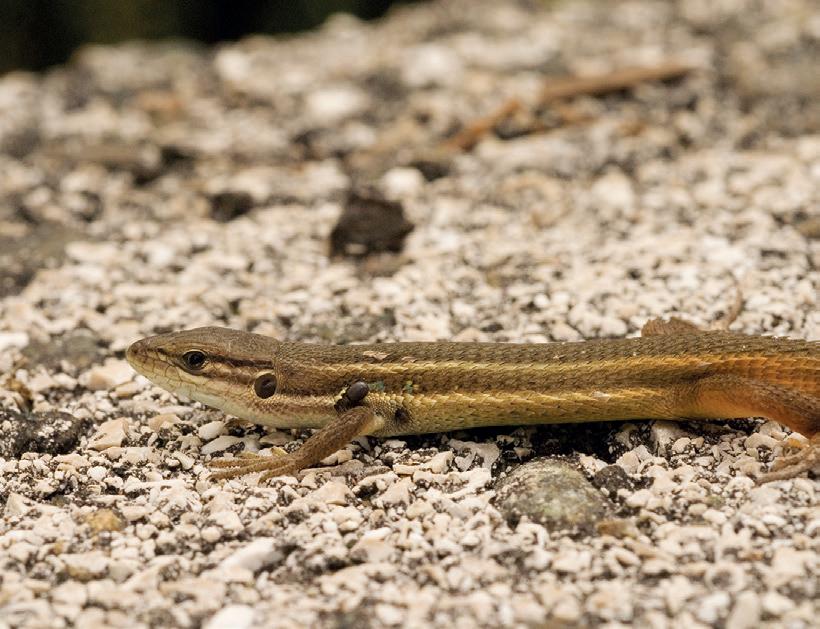
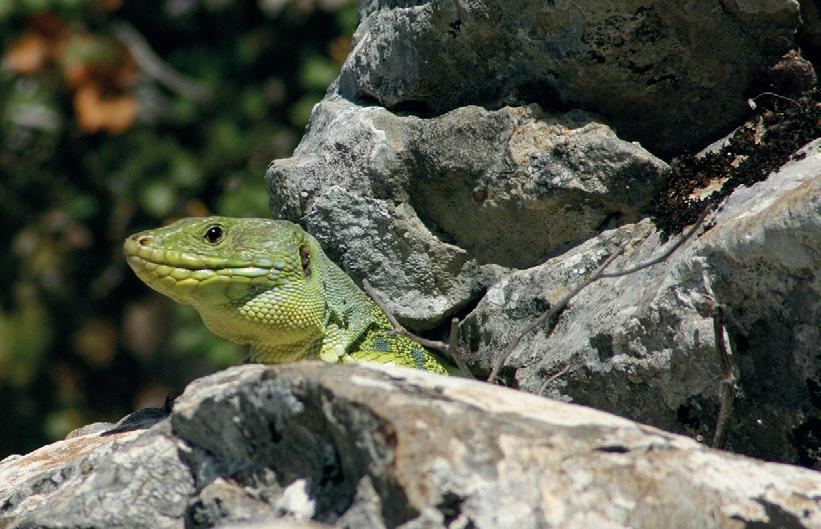
The Large Psammodromus (top) is the most common lizard in the area. Its plain olive back with two cream stripes on either side of the body makes it easy to recognise.
The large Ocellated Lizard (bottom) frequents dry areas like karst and scrubland. With its agility and speed, its bright colours and a length of up to 80 cms, it is an impressive sight.
Lizards are the most frequently encountered reptiles. Particularly abundant is the Large Psammodromus. This species is readily recognised by its plain olive back with two cream stripes on the back that extend from the head all the way to the tail. Large Psammodromuses are your frequent company in scrublands, dehesas and light woodlands where they live among the leaf rubble and the vegetation. They often occur together with ‘wall lizards’, of which, according to recent taxonomic insights, three species occur: Carbonel’s (within our area only in Coto Doñana) Geniez’s (in the Sierra Morena) and Vaucher’s Wall Lizard in the rest of the area.
Another lizard you are likely to see when you venture into the more sandy areas (especially the Doñana region) is the Spiny-footed Lizard. This small lizard has strikingly yellow flanks and 6 yellow to white stripes on the greyish brown back. The Spiny-footed Lizard is the only European representative of the Acanthodactylus lizards – a large genus of desert lizards, abundant in the Sahara. The smallest lizard of the region is the Spanish Psammodromus, a rather rare, secretive and hard to find lizard that prefers rocky habitat. Much easier to find is the Ocellated Lizard. Anyone who spends much time in Andalucía will at some point see a large, bright-green flash dashing across the road. That’s him – a big, agile lizard of up to 80 centimetres. The males are handsome beasts, bright green with blue spotted flanks. The females are smaller and duller. Ocellated Lizards are rather shy and with reason. There is a score of predators who find them an ample meal. They were even a favoured ‘bushmeat’ in the poor, rural regions of Spain. If you keep your eyes open on your rambles and
don’t rush along your trail too fast, you have a good chance of seeing them at one point or another. The best areas are warm and grassy, with rocks or loose soil nearby.
You are also likely to encounter geckos during your stay in Andalucía, at least when the evenings are warm. These nocturnal animals live in rocky areas, but have found in houses and sheds a great artificial habitat. Being insectivorous, they take advantage of the street lights which attract lots of moths. On warm evenings, you can see them on the walls near (or even inside) the lights (p. 227).
There are two species of geckos in Andalucía. The most common one is the big and bulky Moorish Gecko, which has large disc-like finger-tips, with which it is able to walk over walls and ceilings. The other is the Mediterranean House Gecko, which in Andalucía is largely confined to the coast. It is more slender, with small adhesive finger-pads with a single central nail sticking out.
This is where the list of fairly easily encountered reptiles ends. However, deep in the scrub, woods and marshes of Andalucía, there are many more reptiles, for which luck or dedicated searching is required to find them. Among them are terrapins, tortoises, skinks, snakes, worm-lizards and even a chameleon.
The two species of skink that occur in Andalucía are easy to tell apart, but not easily found. Both Bedriaga’s Skink (with a thick, smooth-scaled body and relatively small limbs) and western Three-toed Skink (with a thin, long and striped body and tiny, nearly invisible limbs) prefer grassy areas or low scrub with open patches.
The two worm lizards – Iberian and Maria’s – are strange inhabitants of the area. Both closely resemble large, shiny earthworms. The first is found in the east of our region and the other in the west. Like their namesake, they live a subterranean life but can sometimes be found under rocks. Whenever excavation works are done (e.g. for road building) it becomes clear that worm lizards are actually quite common.
There are eight species of snake in western Andalucía, of which two –Viperine and Iberian Grass Snake – are aquatic. They occur in all kinds of fresh water. The Viperine Snake is very common and is relatively easy to see at the edges of small rivers in the hills and in the marshes of Coto Doñana and surroundings. Iberian Grass Snake is much rarer, although it occurs sparingly throughout the lowlands and often hunts away from water.
The back patterns are a good way to tell the scrubland snakes apart: the coinpattern is typical for for Horseshoe Whip Snake, the ladderpattern for Ladder Snake and the zigzag is reserved for Lataste’s Viper. Snakes with a uniform, grey back can be distinguished by looking at the head shape and pattern.
The other six are more at home in the fields, scrublands and open forests. Four of them – Horseshoe Whip, Ladder, False Smooth and Montpellier Snake – are widely distributed, occurring in all sorts of habitat. They are not difficult to tell apart. The back and head patterns are striking in Horseshoe Whip Snakes (beautiful brown ‘coins’ on the back), Ladder Snake (long parallel lines in adults and thick bars on juveniles) and False Smooth Snake (black collar and dark crown with a plain greyish body). The latter prefers loose soils (sand, clay, loose rock) in which to hide. It does this frequently – subterranean Worm Lizards are an important prey – so is not often seen. The fourth of the common scrubland snakes is the Montpellier Snake. It is the largest in the region, best recognised by its plain grey colour and comparatively large, staring eyes underneath a protruding ‘eyebrow’. It is the only snake that climbs well.
The final two species of snake – Southern Smooth Snake and Lataste’s Viper – are confined to dry rocky places with patches of scrub. The Southern Smooth Snake closely resembles the False Smooth Snake, but is largely confined to the mountains, especially the Alcornocales and the karst Sierras of Grazalema and las Nieves. It shares its habitat with Lataste’s Viper, but this species also occurs in sandy areas in the Doñana. The Lataste’s Viper is a small but beautiful creature with a pointed nose and bold zigzag on the back.
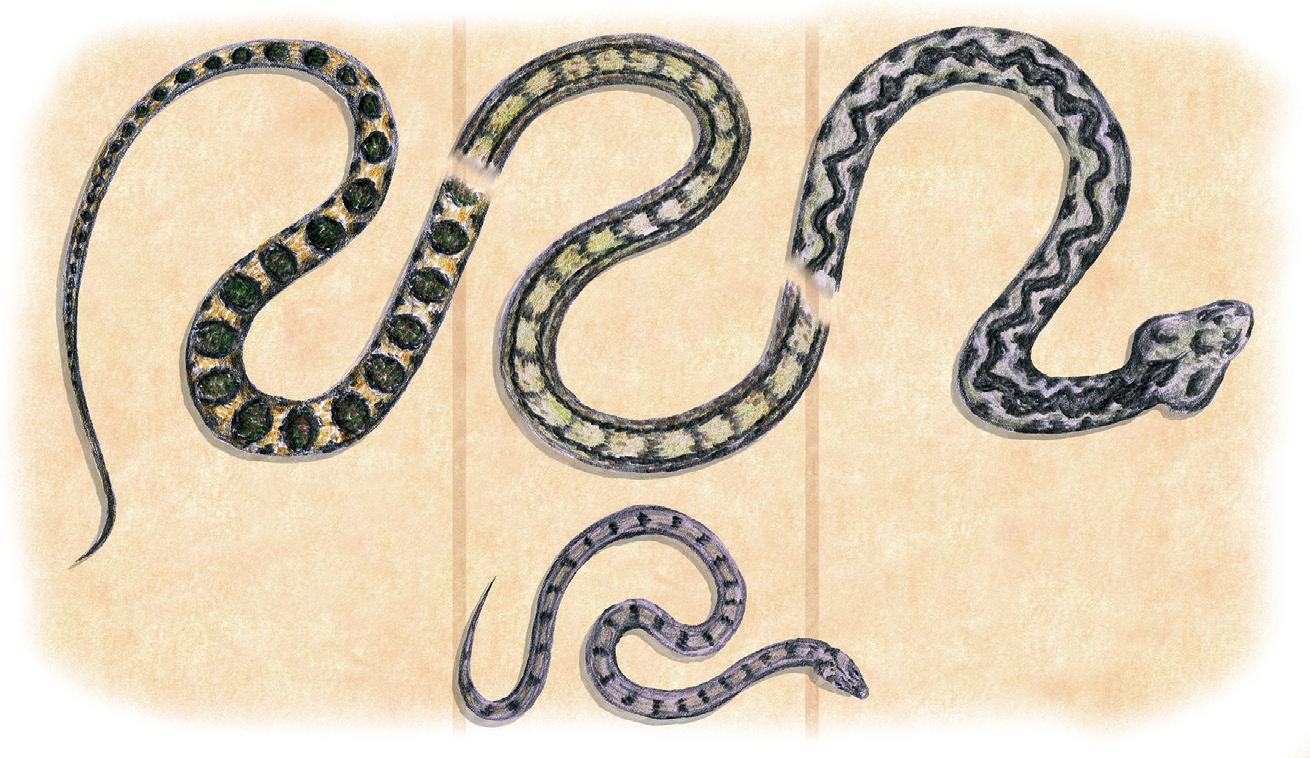
All of these snakes are potential food items for Short-toed Eagle whose presence, counter-intuitively, increases the diversity of the snake fauna. By preferentially preying on larger snakes, which in turn hunt their smaller cousins, the eagle helps to create more varied populations of snakes.
Perhaps the most spectacular reptile of the region is the Common Chameleon (p. 70), which occurs in hot dry lowlands, mostly at the coast, with lots of broom bushes and scattered pines. Chameleons are superb animals, belonging to an ancient group of highly specialised lizards (Chameleons fossils have been found in Germany and the Czech Republic that date back 23 million years). Their eyes can rotate independently from one another, scanning their entire environment without moving their heads. This stiff-necked appearance, combined with its slow but somewhat insecure, rocking movements, gives it the appearance of an old man in dire need of a good massage. This sluggishness goes once a Chameleon has spotted a prey (usually a fly, grasshopper or some other insect) – its tongue, twice the length of its body is launched within a tenth of a second. The Common Chameleon is above all a north-African and Middle Eastern species that has a patchy distribution from the Western Sahara to Iran. In Europe it is restricted to the Iberian south coast, Malta, Apulia and a handful of Greek Islands. In many if not all of these places, it was introduced. In Spain it is thought to have been introduced in the Middle Ages by the Moors.
Two species of terrapins and one tortoise occur in western Andalucía, of which only the Spanish Terrapin (also called Spanish Pond Terrapin) is frequently encountered. It occurs in all types of waters, even polluted ones. It is also the terrapin that you hear plunging into the water when you approach a river in the Sierra Morena. The European Pond Terrapin, which is readily distinguished by its dark grey (rather than dull green) colour and spotted (rather than striped) neck, is quite rare, the population scattered and in decline. It prefers well vegetated, clean standing or slowly streaming water and its decline is a direct result of the disappearance of suitable habitat. Where it occurs, it usually lives alongside the Spanish Terrapin. The occurrence of Spur-thighed Tortoise in Spain has long puzzled biologists. The Spanish populations are small and restricted to the dunes of Coto Doñana and the south-east of Spain and the Baleares. Recent DNA analysis has revealed it was also introduced, during Moorish times.
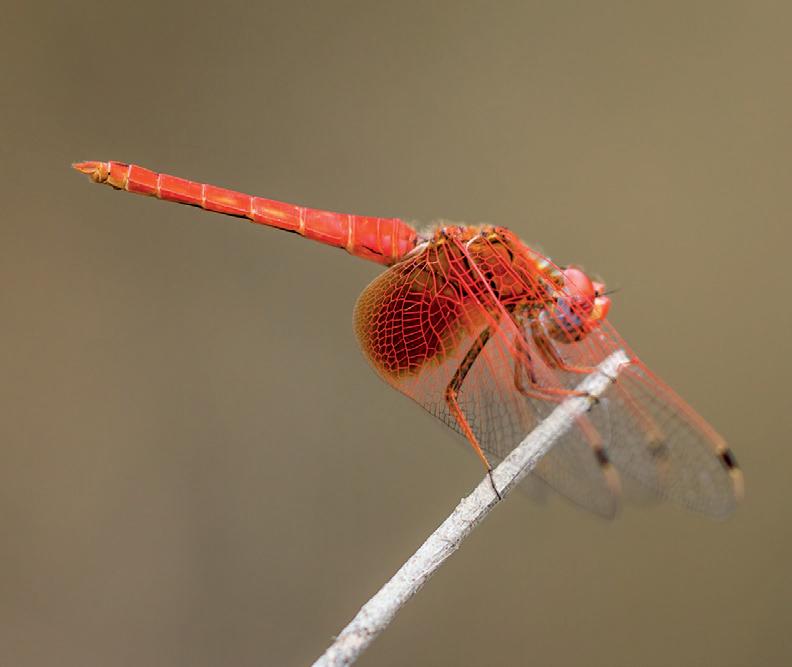

Two of many attractive odonates:
the Orange-winged Dropwing (top) is a recent coloniser of Andalucía, coming from Africa.
The Dark Spreadwing (bottom) is a localised species of brackish marshes, such as Coto Doñana.
from the hills, like the Río Hozgarganta (site B on page 192) and Río Guadiaro are among the hotspots of the region, with highly attractive species as White and Orange Featherlegs, Green Hooktail and Ringed Cascader. The latter prefers fast-flowing sections of rivers, while another black-and-yellow dragonfly, the very rare local Splendid Cruiser, seeks out the calmer stretches. Where these rivers flow into the lowlands and are freed from their tourniquet of narrow valleys, the water flow slows, offering habitats to a trio of recent African colonists. The Northern Banded Groundling (recently ‘split’ from its southern counterpart) was the first to arrive in the 1960s and is found locally, in open, sandy or pebbly places, where cattle are nearby. The males of this species are striking, with a black body and thick black bands on the wing. As its name suggests it flies close to the ground where it is easy to confuse the insect with its shadow. Engagingly, they often follow you around hoping you’ll disturb small insects on which they prey. Next to arrive, in the late 1970s, was the Violet Dropwing whose bright violet males are stunningly beautiful. It has rapidly spread north, reaching France in the 1990s. It flies from the first half of May. More recently (2007), the superb Orange-winged Dropwing was found in the Río Hozgarganta and now it is colonising the Andalusian rivers with gusto!
The coastal lowlands – Coto Doñana, surrounding endorheic lagoons, Laguna de Fuente de Piedra, La Janda and the marshes near Málaga – form another great area with many dragonflies from Africa. The most common species here is the Red-veined Darter, a species that is widespread in southern Europe. It can occur by the thousands. It often flies together with the bright red Broad Scarlet and locally with Northern Banded Groundling. Over the marismas, the Iberian Bluetail and Small Spreadwing are very common, joined in spring by the Dark Spreadwing, a species of damselfly that is unique for being able to live in brackish marshes.
In summer, the marismas and channels in the lowlands are home to a number of skimmers. The Black-tailed Skimmer (common throughout
most of Europe) is the most numerous, but locally, the southern Epaulet Skimmer and Long Skimmer can be found as well. Three species of emperor dragonflies frequent the freshwater lakes and ditches. The Lesser Emperor is the most common and widespread, but be aware of confusion with Blue and Vagrant Emperors, which are both present as well. The small, glossy Black Percher is yet another species of African origin that is found locally in temporary lagoons (e.g. Lagunas de Puerto de Santa Maria; route 8).
Sadly, there are indications that the dragonflies in Doñana are not faring well as they are declining both in number and variety. The reasons for this are the gradual drying out of the region’s lagoons as a result of irrigated farming and climate change, which is believed to cause the disappearance of the species that require sites with year-round water. Another threat are invasive alien species (especially American Crayfish) that prey on the larvae of the dragonflies.
In comparison with the Alcornocales, the coast of Tarifa and Doñana, the rivers of the Sierra Morena support only a modest dragonfly fauna, with Small Pincertail, Lesser Emperor, Orange Featherleg and Broad Scarlet being the main species.
Some attractive dragonflies and damselflies of western Andalucía
Alcornocales Western Demoiselle (Calopteryx xanthostoma ), Copper Demoiselle (Calopteryx haemorrhoidalis) White Featherleg (Platycnemis latipes), Orange Featherleg (Platycnemis acutipennis), Common Goldenring (Cordulegaster boltonii ), Splendid Cruiser (Macromia splendens), Orange-winged Dropwing (Trithemis kirbyi ), Western Clubtail (Gomphus pulchellus), Pronged Clubtail (Gomphus graslinii ), Green Hooktail (Paragomphus genei ), Western Spectre (Boyeria irene), Ringed Cascader ( Zygonyx torridus), Large Pincertail (Onychogomphus uncatus), Orange-spotted Emerald (Oxygastra curtisii )
Doñana and surrounding lowlands Dark Spreadwing (Lestes macrostigma ), Small Spreadwing (Lestes virens), Common Winter Damselfly (Sympecma fusca ), Migrant Spreadwing (Lestes barbarus), Migrant Hawker ( Aeshna mixta ), Vagrant Emperor ( Anax ephippiger ), Blue Emperor ( Anax imperator ), Lesser Emperor ( Anax parthenope), Broad Scarlet (Crocothemis erythreaea ), Common Darter (Sympetrum striolatum), Red-veined Darter (Sympetrum fonscolombii ), Southern Darter (Sympetrum meridionale), Black Percher (Diplacodes lefebvrii ), Black-tailed Skimmer (Orthetrum cancellatum), Epaulet Skimmer (Orthetrum chrysostigma ), Long Skimmer (Orthetrum trinacria ), Violet Dropwing (Trithemis annulata ), Northern Banded Groundling (Brachythemis impartita )
Superb birdwatching.



Habitats: fields, salt pans, marsimas, river, umbrella pine forest
Selected species: Spotted Yellow Sunrose*, Collared Pratincole, Whiteheaded Duck, Marbled Duck, Greater Flamingo, Slender-billed Gull, Caspian Tern, Pin-tailed Sandgrouse, Booted Eagle, Lesser Short-toed Lark, Spectacled Warbler, Rufous Bush Robin, Fiddler Crab,Long Skimmer, Dark Spreadwing
Although ecologically part of Coto Doñana, the salinas (saltpans), wetlands and woodland around Bonanza lack the iconic status of the National Park. That is easily forgotten, though, once you start birdwatching! Many of the species for which the Doñana is famous can be found as easily here. The route covers areas of saltpans, small lagunas, open wetlands, farmland and pine woods, making for a diverse number of species.

Starting point Trebujena.
Take the eastern most exit off the A471 for Trebujena on to the C441a (GPS 36.881294, -6.155033) and immediately turn right onto a minor road. The road turns left. Ignore the turning on the left after 1 km and continue straight on. This road later bends to the left to the village of Trebujena, where, at the cemetery you turn left again and make a triangle.
1
The area enclosed by this triangle and nearby holds the highest concentration of Rufous Bush Robins in Spain. They can usually be seen surprisingly easily (especially in the morning from May onwards). These birds depend on the goodwill of local farmers, so park sensibly and show the usual consideration.

Bonanza is one of the best spots to see White-headed Ducks.
From the cemetery head down into Trebujena, turn the first right and then right again to exit the village on its western side, towards the Rio Guadalquivir. As the road dips down towards the river note a large prominent white building (Cortijo de Adventus) on the left, immediately after which a public track cuts off into the marshes (GPS: 36.885806, -6.220583). Note: when wet the track can be dangerously slippery.
2
T his is the best place in the area to look for Pin-tailed Sandgrouse (esp. early in the morning). After 2 km you reach the Marismas de las Vetas (marked by a sign showing a sandgrouse) after which the track becomes very poor so continue on foot or return to the road. Return and turn left, continuing along the road towards the Guadalquivir.
3
Continue on the tarmac road and just before reaching the river, there is small fenced and gated reserve with two hides. These are rarely open, but you can obtain excellent views from the road. Check for waders, ducks and herons.
Continue and turn left to follow the Guadalquivir downstream.
4
To the right, check the river for gulls and terns. To the left a new wetland reserve (with hides) aims to protect Marbled Duck and is scheduled to be opened in 2024. Check locally for details of access. Bluethroats may hide in the water channels along the river in winter.
5
A bit further there are a series of pools to the right which hold many Flamingos and numerous Red-crested Pochards. Check here again for Marbled Duck.
Immediately after passing prominent sluice gates turn right along a dirt track Guadalquivir (GPS: 36.899028, -6.295222).
6
As you follow the river look out for gulls (including Slender-billed) and terns which use the river as a highway. Check the trees and posts for Osprey and odd pool for waders and the low vegetation for both species of short-toed larks, Spectacled Warbler and Iberian Yellow Wagtail. After 2 km, the track becomes impassable by car. Check here amongst the Flamingos for gulls and on the dry mud for larks.
Return to the sluice gates and turn right. Continue along the raised track for 2.5 km, turn right into the pine woodlands and park near the Ermita de Nuestra Señora del Carmen.
7
T here’s a substantial population of Black Kites here so in spring stop to hear them whinnying and watch as they perform aerial ballets together. Booted Eagle also breeds.
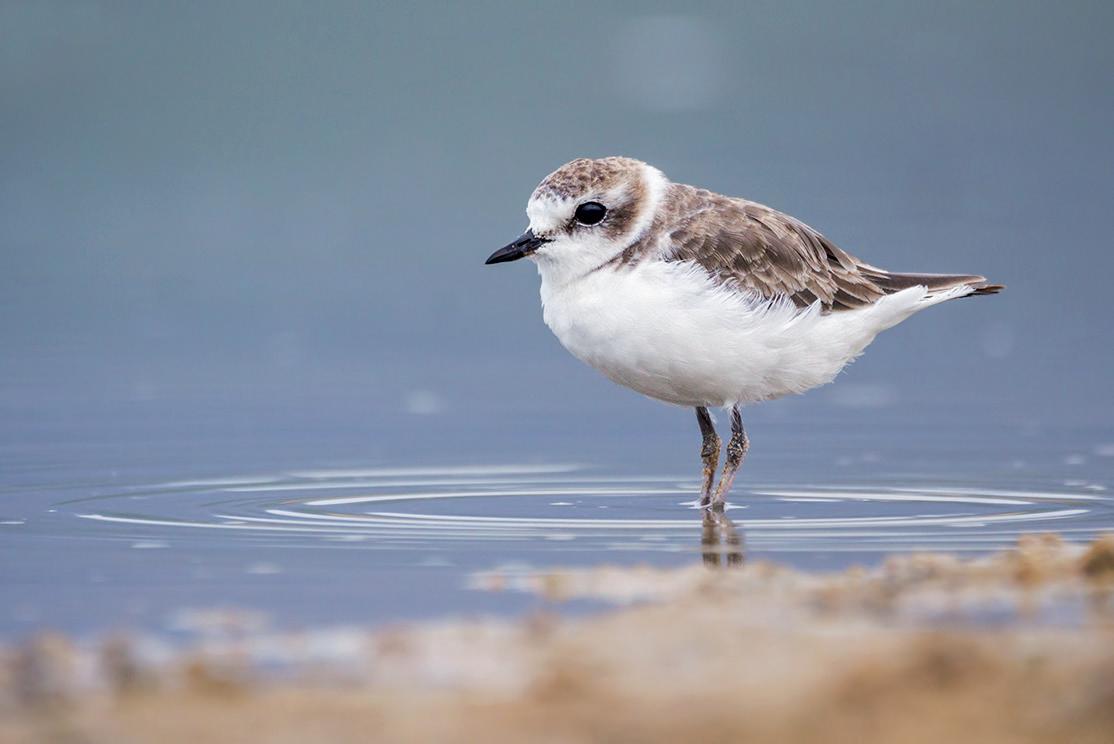
You can continue for a stroll through the umbrella pines. This hot, dry, sandy environment has a special flora and fauna (see page 28). You’ll find plenty of lizards in the open, warm sandy woodlands. Especially Spiny-footed is very common. Chameleon and Montpellier Snake also occur but are hard to find. T hese woods are sometimes home to Azure winged Magpies although there have been few records of them here in recent years.
Continue through the woods if the condition of the track permits it (When we checked in 2023 it was in a ruinous state). If driving is impossible, return to the ermita and the raised track and turn right. Just over 6 km you come to the tarmac road (GPS 36.825103, -6.298198) where you turn right and right again in La Algaida to reach pines from the south in another 10 km.
Reaching the southernmost point of the woods, park under the trees (GPS: 36.847028, -6.315028) and walk the 200m along the track towards Laguna de Tarelo.
8 You have good views over the laguna with its heronry on the island. Expect to see Night and Squacco Heron, Little and Cattle Egret and Spoonbill. On the lake there are Black-necked Grebe, Red-crested Pochard, White-headed Duck and, less often Marbled Duck. In the reeds lurk Common Waxbill and Penduline Tit (the latter in winter).
Head south to La Algaida and continue for 4.5 km and then and turn right after a line of palm trees into the Bonanza salinas (GPS 36.817646, -6.334902).
9
Cross the salinas using your car as a hide, you can get close views of Flamingos, Spoonbills, waders (Black-winged Stilt, Avocet, Curlew Sandpiper, Dunlin, Little Stint, Kentish Plover and other waders), terns (especially Little and Whiskered, but Caspian and Gull-billed are often here as well) and gulls (including Slender-billed). All regular migrant raptors are possible and Osprey and Black Stork occur in winter.
T he track ends at a T-junction, where the track to the right is gated. However, you should be able to walk along it for a view over more salinas (1km). The ditches here hold masses of Fiddler Crab.
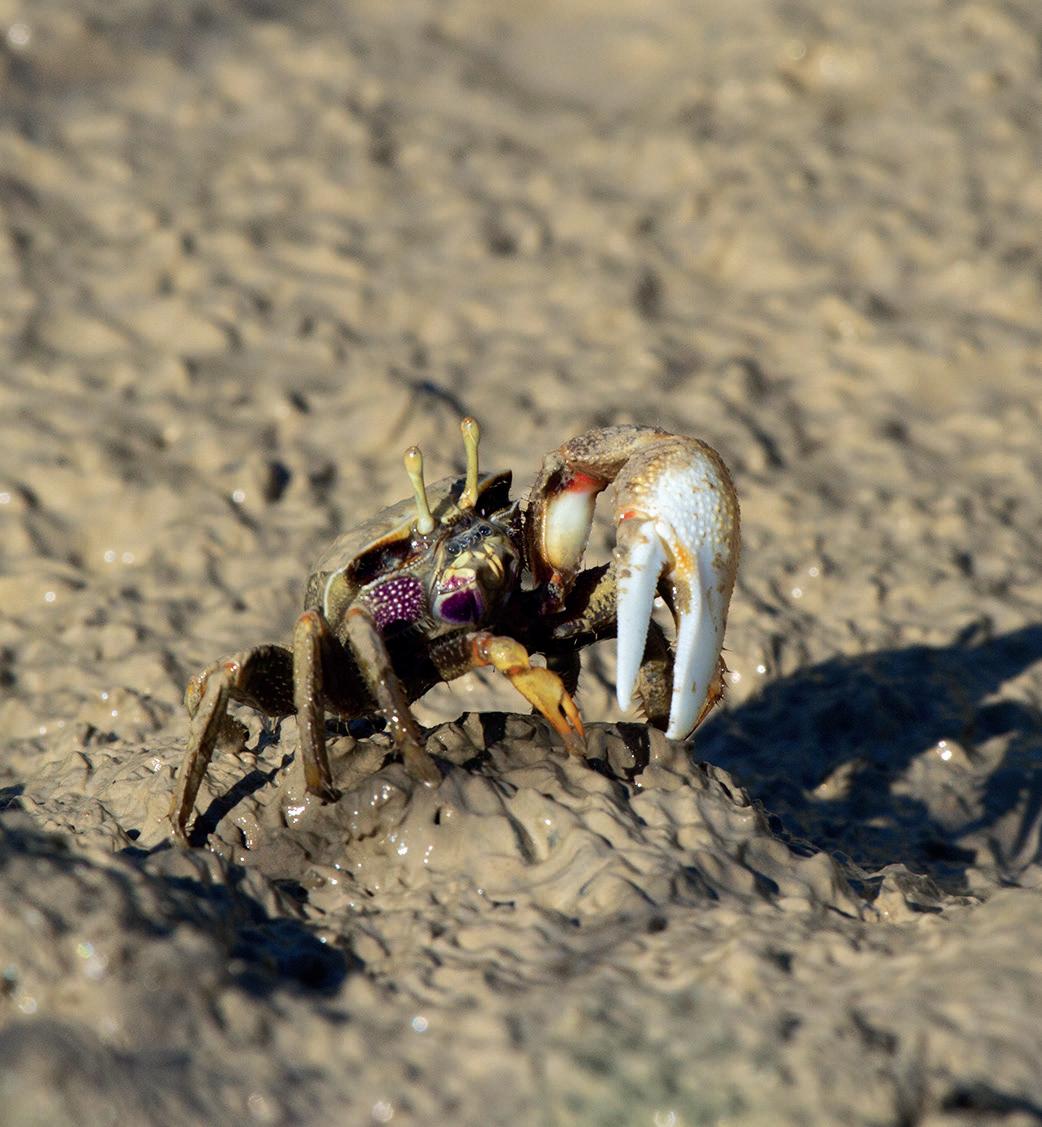
Two highlights of the Bonanza salt pans: Kentish Plover (facing
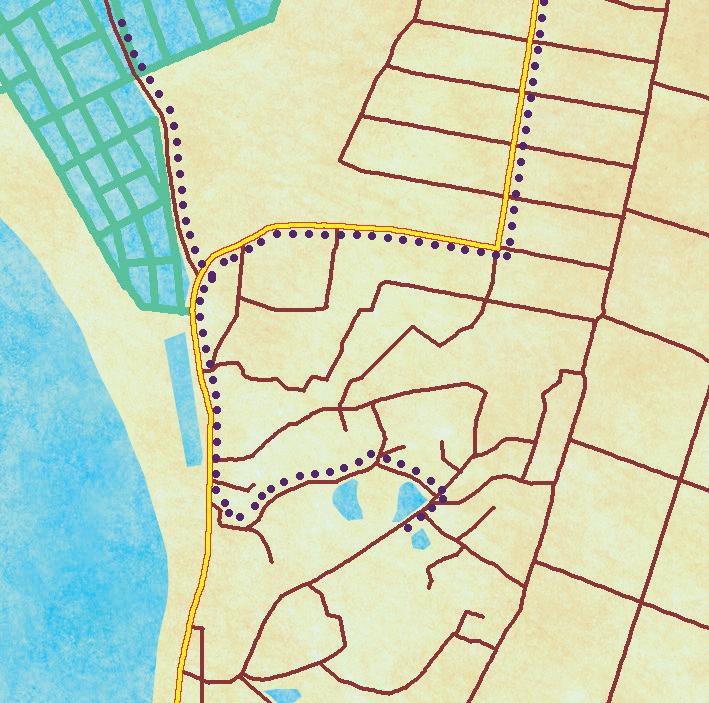
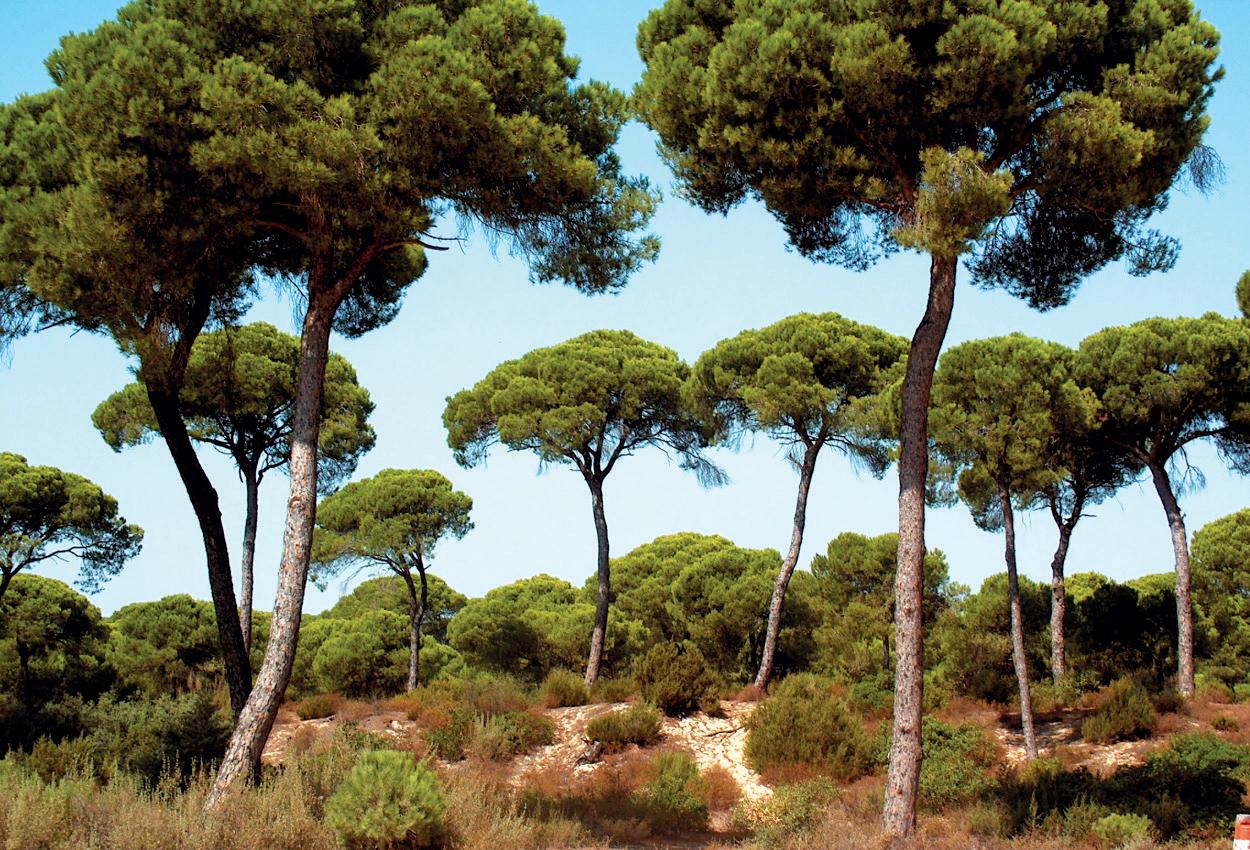
10
Turning left at the T-junction will bring you to the Guadalquivir (but park before this point if the track is in poor condition). Just before the riverbank a rough track heads off northwards beside a fenced area. It is worth walking along this track for a few hundred metres at least (it’s drivable only in a 4x4). Check for Spectacled Warbler and Lesser Short-toed Lark in the short saline scrub. Keep scanning for raptors since Spanish Imperial Eagle may drift across the Guadalquivir from the Coto. For the energetic, there’s a good area of wet marsh some 2 km further on, which can hold birds in drier years.
Return to the road the way you came and back on the tarmac road turn right. Continue for 1 km and then turn left onto Camino Truncosa (opposite El Casque bus stop; GPS: 36.808583, -6.334417). Turn left and the pools will come into view on the right after 700m. Parking is limited at the first pool so continue to the T-junction (1km further) and turn right onto the Camino Colorado to park (GPS: 36.809528, -6.324222) by the pines near the two pools separated by the road and explore on foot.
11
White-headed Duck often shows itself very close to the Camino Colorado here and, with patience, Little Bittern can be seen.
The site also has Purple Gallinule, Black-necked Grebe and sometimes Redknobbed Coot and Marbled Duck and, when low water levels are low, a variety of small waders (often including Temminck’s Stint on passage. The first laguna you reached has a mixed heronry.
Return all the way to La Algaida and onto the CA 9027 by Bar Piti (GPS: 36.829667, -6.319083). Turn right at the T-junction and after another c3 km turn right (GPS: 36.796889, -6.309139) onto a dirt track by two small silos and park.
12
The field on the right sometimes attracts large numbers of Collared Pratincole and these elegant waders often swoop low over the track. The ditch here can hold Purple Heron, Little Bittern and other herons. The two plastic skinned reservoirs on the left here couldn’t be less inviting but often surprise you by having Night Herons roosting in the bushes and White-headed Duck, Black-necked Grebe, Little Gull, Whiskered Terns, the occasional Red-knobbed Coot, and even the odd rarity (we saw Ring-necked Duck here).
Continue on the tarmac road and after 3.5km you arrive at the A 471 (visible to your left) where you go left to return to Trebujena.
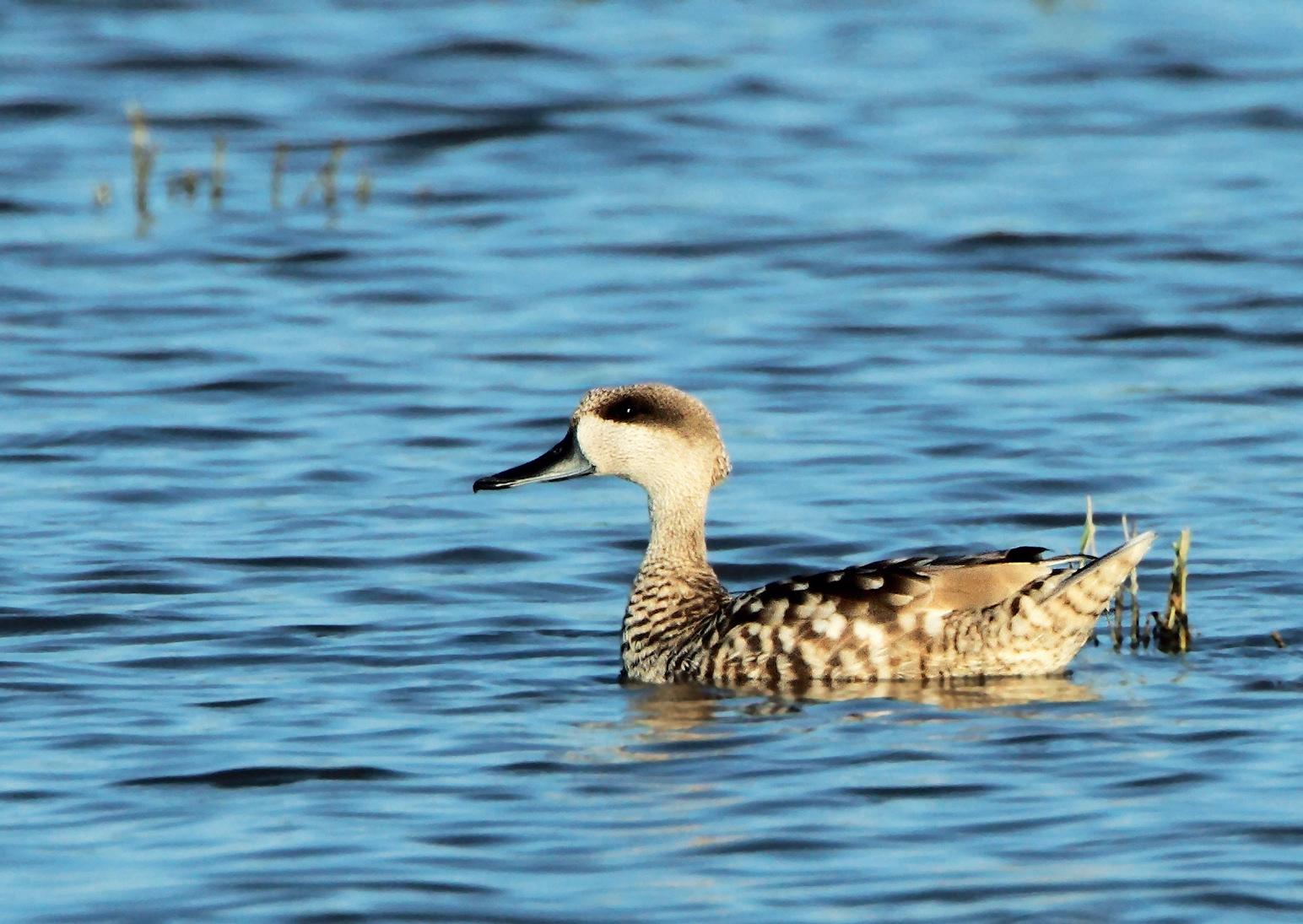
The marshes that fringe the Guadalquivir river are now one of the very few spots to see Marbled Ducks.
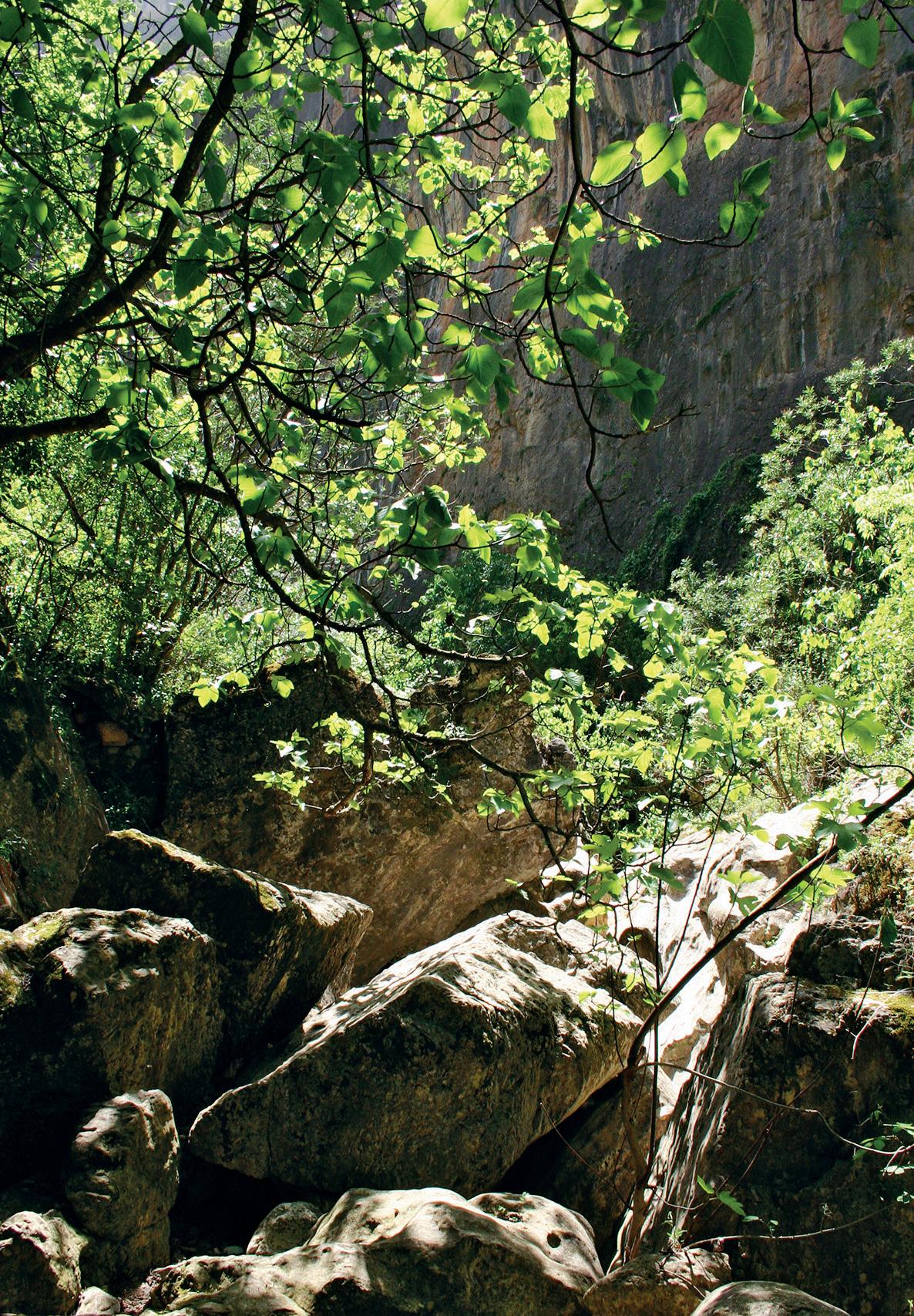
3 The first section offers greatviews of the vultures that nest a little further on. They fly by at eye-level, a spectacular sight. Look for Blue Rock Thrush too. There is a partially hidden trail in the sharp left turn with the Garganta Verde sign (careful; it is easily missed) that leads to a platform with views of the vultures on their nests.
4 The mid-section of the descent is very steep and leads along a wide variety of Mediterranean shrubs, like Dwarf Fan Palm, Kermes Oak, Carob Tree, False Olive, Shrubby Hare’s-ear, Andalusian Gorse* (Ulex baeticus), Phoenician Juniper, Pale Stonecrop, Smilax and Jupiter’s Beard, just to name a few.
Just before reaching the bottom of the gorge, the atmosphere becomes moister. Threecornered Leek, Rustyback Fern and Maidenhair Spleenwort grow between the mossy rocks.

5 In the gorge turn right and make your way along the boulders. The gorge itself is dry, except after heavy rain. Oleanders and figs grow high up in search of sunlight, giving the bottom of the gorge a subtropical appearance.
At the end of the route you reach an impressive, shallow cave, known as La Ermita (the chapel). Rock Doves, Alpine Swifts and Red-billed Choughs breed in the cave.
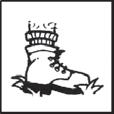
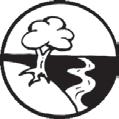



The best spot for birdwatching in the Grazalema mountains. Easy walk through rugged karst landscape.
Habitats: karst, cliffs, dehesa
Selected species: Yellow Bee Orchid, Spanish Ibex, Bonelli’s Eagle, Golden Eagle, Black Wheatear, Black-eared Wheatear, Alpine Swift, Rock Bunting, Blue Rock Thrush, Rock Sparrow, Orphean Warbler, Subalpine Warbler, Dartford Warbler, Spectacled Warbler, Black Redstart, Ocellated Lizard
This route beautifully illustrates the two very different faces of limestone mountains. The first stretch takes you through extremely rugged rock-strewn terrain with bare cliffs on either side of the valley, while the second section runs through a doline (see page 254) with fertile soils converted to agricultural uses and on into woodland. Botanically, this is not the best of routes, but in terms of birdlife, it is hard to find a better spot in these mountains. Nearly all bird species of rocky terrain are present. This route can be covered by car between November to June 1st, but we advise to go on foot, as you will see and enjoy more. If you do decide to drive, take care as, although the track has been recently renovated, it can quickly deteriorate after heavy rains.

Starting point Montejaque, just west of Ronda. Entering the village from the north, take the first street right (Av. de Europa) and turn sharp right after 350m (see inset map; GPS: 36.736833, -5.250778). Park where convenient, or drive on to the T-junction at the base of the cliff and turn left (back to the village; point 2 of this route). There is a car park on your right (GPS: 36.734694, -5.255917).
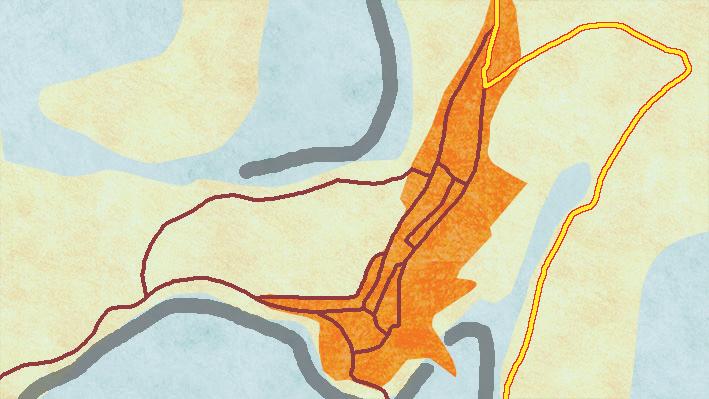
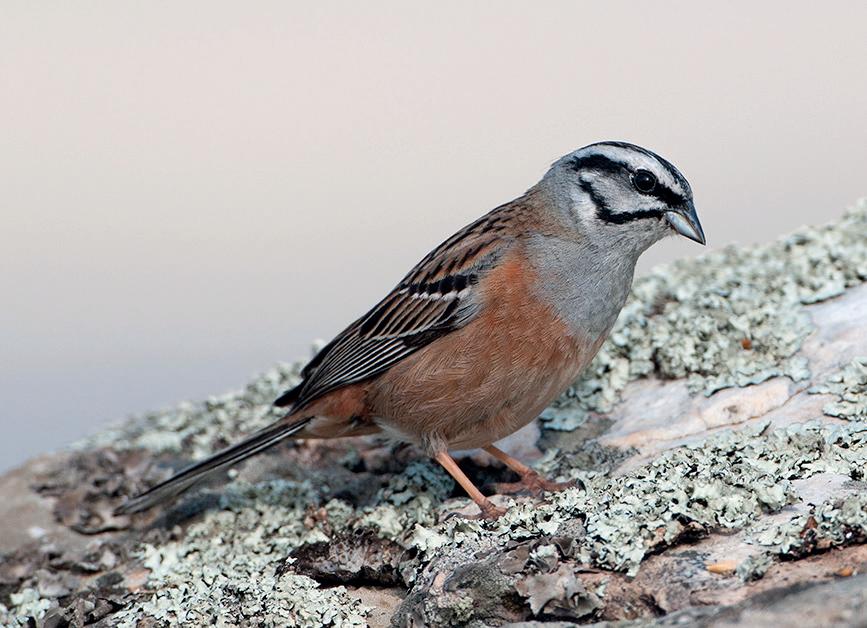
The karst and sierra of the Llanos de Libar is very rocky (top). It is a good habitat for Black and Blackeared Wheatear, Blue Rock Thrush and many other birds, including the Rock Bunting (bottom).
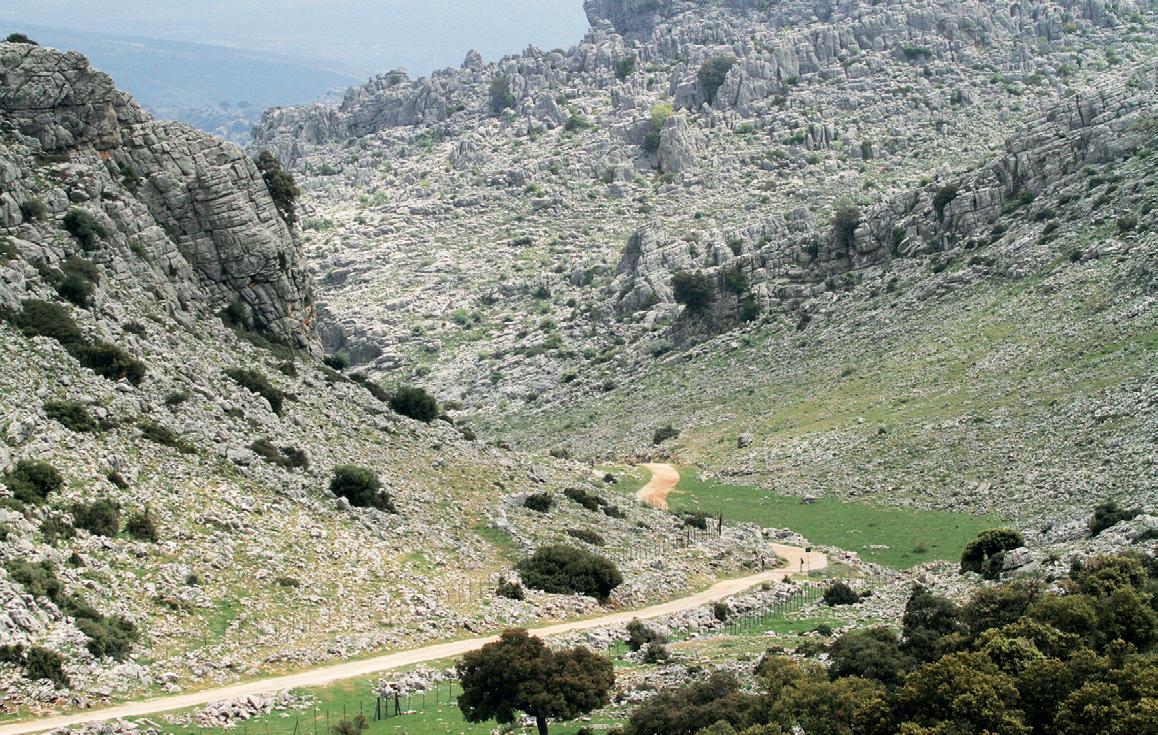
1
About 500 m after turning off Av. De Europa you reach an obvious building on the left, below the rocky bulk of mount Hacho. This is a good spot to scan for a while. You may pick up your first Rock Bunting or Melodious Warbler here, but the main targets are raptors, particularly Bonelli’s Eagle. Listen out for the call of Golden Oriole in the valley below and perhaps Wryneck in the much closer almond orchards.
2
T he track drops down to meet a road, which is overshadowed by a cliff face. Listen for the hoarse call of Rock Sparrow and scan carefully for Blue Rock Thrush. Where the valley opens out into a rocky field Black-eared Wheatear can be seen and, with luck, Rock Thrush may appear. Woodchat Shrikes are common. Continue to scan for raptors and also for Crag Martin and Alpine Swift. Further along the track pause beside a small pool which is very attractive for small passerines (Linnet, Goldfinch, Sardinian Warbler, etc).
3
Go right (away from the village). Further ahead, the terrain becomes increasingly rocky – a classic example of karst landscape. In spring, look for Yellow Bee Orchid, which is abundant here and for much of the trail. Black-eared Wheatears are joined by Black Redstarts and Black Wheatears, all of which perch on the rocks.
4
Continue until you reach an obvious ‘saddle’ in the landscape (GPS: 36.719111, -5.281528). You are surrounded by a jumble of rocks. The bushes which cling to the cliff face to the right conceal a small colony of Rock Sparrow whilst, to the left, the hillside plays host to Alpine Accentor and Ring Ouzel in winter. Check the kestrels carefully as this is a site where Lesser Kestrel, so often seen in villages, reverts to nesting in its natural habitat. Continue over the cattle grid, up the slope and round a gentle bend to a shady tree. The scrub here is excellent for Sylvia warblers with Sardinian being joined by Orphean (listen for the loud thrush-like song), skulking Dartfords, handsome Subalpines and even, with luck, Spectacled Warbler.
5
T he track now drops down into a doline – a depression where sediments washed in to create a fertile patch of soil, of which farmers took advantage to grow their crops. For naturalists, this seems a less interesting spot although feeding vultures are sometimes found here, but it may be a good point to decide to return and make it only a short excursion.
6
If you carry on, you enter an open holm oak woodland, where Iberian black pigs are reared. The birdlife consists of familiar ‘northern’ birds like Common Redstart, Mistle Thrush and Jay, which are joined by Bonelli’s Warbler and Iberian Chiffchaff.
7
Eventually, about 9 km from the starting point, the woods peter out and you reach an open grassy area. This is an excellent area for Cirl Bunting, Iberian Grey Shrike and, in winter, Alpine Accentor. Listen too for the nasal call of Red-billed Chough, often the best way to pick them up as they fly high above the valley.
Return via the same track or continue on foot to cross the pass to Cortes de la Frontera (16 km in total) and catch a bus/taxi back to your starting point.
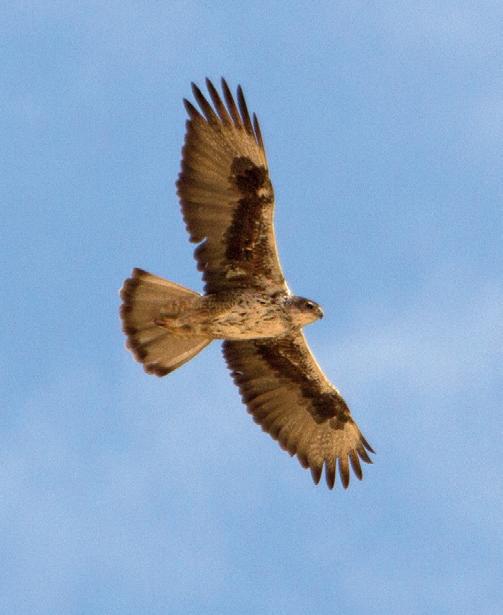

Bonelli's Eagle (top) and Yellow Bee Orchid (bottom) are two attractions of the Llanos de Libar. Patient scanning of the sky is required to find the first, while the latter should be an easy find between the rocks in April/May.
ROUTE 16: SIERRA DE LAS NIEVES – THE HIGH PART
Superb, surreal landscape.


Flora, wildlife and birdlife of the high mountains.


Habitats: Spanish fir forest, high altitude -hedgehog scrubland


Selected species: Alpine Oak, Hedgehog Broom, Spiny Vella, Spanish Ibex, Northern Wheatear, Spectacled Warbler, Bonelli’s Eagle, Red-billed Chough, Alpine Swift, Chapman's Green Hairstreak, Spanish Fritillary
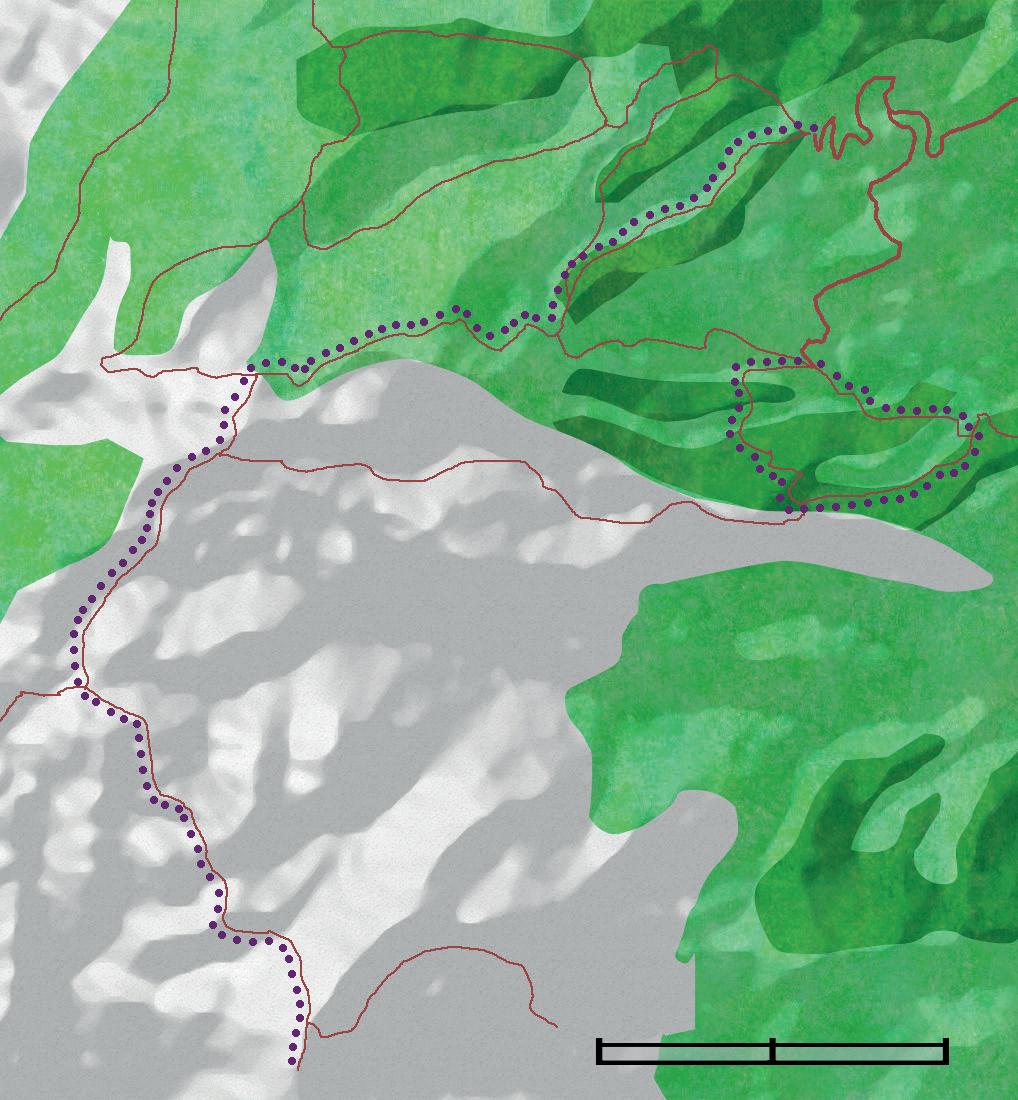
This is the best walk in the Sierra de las Nieves for those interested in visiting the high plateaux. The trail leads you through stands of Spanish Fir to a strange but magnificent landscape with ancient, stunted Portuguese Oaks, and through the much celebrated hedgehog zone. The flora is wonderful, there are several alpine birds and Spanish Ibexes. Although long, this is a relatively easy walk that leads all the way to the highest peak of the Sierra de las Nieves, the 1,919 meter high Torrecilla. To reach it, you need a full day and the discipline not to stop at every new plant and every odd landscape feature you encounter. Note that for the larger part of this route, there is little shade, while at this altitude, the sun can be very strong!
Go to the roundabout at the western end of town and go in the direction of zona deportiva and the campsite. Proceed up the track into the mountains. At the junction, follow Puerto de Saucillo all the way to the viewpoint at the end (GPS: 36.722056, -4.965333).
1
The viewpoint marks the start of the route. Spanish Ibex frequent the slope on the north side of the mirador. The views are stunning
and reach on a clear day as far as Málaga and the Mediterranean Sea. Naked-man Orchid grows near the car park.
Take the route towards Torrecilla.
2
The first stretch of the trail is pretty and shaded by a mixed forest of Spanish Firs and Aleppo pines. The undergrowth is fairly poor, with Stinking Hellebore, Spurgelaurel, Spanish Bluebell and the occasional Western Peony being your most common floral companions. The flowery glades are excellent for butterflies. Panoptes, False Baton and Lorquin’s Blue, Spanish Fritillary, Provence and Chapman’s Green Hairstreak have all been found here. About halfway there is a snow pit to your left (GPS: 36.718278, -4.971472), where snow used to be collected (see history section). Listen for the distinctive calls of Bonelli’s Warblers and Firecrests.
3
Once out of the forest, the more interesting part of the trip commences. Species by species a hedgehog scrubland unfolds, first with Andalusian Gorse* (Ulex baeticus) and Prickly Juniper, later followed by Spiny Hare’s-ear and the most conspicuous of all: the blue-flowering Hedgehog Broom. The latter is intensely appreciated by all sorts of bees, including large numbers of Carpenter Bees. Woodlark, Northern Wheatear, Rock Bunting, Alpine Swift, Sardinian Warbler and Rock Thrush are the more interesting birds you can expect on these slopes.
4
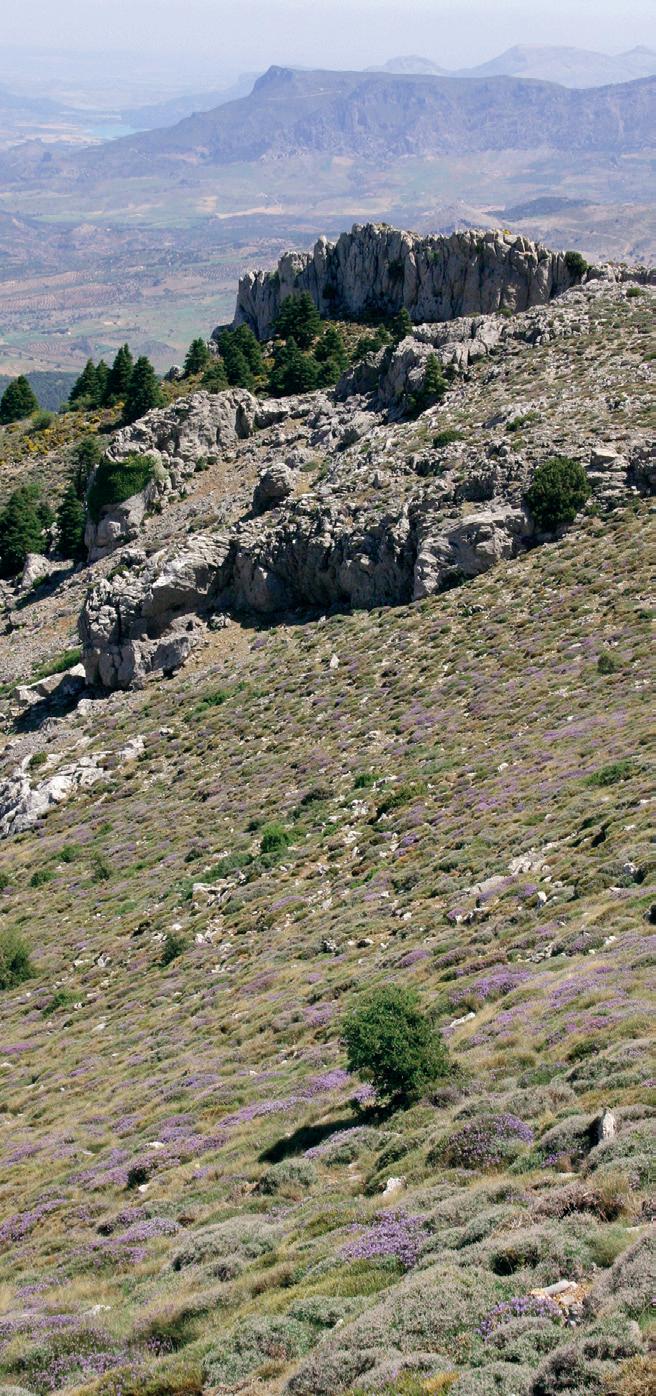
T he trail proceeds between two small peaks. In this area numerous Alpine Oaks have been planted as the ancient specimens you encounter further ahead create few, if any, saplings themselves. The Alpine Oak is a unique subspecies of the familiar Portuguese Oak, named ‘alpestris ’. This variety is said to occur only in the Sierra de las Nieves.
You have magnificent views from the trail over the plateaux of the Sierra de las Nieves. Nowhere in western Andalucía is the Hedgehog Broom as splendid as here. To see it in full bloom, be here in May.
For an overview of the location of these sites, see map on page 199.




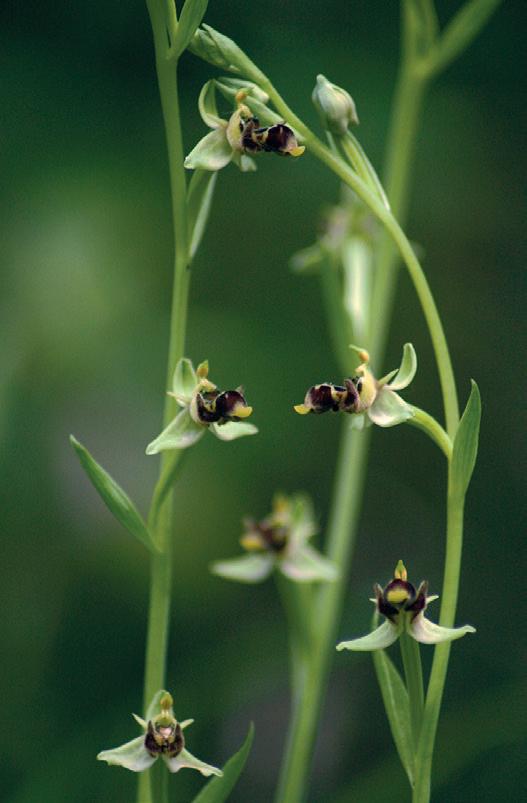
The Woodcock Orchid usually has pink petals, but on the Benemahoma – El Bosque walk, the rare form with green petals can be found as well.
GPS: 36.766056, -5.469778. The trail from Benamahoma to El Bosque offers a lovely and easy walk in the Sierra de Grazalema.
It leads along the Majaceite river in the shade of tall trees and cliffs, so it is a wonderful trip for a hot day. The Majaceite is one of the very few permanent streams in the Sierra de Grazalema, where everywhere else, the water sinks directly deep into the surface. In former times, watermills were in place along the river.
One very good reason to walk this route is to experience the oasis-like character of this river in the dry mountains. There is a thick vegetation of Willows, brambles and Narrow-leaved Ash. Another good reason is to enjoy the flora on the grassy verges along the trail. We found no less than six species of bee orchids (Ophrys) here in spring: Sawfly, Bee, Sombre Bee, Yellow Bee, Woodcock and Mirror Orchids. Others have recorded the rare Summer Lady’s-tresses in summer. Large Tortoiseshell, Spanish Festoon and Two-tailed Pasha are frequent butterflies. There is a botanical garden in El Bosque.
The trail starts on the southern bank of the river at the western end of the Benamahoma. It is a linear walk. Either return the same way, or take a taxi in El Bosque.




GPS: 36.696750, -5.381639. This gentle walk to the Republicano doline (see map on page 205) and beyond lacks the impressive scenery encountered elsewhere in the area, but you will be able to see a good number of birds, plants, reptiles (e.g. Three-toed Skink and Ocellated Lizard) and butterflies (including Provence Hairstreak, Lorquin’s Blue, Adonis Blue and Marsh Fritillary) and witness some remarkable karst formations, grassy dolines and holm oak dehesa. Among the birds Blackeared Wheatear, Rock Thrush, Thekla's Lark, Rock Bunting, Woodchat Shrike and Orphean Warbler are frequent, while botanists will enjoy the likes of Portuguese Squill and Spanish Iris.
The linear trail starts on the east side of the village of Villalengua del Rosario, at a large car park on the main road. Follow the narrow tarmac road south through a dehesa-type landscape (it is possible to do the first stretch by car and park, after 1.1 kms at another car park). At the gate of a private finca, you pass through a swing gate on the left and continue to the doline and the rocky Sierra de Libar further south, which is best for wildflowers.
The valley west of Villalengua on both sides of the A-374 is also interesting for plants (e.g. Bumblebee and Giant Orchids) and birds. Check the wires here for Rock Thrush.

With its campsite and several hotels, Grazalema is a good base to explore the sierras. From the village, a number of short walks can be made, offering an excellent introduction to area including its rich flora, birdlife and butterfly fauna. One option is to walk the path parallel to the Guadalete river up to the Puerto de Boyar (GPS: 36.755750, -5.395056). Rocky spots en route may hold some interesting birds (Black Wheatear, Blue Rock Thrush, Rock Bunting, Rock Sparrow, Crag Martin, Alpine Swift, Griffon Vulture), while the area of the pass ( puerto means pass) is excellent for spring butterflies, including Spanish and Marsh Fritillaries, Purple-shot Copper, Provence Hairstreak, Lorquin’s and False Baton Blues. The flora is rich as well, with Woolly Viper’s-bugloss* (Echium albicans) and orchids like Sawfly, Yellow Bee, Small-flowered and Common Tongue Orchids. One of the very best walks in the entire Sierra starts from Puerto de Boyar, but sadly it closed to the public recently (2015). It is unknown if it will be opened in the near future.




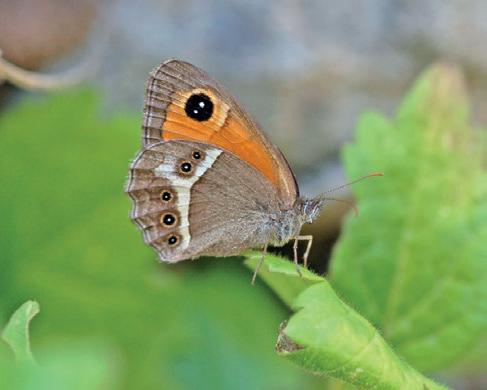
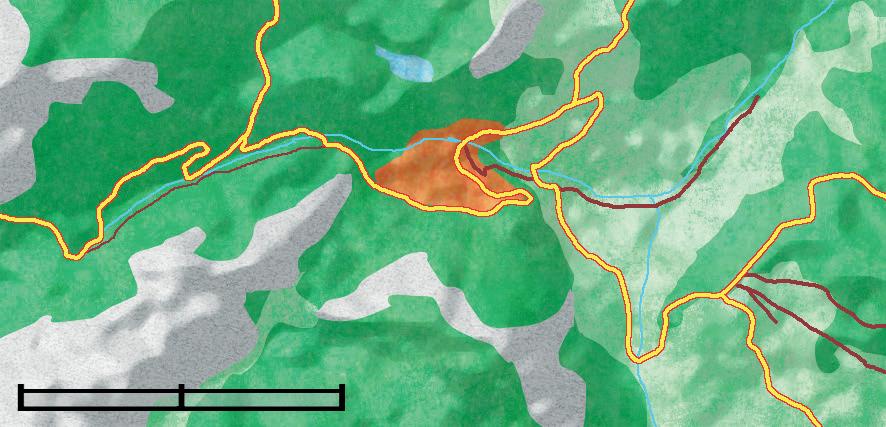
The Spanish Gatekeeper is one of the more common spring butterflies at Puerto de Boyar. 0 2


Few cities in Spain or indeed Europe are built on such a wonderful location as Ronda. The historic town centre is split in two by the 100m deep Tajo gorge, which is spanned by several bridges. Most spectacular is the 18th century Puente Nuevo
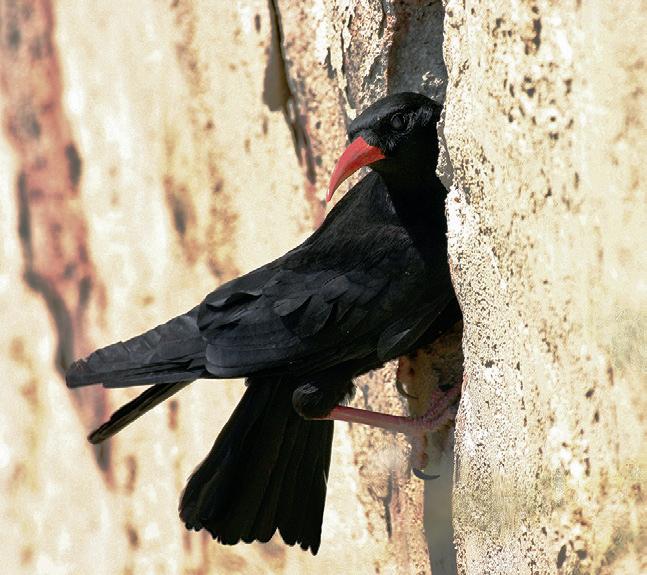
Red-billed Choughs breed in the gorge of Ronda, which separates the historical centre from the rest of the town.
Both the Sierra de Grazalema (on the photo) and Sierra de las Nieves offer a number of beautiful walking trails.
from which you can enjoy point blank views of Red-billed Chough. Kestrel, Lesser Kestrel, Raven, Alpine Swift, Blue Rock Thrush, Black Redstart and Rock Sparrow also occur in the gorge or breed nearby. The Rock Sparrows are amazingly easy to find in the gorge.

GPS: 36.691361, -5.268611. The Pileta
cave is situated near the village of Benaoján in the southern part of the Sierra de Grazalema (see map on page 205). It is a spectacular cave because of its rock paintings that date back to the late Stone Age, 50,000 to 20,000 years ago, just after the latest ice age. There are also paintings from later periods, and from the changes in style one can discern the evolution of prehistoric man. Europe’s oldest known pottery shard was found here. Many bats use the cave, but getting a good look at them is problematical. The Cueva de la Pileta is open daily for guided tours and costs € 10,- (adult price). Go to www.cuevadelapileta.es to book a time slot for your visit.


GPS: 36.710500, -4.965000. This fairly short loop (although it can easily be extended), in the Sierra de las Nieves is a good choice if you want to explore these wonderful mountains more thoroughly. It leads through a mixture of (youngish) Spanish Fir forest and maquis, and has an attractive flora. In particular orchids are well represented, with Spanish Omega Orchid* (Ophrys dyris) and Man Orchid among the seven species we found. Other hikers have reported the rare Atlantic Orchid (O. atlantica)!
We’d rate this walk as moderately difficult. It starts from the Mirador de Luis Ceballos, close to the starting point of route 17 (see map on page 208) and is well signposted.
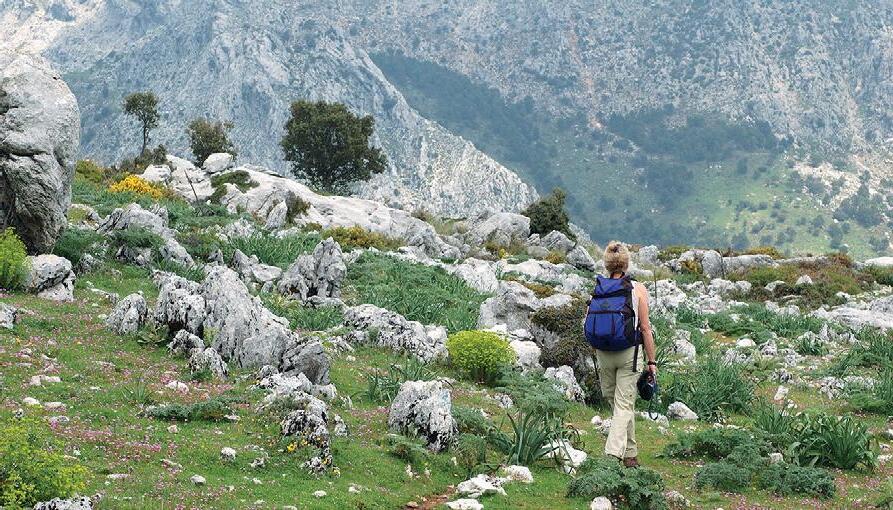

The only easy crossing through the Sierra Baetica is from Málaga to Antequera. There are various sites along the motorway that connects these towns and the lowlands beyond. Because this road goes straight from the Mediterranean coast and passes mountains over 1,200 metres high before dropping into interior steppe lowlands, the diversity of sites within short reach of each other is enormous. From the marshes of the Guadalhorce (site A on page 223) and the sunny and warm hills of Málaga and Mijas (sites B and F on page 223 and 227), it is only a little over an hour by car to the scorching steppes of Osuna in the interior of Andalucía (route 18). Along the way, you’ve passed top notch sites like the high karst plateau of Torcal de Antequera (one of the most impressive karst sites of Europe; site C on page 224) and the Laguna de Fuente de Piedra (site E on page 226; Spain’s largest natural steppe lake, housing Europe’s second-largest Flamingo colony). Seen as a whole, this region is not as attractive as the other regions of this book, but there are some true gems here, and together they add up a diversity in species and habitats that is unrivalled by the other regions in western Andalucía. Because of the straightforward access, most of them are described here as sites, rather than routes.
If you prefer to stay in the interior rather than at the coast, there are hotels and hostals in Campillos and Antequera, and a camp site in the village of Fuente de Piedra.
Overview of the Málaga – Antequera area with the position of the routes. The letters refer to the sites on page 223-227.
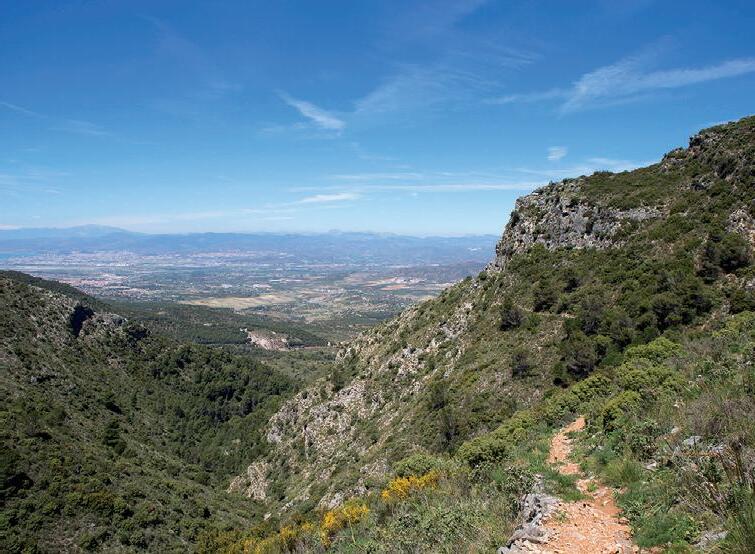
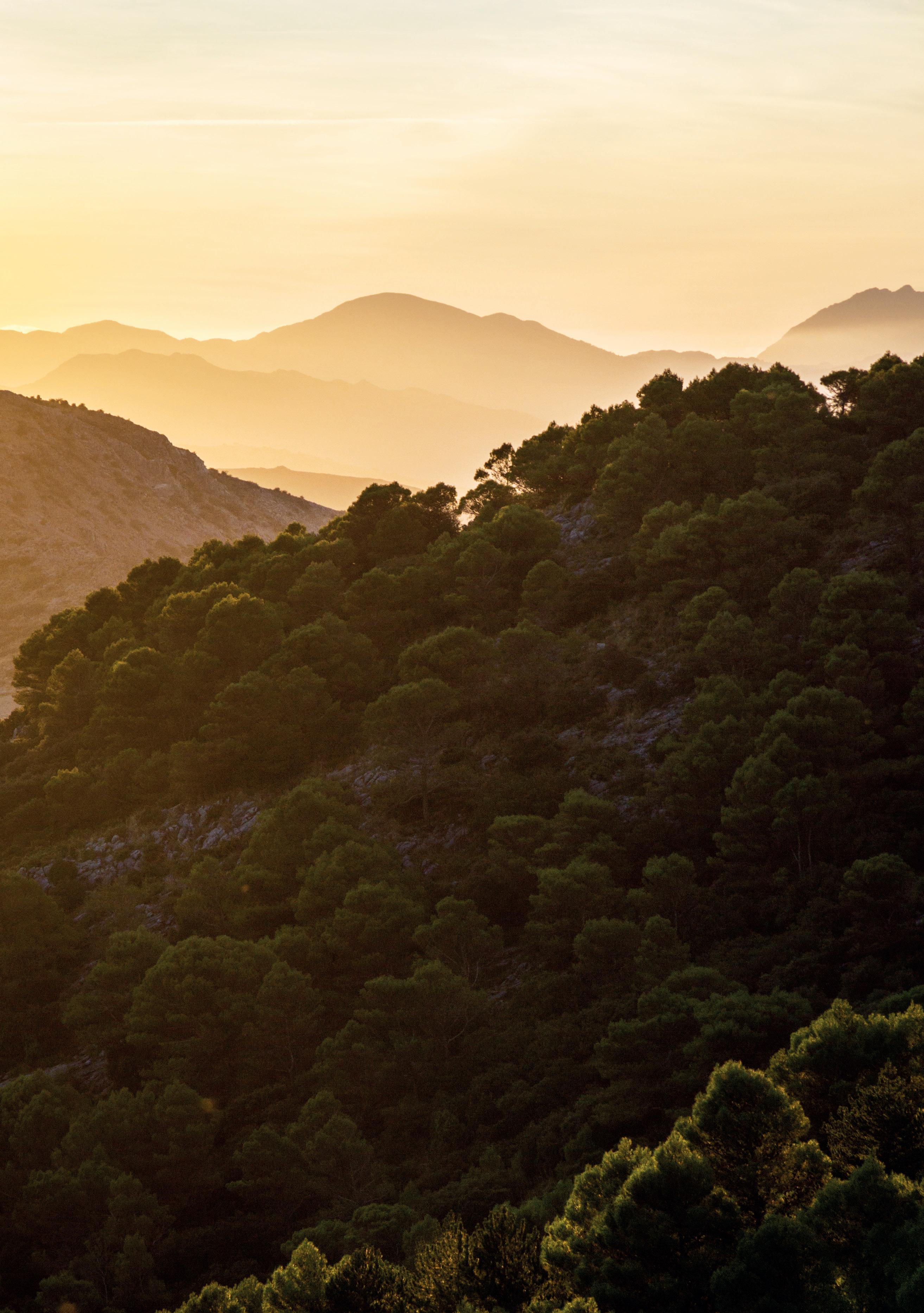
Andalucía is easy to reach by car, train or airplane. International airports serve Sevilla, Málaga, Jerez de la Frontera and Gibraltar, all of which have regular services and many charter flights. You could also fly to Faro in Portugal, but make sure your car hire company and insurance allows you to visit Spain.
The car is by far the easiest means of transport for this region. There are many car rental companies in all the airports and major cities. Economy class cars are not expensive, but carefully check hire details as some companies have restrictions. Also consider buying your insurance in advance as it is often cheaper.
Experienced cyclists will enjoy this region as well. The roads are generally suitable for cycling and traffic is light. The region is visited by a fair number of cyclists. The terrain is rather mountainous, which means that heavy climbs and steep descents are the rule rather than the exception. Note that in the summer months it is too hot to cycle during mid-day.
The National train network extends into most provinces, but train lines are few. There are direct lines into West Andalucía from Madrid (including the AVE high speed train to Sevilla and Málaga) and from Badajóz (Extremadura). Within the region, Huelva, Sevilla, Cádiz, Jerez, Algeciras and Málaga are connected by train. For up to date information, including international bookings, see www.renfe.es (also in English and French).
Buses connect you with the smaller villages. As in other places in Spain, they are run by private companies. In general, buses are few, at best leaving a few times a day, but often only once a day or even a week, so it is a challenge to plan a trip depending on them. On the upside, they are not expensive and generally offer pleasant travel. For lines and timetables, see www.andalucia.com/travel/bus/home.htm
Most villages have a taxi service too, which can take you to and from the starting points of any trail.
West Andalucía is of interest throughout the year. In January and February, Coto Doñana and other marshes are packed with birds. Many of the attractive species of Andalucía are residents, and they are joined by unexpected species like Spotted Eagle. This period is also the best to search for Lynx in the Sierra de Andújar.
In February, spring starts with the arrival of early migrants like White Storks, Swallows and Great Spotted Cuckoos. The early orchids (e.g. Giant Orchid) and other bulbs come into bloom.
The migration spectacle across the Strait of Gibraltar starts in earnest in March and continues throughout April. At the same time the countryside comes into a spectacular bloom. This is also the time for most reptiles to become active.
By mid April to mid May, the flora is at its peak, birds are everywhere, migrant birds are still pouring in and the spring butterflies like Spanish Festoon and Cleopatra are on the wing. This is a magical time of the year.
By the middle of May, even late migrants, such as Rufous Bush Robin, Olivaceous Warbler and White-rumped Swift, have arrived in force. Much of the flora in the lowlands has passed its peak, but the flora of the hedgehog broom zone (the higher mountains) is in full bloom. It is an excellent time to look for butterflies in the Grazalema and Nieves mountains. This continues well into June.
The period from mid-June to late July is the best season for finding the many rare dragonfly species of western Andalucía. Otherwise, it is a challenging season for naturalists. The heat is intense, making only the early and late hours of the day bearable. Many public trails in the mountains (particularly in Grazalema) are closed due to the risk of forest fire. Water birds congregate at the few wetlands that haven’t dried out. July to August is the best season to go out and watch whales and dolphins from Tarifa, as Orcas are frequently spotted in the summer months.
By mid August, the southbound migration is gearing up. Numbers quickly swell and peak in the second half of September. This is another magical time: temperatures are bearable again, there are huge numbers of birds, it is still a good time to find reptiles, the rare Zeller’s Skipper and the first autumn flowers are appearing (the most attractive autumn flowers do not flower until the very end of September). This is also the rutting season, and in the Sierra Morena and Andújar, there are plenty of deer. By October many of the migrants have passed through, but it is in October that large numbers of martins, larks, pipits, buntings and finches pass through and Cranes arrive. By then the autumn flowers are in full bloom.
From late October to December things quiet down again, although some bird migration may peak in this season (e.g. Griffon Vulture). Although quieter than other months, for visitors from northern Europe sunny days can still feel surprisingly
mild, making exploring the landscape on foot an attractive option. The best lowland sites have flocks of Cranes, bustards and sandgrouse plus wintering raptors like Hen Harrier and Bonelli’s Eagle.
Western Andalucía is far too large to cover from a single base. Travelling through the area and staying for a day or two (or even a few days) in each region or habitat is a good way to explore the entire region. The best accommodation is of course in places where the owners are dedicated to low or zero environmental impact, often supplementing their enterprise with organic farming. You can find such eco-friendly accommodation at www.ecotur.es. For camp sites, check out en.camping.info/spain/andalusia/campsites.
Here are some helpful suggestions, including accommodation tips: Aracena area For those looking for a quiet country retreat and who enjoy birdwatching, the rolling, wooded hills of Aracena are perfect. The dehesa ecosystem is unique and highly interesting. Spring is the best season, while autumn is very scenic. Plan for a minimum of two full days. There are various pretty casa rurales in the region, including ecological farmhouses at Alajar and Cortegena. Camp sites are present in Fuenteheridos and Valdelarco.
Coto Doñana is of year-round interest for birdwatchers and naturalists alike with mid-summer having the least to see. Plan at least three days. The classic sites are in the western side of the National Park, where accommodation is plentiful in El Rocío and Matalascañas, with surrounding villages offering quieter casas rurales (rural bed and breakfasts). There are camp sites in Punta Umbría (Huelva), Mazagon, El Rocio and Aznalcázar.
The Cádiz-Tarifa area is of interest to birdwatchers and naturalists alike. Cádiz province is spectacular especially during bird migration periods. The endorheic lakes and the eastern bank of the Guadalquivir host many wetland birds and a score of rare dragonflies. There are a few pretty walks in the nearby Alcornocales natural park with an attractive spring flora and a fascinating ecology of the canutos. The area is of year-round interest, with spring (late February-early May) and autumn (late August-October) best for birdwatching and wildflowers. The summer period is the most attractive for dragonflies and whale and dolphin watching. There are lots of different things to see here, and five days is the minimum for a good taste of the area. Accommodation is mainly concentrated along the coast, with campsites near Conil, Palmar, Tarifa and further inland near Alcalá.
Grazalema – las Nieves forms a splendid hiking area, with lots of butterflies and wildflowers, a fascinating landscape, ecology and geology, and birds of rocky terrain. The area is at its best between mid March and late June.
Huelva and Seville Province
Wild Doñana run by Manuel Mojarro. Base: Corrales.
Areas covered: Doñana, Odiel Marshes, Sierras de Aracena and Sierra Norte. www.donanabirdguides.com
Andalucia Nature Trips run by Laury Grenon. Base: Mazagón
Areas Covered: Doñana, Odiel Marshes, Sierras de Aracena and Sierra Norte.
www.andalucianaturetrips.com
Alas del Sur Birding run by José Zarapico Ostos. Base: Seville.
Areas Covered: Sierra Norte, Doñana Norte, Brazo del este y Campiña Sevillana. www.alasdelsurbirding.com
Cádiz Province
Birding the Strait run by Javi Elorriaga and Yeray Seminario. Base: Tarifa
Areas Covered: Strait and Campo de Gibraltar, Doñana NP in Cádiz.
www.birdingthestrait.com
Birding Tarifa run by Manuel Morales. Base: Tarifa
Areas covered: Strait and Campo de Gibraltar, Doñana NP in Cádiz. www.birdingtarifa.es
Inglorious Bustards run by Simon Tonkin & Niki Williamson. Base: Facinas (Tarifa).
Areas covered: Strait and Campo de Gibraltar, Doñana NP in Cádiz www.ingloriousbustards.com
Rewilding Bushcraft run by Neil A Hill. Base: Facinas (Tarifa).
Areas covered: Strait and Campo de Gibraltar, Doñana NP in Cádiz www.rewildingbushcraft.com
Oxyura Birdwatching run by Manuel Bárcena Base: Sanlúcar de Barrameda.
Areas Covered: Strait and Campo de Gibraltar, Doñana NP in Cádiz. www.oxyura.es
‘Take nothing but photos, leave nothing but footprints’ is the well-known phrase that summarizes the idea of responsible tourism. It goes without saying that, as a visitor to a nature reserve, you have a responsibility to leave your surroundings and everything in it undisturbed. But it may be less than obvious what is and isn’t damaging in western Andalucía. So here are some points of which you should be especially aware when visiting this area.
The greatest and most devastating threat to Mediterranean wildlife is a wildfire. The Spanish fir forests, dehesas and oak forests are unique and a crucial retreat for Andalucía’s flora and fauna. So be extremely cautious with fire and never throw away cigarette butts or glass items in the field.
Water consumption is another issue. Over the last decades massive reservoirs have arisen to meet the sharply increasing demand for freshwater. Thousands of hectares
of valuable natural areas have been flooded and river flows have been destroyed. More reservoirs are planned. Help to control the water demand and do not use more than is strictly necessary.
Obviously it is important to move quietly and discretely when exploring natural habitats, not only to prevent disturbing the wildlife, but also to increase your chances of observing it.
Ecotourism is often promoted as a sustainable form of local development, which can coexist and even support nature conservation. The positive impact of your visit is most obvious when you consume local foods and products in small locally run establishments. In Spain, foods are often labelled denominación de origin, which is a declaration not only of origin, but also of local pride. Buying wine with a cork stopper (not a plastic one) supports the maintenance of the valuable cork oak dehesas. In the Sierra de Aracena, several companies who have put sustainability at the heart of their endeavours have joined forces, including a casa rural and a traditional Ibérico pig farm – a great way to explore the countryside and enjoy local products in a naturefriendly way. See www.alojamiento-alajar.com.
Andalucía has a relatively small, but growing number of waymarked trails. Most of them were not created to be a beautiful or challenging trek, but simply to provide a route to villages or fincas (rural estates) and a means of getting from A to B. In addition to this, most land, even in natural parks, remains in private hands and as most land owners are not too keen on having strangers on their land, much of what looks like splendid hiking terrain remains out of reach. As a consequence, public trails are few and often linear. Only the high mountains provide more options for hikers. For naturalists in search of flora, fauna, or geological and ecological highlights, this is not a big problem: walking a shorter stretch and returning via the same way can be just as productive and interesting as a circular route. For hikers wanting a longer trek, there are plenty of taxi services that return you to where you started. Mind you, with ‘taxi service’, we don’t mean ‘taxi company’ – the driver is usually either the owner of the local bar, his brother or brother-in-law. In any case, your best chance is to ask for a ride in the local bar. If you don’t speak enough Spanish to feel safe about organising a ride back on the spot, have the hotel, camp site or B&B where you are staying make arrangements in advance. If possible, first park your car at the end of the route and catch a local bus back to the starting point. This way, you are never without transportation at the end of a strenuous hike.
This being said, there is a rapidly growing interest in hiking by the local community. While the official brochures maintain the classic linear walks, active local hikers publish new walks over old and often forgotten trails and tracks. The Wikiloc website (www.wikiloc.com) is an excellent, easy-to-use and popular place where people share
fantastic birdlife and traditional landscapes of dehesas and steppes which turn into a colourful carpet of wildflowers in spring. Extremadura is one of the most traditional regions of Spain, with superb, wide landscapes and rugged Sierras.
Crossing the Guadiana into the Portuguese Algarve, the ‘Lusitanian’ nature of West Andalucía lowlands continues: along the coast there are excellent marshes, estuaries, dunes and umbrella pine whilst inland there are steppe habitats where both bustards, Black-bellied Sandgrouse and Roller find a home.
Searching for orchids is like looking for Easter eggs. Picking out a new or rare species in the dense Mediterranean vegetation is an exciting and highly addictive sport. Orchids are numerous in some parts of Andalucía (Alcornocales, Sierra de Grazalema and las Nieves), but this does not mean that they are easy to find if you do not know where, or how, to look. The first thing you should realise is that orchids are not the most resilient plants nature has brought forth. They have no protection from being grazed so are quickly chewed into oblivion by sheep and goats. What’s more, many orchids are weak competitors, easily pushed aside by other more vigorous plants. The result is that they usually grow alone or in small clumps. In Andalucía, they are usually not numerous, except along roadsides. There, the grazing pressure is low and the frequent mowing, which leaves their bulbs untouched, seems to be enough to keep the competitors at bay. Often you will find a lot of orchids close to your starting point near the road but only a handful further along the route. The grazing pressure in the mountains is rather high. Overgrazed regions are readily distinguished by the short sward and the high numbers of poisonous and resilient plants like Purple Jerusalem-sage* (Phlomis purpurea), Dwarf Fan Palm, Asphodels and bitten-down Holm and Kermes Oaks. Orchids can only stand their ground here by taking refuge in spots inaccessible to herbivores: under fences, between rocks, under spiny or inedible shrubs, etc. This is where you should look.
If you have never searched for orchids before, pictures (including those in this guidebook) can be very deceiving, because the flowers seem very large. The spikes of Nakedman and Spanish Early-purple Orchids* (Orchis olbiensis) are indeed conspicuous, but for those of the bee orchid genus (Ophrys), which are smaller and with fewer flowers, you need to develop an eye. In the picture on the opposite page you can get a feeling for the size. The pale, rather thick stems are usually the first feature to capture your attention. Limestone soils harbour different species than acidic soils. In general the limestone areas are the richest in orchids. Many grow in half-shady conditions in scrublands, karst or light forests.
Most orchids flower in spring, typically from March to May. The altitude matters greatly for when the flowers come into bloom. A Mirror Orchid in the pine forests of Barbate may have finished by the end of March, while that same species on the slopes of Torcal is yet to open its first flower.
Rich orchid haunts in western Andalucía are: Breña de Barbate (route 9): several bee orchid species and Autumn Lady’s-tresses. FebMarch is peak time.
Los Alcornocales (route 11): forest species like Lange’s Orchid, Violet Bird’s-nest and Tremols’ Helleborine, Small, Heart-lipped and Sharp-lipped (strictiflora) Tongue Orchids, Bee and Bumblebee Orchids. April-May

Sierra de Mijas (site B on page 223): several bee orchid species, including Atlantic Orchid, Two-leaved Gennaria, Giant Orchid and Fan-lipped Orchid. Feb-late April.
Sierra de Grazalema (sites A and B on page 214 and the area around the reservoir of Zahara-El Gastor). Several species of bee orchids (including Spanish Omega), Denseflowered, Spanish Early-purple, Naked-man and Man Orchids.
Mid-April-May
Sierra de las Nieves: Route 17 and site F on page 216. The slopes
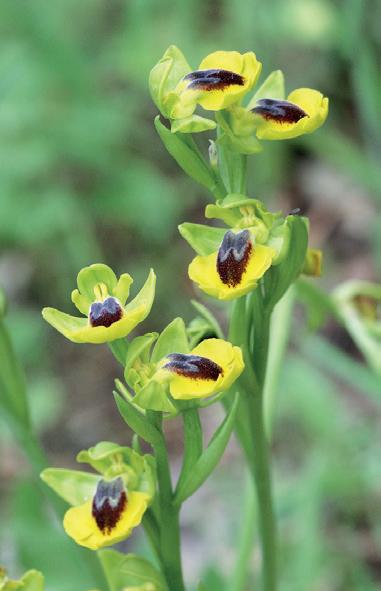
Yunquera
Los Quejigales, with similar species as Sierra de Grazalema. Mid-April-May.
Aviantours (www.aviantours.net) operates out of Gibraltar and offers hides specifically for photographing Golden Eagle, Spanish Imperial Eagle and woodland birds. Spanish Nature (www.spanishnature.com) has the use of a photographic hide at Finca Algaba, near Ronda (www.algabaderonda.com) and another hide in the Sierra Nieves. These sites attract a good range of small passerines and birds of prey.
A good thing about snakes, spiders and scorpions is that if you do not want to see them, they remain hidden, but if you do, there are ways to find them. The best way to go about it is to head for a scree field or stony karst landscape and start turning the stones. Beneath them you find a wonderful hidden life of creatures that appear
on the menu of too many predators to be comfortable in a place in the sun. They come out at night to hunt and by day avoid being hunted by crawling under a rock. Mostly you will find ants and their nests, but every now and then you will stumble upon a Scorpion, Wolf Spider (related to the tarantulas), snake, Megarian Banded Centipede or one of the more drought-resistant amphibians. If you are lucky you might even find a Worm Lizard.
Flat stones or old pieces of plastic give the best hit rate. Lift them up on one side, turn them over and step back. Be aware that some animals can cause painful stings or bites.
Be also aware that turning over stones is very invasive for the animals that are hiding. Many of them worked hard to create a nest underground. Therefore, make sure that you do not disturb the subterranean life for too long and place the stone back in exactly as you found it.
Some snakes are active at night. They often warm themselves on the pavement of small country roads. A drive or walk at dusk can reveal Ladder, False and Southern Smooth Snakes. In spring and summer other snakes and lizards use these places to warm up for the day.
The numbers between the brackets () refer to the routes from page 135 onwards:
Geese and ducks Grey-lag Goose is the only goose species in the region. It winters in Doñana (1, 2) where it is also a rare breeding bird. Except for Mallard, which is widespread across the region, the breeding duck species are confined to the marshes at the coast and endorheic lakes. Gadwall, Shoveler and Ferruginous Duck (rare) are mostly seen in the western Doñana (1,2, 3, site J on page 197). Pochard and Red-crested Pochard are more widespread (1, 2, 7, 8, site J on page 197, Site E on page 226). Marbled Duck is a rare and declining breeding bird (2, 3, 7, 8). White-headed Duck is largely confined to the endorheic lakes (7, 8). In winter these species are joined by Wigeon, Pintail, Teal and Tufted Duck. Garganey mainly passes through in March, but has bred.
Shelduck is common in saline marshes in winter (7, 9, site C on page 153 and E on page 226), but scarce as a breeding bird. Ruddy Shelduck is very rare, but sometimes seen on 8 and site A on page 223.
Pheasants and partridges Red-legged Partridge is a common but sometimes secretive species. Locally, numbers are very high due to introductions for hunting (e.g. 9). The essentially African Barbary Partridge occurs in the scrublands of Upper Rock, Gibraltar (10). Quail is a local bird of cereal fields. There are a few scattered populations of Pheasant, released by hunters.
Grebes Black-necked Grebe is a very local, but sometimes common breeding bird of endorheic lakes (8). Little and Great Crested Grebes are locally common on vegetated pools (1, 2, 3, 4, 7, 8, site J on page 197).
Cormorants, Shearwaters, Storm-petrels and Gannet From headlands in the Strait and on the Atlantic coast (1, 9, 10, site F and G on page 195) you have a good chance of seeing seabirds. Gannets and shearwaters occur throughout the year (but particularly in winter and on passage) with the latter including Cory’s, Balearic and, less often, Yelkouan Shearwaters (now considered a subspecies of Balearic). Both Storm and Wilson’s Petrels pass through the Straits (esp. in summer/autumn), but are hard to see except on organised pelagic boat trips (see page 235). Shags are resident, but rare (best Gibraltar, 10) whilst Cormorants are increasingly common winter visitors.
Herons All European heron species breed apart from Bittern which is a rare winter visitor. Great White Egret, a recent colonist to Doñana, is now quite common, especially in winter (1, 2, 3, 7, site J on page 197). Cattle Egret is widespread and common, particularly in the coastal lowlands (1, 2, 3, 8, 9, 10). Little Egret, Night Heron and Squacco Heron are mainly found in the Doñana (1, 2, 3 less commonly 9 and site C on page 153 and site J on page 197, but also along major rivers and small wetlands). Little Egret clearly is the most common and widespread of these three. Grey Heron is common in Doñana and thinly spread across the rest of the region, including rivers in mountains. Purple Heron and Little Bittern are very much confined to reedbeds (1, 2, site J on page 197). A heronry at Laguna de Tarelo, Algaida (7) provides an excellent opportunity to observe these species.
Storks White Stork is a common bird in towns and villages in the west and along the Guadalquivir valley. Many of them winter (mostly on rubbish tips). Black Stork is a fairly common breeding bird of the Sierra Morena (5) and common on migration (2, 3, 7, 9, 10) with a few wintering.
Ibises, Spoonbill and flamingos There are some very large colonies of Glossy Ibis in the northern Doñana (2, but also 1, 7, 9) and this bird can be seen on all the marshes here. Brazo del Este (J on page 197) is another good site for them and they frequently fly over the Sevilla – Cádiz motorway just south of Sevilla. The Bald Ibis has recently been successfully reintroduced near Vejer (9).
The sizeable Spoonbill colonies of the Doñana cannot be visited, but the birds are frequently seen in freshwater marshes throughout the lowlands (1, 2, 3, 9, site C on page 153 and J on page 197). A few breed at Laguna de Tarelo, Algaida (7).
The Greater Flamingo colony at Laguna de Fuente de Piedra (site E on page 226) sometimes exceeds even that of the Camargue. Fewer breed in Doñana but many of them feed there (especially 1, 2 and 7) and at Odiel (site C on page 153), Cádiz Bay and elsewhere. Lesser Flamingo occasionally breeds in Laguna de Fuente de Piedra (E on page 226).
Vultures Egyptian Vultures breed in low and declining numbers (e.g. 15, 16), but migrate through in good numbers (10). Griffon Vultures range widely, but breeding is concentrated in mountainous areas such as Los Alcornocales, Grazalema and parts of the Sierra Morena (best 5, 11, 10, 13, 14, site E on page 195). Large numbers cross the Straits (Oct/Nov). Black Vulture is very much a bird of the Sierra Morena (5, site B on page 152). Rüppell’s Vulture is a rare but regular visitor on passage (10 and site E on page 195).
Eagles and other broad-winged raptors Short-toed and Booted Eagles occur throughout in the breeding season (1, 2, 4, site A on page 152, 5, 7, 8 and 9 and site A on page 223). A few winter, but the highest numbers are seen during the migration periods (9, 10). Golden and Bonelli’s Eagle breed in mountainous areas (11, 13, 14, 15) with the latter in particular dispersing to lowland areas in winter (9). Spanish Imperial Eagle is slowly increasing and most commonly seen in the northern part Of Coto Doñana and La Janda (1, 2, 3, 9). Goshawks and Sparrowhawks are present in forested regions and the latter come through on migration. Black Kite occurs in high numbers throughout the region, but is most numerous during migration (9, 10) with numbers peaking in March and the first half of August, whilst Red Kites are scarce and rather localised (4, 5, 7) but common in winter in the Sierra Morena. Black-winged Kite is widespread but often scarce in suitable habitats (4 and 8, but best 9 and 18). They shift around a lot and some sites that are excellent in one year have only few the next and vice versa. Osprey is present during migration (10) and in winter on coastal wetlands (1, 2, 7, site C on page 153), but has recently started to breed again, helped by an introduction program (11, site C on page 153). Honey Buzzard is very common during migration (10) and a very rare breeding bird of the Sierra Morena. Common Buzzard is frequent (though not nearly as common as in temperate Europe). Its North African cousin (cirtensis), formerly recognised as a race of Long-legged Buzzard, occurs but the situation is complicated by very similar local hybrids (‘Gibraltar Buzzards’). Marsh (resident), Montagu’s (summer) and Hen (winter) Harriers can be seen at various sites with or near wetlands (2, 3, 7, 8, 9, 18). In recent years a few Pallid Harriers have wintered on La Janda (9).
Falcons Peregrine Falcon breeds on cliffs (13, 14, 15) as does Common Kestrel which also widely breeds on buildings. Although less than 2% of Peregrines nest on buildings, a classic site for them is the watchtower on the beach east of Matalascañas (1). In winter it is more often seen in Doñana and Cádiz lowlands where it hunts. Lesser Kestrels infrequently breed on cliffs (15), but are more commonly found in small villages and towns. Some of the world’s largest colonies are found in western Andalucía (2, 9, 11, 18 and sites C and D on page 215-216). Passage starts already in February. A few Merlin pass through or winter, mainly on steppelike farmland. Hobby is a regular migrant and breeds in Coto Doñana.
Rails and coots Water Rail is a breeding bird of Coto Doñana. It is rarely seen
(except in winter) but 1, 2 and site J on page 197 are the likely localities. Both Spotted and Baillon’s Crake are very scarce migrants and even scarcer breeding birds to the same areas. Little Crake is a rare migrant. Cakes are all hard to find.
Common Coot is widespread. Red-knobbed Coot is almost exclusively found in endorheic lakes (8). Both Moorhen and Purple Gallinule (or Swamphen) are locally common (1, 8).
Cranes and bustards Cranes winter on La Janda (9), but may turn up elsewhere. Small and declining populations of both Great (18) and Little Bustards (8, 18) occur. Waders Black-winged Stilt and Avocet breed on coastal marshes and suitable lowland sites inland (best route 7 and site C on page 153, to lesser extent 1, 2 and 9 and site E on page 226). Kentish Plover breeds in similar areas, but more extensively along the coast. Collared Pratincole, a summer visitor, mainly breeds in the coastal lowlands (2, 7, 8, site J on page 197). Little Ringed Plover breeds extensively on rivers and on freshwater marshes (few winter). Stone Curlew is more a bird of fields and steppe than coastland (see 2, 7, 8, 9, 18, site E on page 226) and its cryptic plumage makes it a challenge to find. Lapwing is mainly a winter visitor, but a fluctuating population breeds in Coto Doñana. A few Common Sandpiper breed locally in upland areas. It is a numerous migrant and wintering bird. Redshank breed in Coto Doñana and Cádiz marismas, but are more abundant in winter. Large numbers of other waders occur on passage and in winter mainly in the Huelva marismas, Coto Doñana and Cádiz Bay (1, 2, 3, 7, site J on page 197). These include Ringed Plover, Golden Plover (found widely inland), Grey Plover, Red Knot (uncommon), Little Stint, Temminck’s Stint (scarce), Curlew Sandpiper, Dunlin, Ruff, Black-tailed Godwit, Bar-tailed Godwit (uncommon), Whimbrel, Curlew, Green Sandpiper, Spotted Redshank (mainly wintering in Coto Doñana), Greenshank, Marsh Sandpiper (uncommon), Wood Sandpiper (scarce in winter), Snipe and Jack Snipe (uncommon). Sanderling, Oystercatcher and Turnstone (the latter two are relatively scarce) tend to be more coastal winter visitors (1, site G on page 195), whilst Woodcock is a scarce winter visitor to upland woods – mainly ‘found’ by hunters. In winter, La Janda (9) is a good site for Golden Plovers, Lapwings and Green Sandpipers. Red-necked Phalaropes occur regularly on salinas in autumn (esp. Bonanza 7).
Gulls and skuas Yellow-legged is the ‘default’ breeding gull, although small numbers of Slender-billed Gull breed on the marismas (1, 7, 8). Many coastal and estuarine sites (9, 10, site G on page 195) attract various species including Audouin’s and Mediterranean Gulls. Audouin’s is especially seen at Playa de los Lances (G on page 195). Black-headed Gulls are common in winter and increasingly breed (especially in Coto Doñana). Lesser Black-backed Gull are frequent on passage and in winter. Both Little Gull and Kittiwake are generally scarce visitors to the Straits. Passage brings Pomarine, Great and Arctic Skuas with some of the latter two remaining in winter.
Terns Whiskered Tern is common in the northern Doñana (1, 2), on passage accompanied by Black and (less common) White-winged Terns. Gull-billed and Little Terns are quite common in the saline wetlands (e.g. 7, 9, site E on page 226).
Common Tern and Caspian Tern are fairly common passage migrants, particularly over the Guadalquivir (7). A few Caspian Terns winter. Sandwich Tern is common in spring and autumn on the coast. A good roost is Playa de Los Lances (site G on page 195) where, every autumn, a few Lesser Crested Terns are among them.
Auks Auks are uncommon winter visitors off the coast (1, 9, site F and G on page 195). Razorbill is most common, followed by Puffin.
Sandgrouse Pin-tailed Sandgrouse is a rare breeding bird mainly of the saline marismas (2, 7). Black-bellied Sandgrouse breeds in fields around Osuna (18). Pigeons and Doves Stock Dove and Wood Pigeon are common winter visitors and uncommon breeding birds of the hills and mountains. Rock Pigeon breeds in the Grazalema (e.g. site D on page 225) and is replaced by Feral Pigeons in towns. Collared Dove is common in all villages and towns. Turtle Dove is an uncommon breeding bird of the hills and mountains (e.g. 5, 9, 11). A small number of Laughing Dove are found at the Humedal El Pantano (site J on page 197).
Cuckoos Common Cuckoo is found throughout. Great Spotted Cuckoo is a rare bird of open lowlands (best 1, 3, 4, 9, 10). It is the earliest of migrants. The first sometimes arrive already in December!
Owls Eagle Owls are widespread, if scarce, breeding birds of cliffs and rockfaces. Scops Owl occurs locally in open forests and trees near villages (listen for typical, soft pjuup -call). Barn, Tawny and especially Little Owls are present in good numbers throughout the region. Long-eared Owls are very scarce residents whilst Short-eared Owl are more widespread winter visitors.
Woodpeckers Great Spotted and Iberian Green Woodpeckers occur in any wooded area. Lesser Spotted Woodpecker is common in Aracena (6, site B on page 160). Wryneck is a scarce bird of open woodland easiest found on migration (10).
Nightjars Red-necked Nightjar is common in open forests and scrublands. They often sit on roads at dusk after warm days (1, 4, 9, site A on page 152). Listen for their typical ka-TOK, ka-TOK call. Common Nightjars are migrants although a few breed in the Sierra Morena.
Swifts No less than 5 species occur! Common and Pallid Swift breed commonly in villages, (the latter being most common in the coastal areas). It takes time and dedication to tell them apart (although a ‘dark’ swift before late March will be a Pallid). Alpine Swift breeds locally in rocky hills and mountains, but range widely (13, 14, 15, 16, site H on page 196, site D on page 216 and site D on page 285). Little and White-rumped Swifts both breed (albeit in low numbers) in the coastal hills of the Sierra de la Plata and southern Alcornocales (best, site B on page 192 and F on page 196). White-rumped Swift also breeds near the reservoir at Zahara de la Sierra (north of Grazalema village). Little Swift is most often found in Chipiona at
the mouth of the Guadalquivir (site I on page 196). The first half of the morning or evening is often the best time to find swifts as they fly to higher altitudes as temperatures increase.
Roller, bee-eater, hoopoe and kingfisher Rollers can be found on passage almost anywhere, but are thinly spread in farmland areas as breeding birds (18). Beeeaters are common, widespread migrants and common breeding birds (1, 3, 5, 6, site D on page 285). Hoopoe is frequent, mostly in agrarian lowlands. Kingfisher inhabits the larger streams and lagunas in the region (1, 2, 7, 9, site J on page 197). Larks Short-toed Lark is widespread on pastures and farmland (2, 7, 8, 18, site J on page 197), but Lesser Short-toed is restricted to the marismas (2, 7). Woodlarks are frequent in dehesas (5, 6, 11, 15, 16). Calandra and the commoner Crested Lark are most frequent in the agrarian lowlands (2, 3, 8, 18). Thekla’s Larks prefer the open mountain regions (4, 5, 15, 16, 17). Skylarks are widespread winter visitors to lowland areas, but a few also breed on the highest tops of the mountains.
Swallows and martins Swallow and House Martin are both common in towns and villages. Sand Martins are common on passage and breed locally along the Guadalquivir valley (2, 3, 7, site J on page 197). Crag Martins mostly breed in mountainous areas (11, 13, 14, 15, site A on page 160 and site C on page 215, site D on page 216 and site D on page 285). Red-rumped Swallow is common throughout.
Pipits and Wagtails Tawny Pipits are scarce breeders in open fields over most of western Andalucía, but are commoner in southern Cádiz province (9). Meadow Pipits are abundant in winter, but Water Pipits are scarce visitors to marshlands. Tree Pipits are common migrants. Grey Wagtails occur along rivers. The local race of Yellow Wagtail (iberae) breeds on lowland wetlands (1, 7, 8, 9) whilst other races pass through on passage (a few are seen in winter). White Wagtails are also common in any agricultural area.
Wren Widespread resident outside the hot lowland areas. Accentors, robins, chats, wheatears and Dipper Alpine Accentors breed in the Sierra Nevada, but winter more widely at lower elevations (e.g. 15, site A on page 160). Nightingales are common and widespread in summer unlike the resident Robins, which are only found in mountain woodlands. Stonechat is abundant, while Bluethroats are scarce winter visitors to wetlands (7, 8). Redstart breed in some upland woodlands (6, 15, 17) and Black Redstart breeds in karst terrain (13, 14, 15) and winters widely in lowland villages. Northern Wheatear breeds in the hedgehog zone (16) and is a widespread passage migrant in the Cádiz and Huelva lowlands. The Western Black-eared Wheatear is a fairly common summer visitor to scrublands and rock areas. The resident Black Wheatear occurs on the most rocky slopes (14, 15, site D on page 216). Rufous Bush Robin is a thinly spread and declining late spring visitor to scrubby slopes and olive groves in the lowlands (7, 8). Dipper is a very rare bird of rivers in Grazalema (best chance site A on page 214).
Thrushes Mistle Thrush is common (esp. in mountains) as is Blackbird, which has a distinct accent here. Song Thrush and Redwing winter widely, but Ring Ouzel is restricted to mountainous areas (15) whilst Fieldfare is very scarce and local. Blue Rock Thrush breeds in rocky hillsides at low altitudes (11, 13, 14, 15, 17, site A on page 160, site H on page 196, sites C, D and F on page 216 and sites C and D on page 224225). Rock Thrush is uncommon in the karst region (site C on page 193).
Flycatchers Spotted Flycatcher is a fairly common breeding bird in wooded hills and mountains, both in the Sierra Morena and in in the Sierra Baetica (including the hills around Tarifa). Pied Flycatcher only breeds in Montes de Málaga (site F on page 227) but is a very common migrant, particularly in light woodlands on the coast.
Warblers The Chiffchaff is a common winter and passage visitor. It is replaced by Iberian Chiffchaffs in summer (March/April – September) in Los Alcornocales and other wooded areas (11, 12, 17, locally in Sierra Morena). Western Bonelli’s Warbler and Firecrests are common in mixed and coniferous woodlands in the mountains (13, 16, 17 and sites F on page 216 and D on page 225). The Melodious Warbler inhabits a wide range of bushy habitats, while the much scarcer Western Olivaceous Warbler often favour tamarisks (9). Bushy wet areas attract Cetti’s Warbler whilst reedbeds hold migrating Sedge and breeding Reed, Great Reed and, rarely, Savi’s and Moustached Warblers (1, 8, 9, site J on page 197).
Sardinian Warbler is common in any kind of scrubland and open woodland. Dartford Warbler is locally common in the low scrub, above all in Coto Doñana (1, 4). Western Subalpine Warbler prefers scrubland in the mountains (e.g. 12, 13, 15). Spectacled Warbler is a rare bird with two distinct habitats: saltwort bushes (2, 7) and hedgehog scrub (15, 16). Western Orphean Warbler is widespread but scarce in open dehesas in the mountains (5, 15, site B on page 214). Whitethroat is sparsely distributed in hilly and mountainous areas. Blackcap breeds widely (avoiding hotter lowlands) and is abundant in winter, but Garden Warbler is only a migrant.
Bulbuls Despite a recent breeding record (Tarifa), Common Bulbul has failed to gain a foothold in Spain.
Shrikes Woodchat Shrike is a common and Iberian Grey Shrike a locally common breeding bird of shrubby terrain. The latter is best seen on 1, 4, 5, 8, 9 and 18.
Crows Jay is common in woodland and Jackdaw is locally common in Cádiz province. Magpies are common in Coto Doñana and Sierra Morena and surprisingly rare further east. Red-billed Choughs are numerous in all rocky regions (13 to 17), but for the best views try the old bridge in Ronda (site D on page 216). Ravens are uncommon but present throughout the mountains, while Azure-winged Magpie is locally common west of Seville (1, 4, 5, less frequently 2, 3, 7), with an isolated population north-east of Málaga, stretching into Granada province.
Tits Blue, Great, Crested, Coal and Long-tailed Tits (with a distinctive race of the latter) are widespread. Penduline Tit mainly breeds in willow scrub along the Guadalquivir valley, but winters more widely (9).
Nuthatch and Treecreeper Both Nuthatch and Short-toed Treecreeper are fairly frequent birds in old woodlands (5, 6, 11, 12, 13, 17).
Starlings and Orioles Spotless Starling is the default species in the breeding season, but Common Starling visits in winter. Golden Oriole breeds commonly in riverine woodlands (1, 5, 11, site A on page 214).
Sparrows Rock Sparrow occurs in low numbers in any rocky terrain (5, 6, 15 and site C and D on page 215-216). Carefully check flocks of House Sparrows for Spanish Sparrow which often roosts in reeds, eucalyptus or dense tamarisk bushes (2, 8, 9, 18). Tree Sparrow is fairly local (7, site J on page 197).
Finches Chaffinch, Greenfinch, Goldfinch, Linnet and Serin are all common in their usual habitat. Hawfinch is a scarce breeding bird of old oak woodlands (especially around Grazalema),. Bullfinch is a rare winter visitor (especially to the Sierra Morena). Crossbill is not uncommon in the coniferous woodlands in the karst sierras (13, 17, site F on page 216, site D on page 225 and F on page 227). Siskins are scarce winter visitors.
Buntings Corn Bunting is abundant in the open lowlands. Cirl Bunting is common in open woodlands (e.g. 5, 15, 17, site B on page 214). Rock Buntings are residents of mountain areas (13 to 17). Reed Bunting is a fairly common winter visitor to Coto Doñana (e.g. site J on page 197). Ortolan Bunting is a scarce migrant. House Bunting, essentially a Moroccan bird, bred in Algeciras in 2024.
Exotic species Common Waxbill is increasing rapidly in wet bushy habitats (3, 7). Red Avadavat is more localised (e.g. near Málaga), but is also spreading. Other African species (e.g. Yellow-crowned Bishop and Black-headed Weaver) have established small localised populations on Brazo del Este (site J on page 197). Monk and Rose-ringed Parakeets breeds in larger towns (e.g. Málaga, Cádiz, Seville).
This Crossbill Guide could not have been made if we hadn’t had help from many people. In this particular book, other members of the Crossbill Guide team have contributed importantly. First of all, Luc Hoogenstein has co-authored chapters of this book and part of the field research. Albert Vliegenthart has contributed in the descriptions and sites of butterflies and dragonflies. Together with Kim Lotterman, Bouke ten Cate, Gino Smeulders, Horst Wolter, Kees Woutersen and Oscar Lourens, this book has been a joint Crossbill Guides effort. It is on behalf of all of us that we’d like to thank all those in Andalucía who have helped us by providing information, stimulating us in the writing process or simply by spending time with us in the field: Luis Miguel Garrido Padillo, Peter Jones, Yeray Seminario, Javi Elorragia, Stephen Daly, Claire and Bob Lloyd. Particular gratitude goes to nature guides Godfried Schreur and Kees Woutersen who have proofread the routes of the western part of the guide. We’d also like to thank fellow members of the Andalucían Bird Society, particularly Barbara and Derek Etherton. John Cantelo would also like to thank his wife, Liz, for allowing so many holidays to become thinly disguised wildlife expeditions. In addition, we would like to thank all of those, far too many to mention, who have corresponded with us about the wildlife of the region.
Dirk Hilbers and John Cantelo
February 2024
In the references that follow, the numbers refer to the pages and the letters to the position on the page (t=top, c=centre, b=bottom, with l and r indicating left and right).
Crossbill Guides / Cantelo, John: 98, 101
Crossbill Guides / Hilbers, Dirk: cover, 4 (2nd, 3rd and 4th from top), 5 (2nd from bottom), 10, 13, 15 (b), 20 (b), 24 (b), 27, 28 (t+b), 29, 31 (b), 32 (b), 34, 36, 37, 38, 40 (t), 43 (c+b), 44 (t+b), 45, 46 (c+b), 48, 49, 53, 54, 56, 63, 64 (t+b), 68, 69, 70, 74 (all), 76, 77 (b), 78, 80 (2nd from top, 2nd from bottom), 82 (t+b), 86 (all), 89 (l+r), 90 (1st, 2nd and 3rd from top + b), 90 (1st and 2nd from top, 1st and 2nd from bottom), 94 (b), 114 (t), 116, 120 (b), 125, 130, 132, 144, 150, 151, 154, 156, 157 (r), 159 (t+b), 160, 163, 165, 166, 171, 172 (t+b), 173 (c), 177, 181, 183, 185 (t+b), 186, 187 (t+b), 189 (t+b), 190 (t), 195, 201, 202 (t), 204 (t+b), 206 (t), 207 (t+b), 209, 210 (all), 214, 222 (l+r), 224, 226 (b), 242 ((l+r)
Crossbill Guides / Hoogenstein, Luc: cover, 5 (2nd from top), 24 (t), 25, 26, 31 (t), 32 (t), 50 (t+b), 55 (t), 82 (c), 88 (l, c, r), 99, 102, 105, 107 (t), 115, 128 (b), 131, 138, 142 (t+b), 147, 148, 157 (l), 212 (t), 213, 217
Crossbill Guides / Vliegenthart, Albert: 55 (b), 97 (l+r), 126 (t), 191 (l), 212 (c+b), 215
DeBruyne, Rudi: 167
Diels-Hoogenboom, Mira (www.dickenmirahoogenboom.nl): 191 (r)
Felix, Rob: 20 (t), 59, 137 (b), 139
Fransen, Bernard: 177 (t+b), 192 (b)
Kammeijer, Jan: 94 (t)
Mager, Jörg: 100 (b), 109, 169, 176, 190 (b), 206 (b), 219
Nijssen, Marijn: 5 (t), 18
Overveld, Cees van: 220
Ravensburg, Martin: 104, 179
Roon, Eric van: 110, 111 (t)
Saxifraga / Barendse, Rutger: 153
Saxifraga / Kruijsbergen, Willem van: 80 (t, 3rd from top)
Saxifraga / Munsterman, Piet: 111 (b), 137 (t)
Saxifraga / Straaten, Jan van der: 5 (b), 15 (tr), 41, 77 (t), 80 (b), 84, 90 (4th from top) 120 (t), 901 (c), 216 (b), 226 (t)
Saxifraga / Verkerk, Janus: 106
Saxifraga / Zekhuis, Mark: 100 (t), 107 (b)
Sohler, Jan: 4 (t), 15 (tl), 40 (b), 43 (t), 46 (t), 65, 114 (b), 128 (t), 164, 175 (t+b), 181, 197, 198, 227, 228
Smits, Stijn: 112, 140, 180
Snijder, Bert (www.vogelsportugal.nl): 173 (t), 221
Swinkels, Constant: 92, 126 (b), 152, 173 (b)
Veling, Kars: cover, 202 (b)
Wild, Angela de: 119 (r+l)
Winkel, Edwin: 216 (t)
All illustrations by Crossbill Guides / Wolter, Horst
Baetic Cordillera A collective term for an extensive series of mountain ranges that extend from the Balearic Islands (Mallorca, Menorca), across eastern and southern Andalucía to Gibraltar in the west, before turning south and southeast to include Morrocco’s Rif mountains.
Canuto Spanish term for a narrow, secluded V-shaped valley Thanks to a steady supply of water and a lack of direct sunshine, the canutos of Los Alcornocales have a very high humidity and a relatively stable temperature. They are home to several very untypical plants for the Mediterranean, mainly ferns, which are a relic flora from the subtropical Tertiary period.
Dehesa Savannah-like habitat typical of southwestern Spain. Dehesas look like very extensive orchards standing in rough pasture, low scrubland or poor cereal crops. Dehesas form a beautiful and very valuable landscape that is virtually restricted to Western Andalusia, Extremadura and adjacent Portugal.
Hedgehog zone
The local version of subalpine vegetation. The hedgehog zone is dominated by very sturdy, usually spiky tussock-forming plants, many of which are endemic to southern Spain. The most emblematic plant of the hedgehog zone is the blue-flowering hedgehog broom (p. 56).
Karst Typical landscape that is formed when limestone is exposed to high precipitation. Limestone easily dissolves in water, which causes gullies, cracks, caves, dolines and a series of other typical karst features.
Polje Large, round or elongated depression in a Karst landscape, caused by the dissolving of limestone in rainwater. Sometimes poljes are created though the collapse of an underground cave.
Endorheic Lake Shallow lake in a closed basin. Small, often temporary streams feed a lake which, thanks to the high evaporation, never spills over the rim of the enclosing basin. Many endorheic lakes dry up every summer. Endorheic lakes have a very special ecology. Sierra Baetica The Andalucían part of the Baetic Cordillera, stretching from Sierra María – Los Velez in the east to Gibraltar in the west. Within eastern Andalucía, the Sierra de Almijara, Sierra de Huétor, Sierra Nevada, Sierra Alhamilla, Sierra de Gador, Sierra Magina, Sierra Cazorla, Segura and Las Villas and Sierra de María are all part of the Sierra Baetica.
The following list comprises all species mentioned in this guidebook and gives their scientific, German and Dutch names. It is not a complete checklist of the species of Western Andalucía. Some names have an asterisk (*) behind them, indicating an unofficial name. See page 7 for more details.
Plants
English Scientific German Dutch
Alder Alnus glutinosa Schwarz-Erle Zwarte els
Alison, Spiny Ptilotrichum spinosum Dorn-Steinkraut Stekelschildzaad*
Aphyllanthes, Blue Aphyllanthes monspeliensis Blaue Binsenlilie* Blauwe bieslelie
Ash, Narrow-leaved Fraxinus angustifolia Schmalblättrige Esche Smalbladige es Asphodels Asphodelus spec. Affodill Affodil
Autumn-crocus, Lusitanian Colchicum lusitanum Iberische Zeitlose* Iberische herfsttijloos
Barberry, Spanish* Berberis hispanica Spanische Berberitze Spaanse zuurbes*
Bartsia, Yellow Parentucellia viscosa Klebrige Parentucellie Kleverige ogentroost
Bellardia Bellardia trixago Bunte Bellardie Bellardia
Bellflower, Lusitanian Campanula lusitanica Lusitanische Wiesen-* Iberisch weideklokje*
Spreading Glockenblume
Bindweed, Boissier’s Convolvulus boissieri Boissier-Winde Boissiers winde*
Bindweed, Three-coloured Convolvulus tricolor Dreifarbige Winde Driekleurige winde
Bird’s-nest, Violet See: Orchid, Violet Bird’s-nest
Birthwort, Andalusian* Aristolochia baetica Baetische Pfeifenwinde* Baetische Pijpbloem*
Birthwort, Green-flowered Aristolochia paucinervis Grunblütiges Pfeifenblume* Groenbloemige pijpbloem*
Bluebell, Brown Dipcadi serotinum Schweifblatt Bruine hyacint*
Bluebell, Spanish Hyacinthoides hispanica Spanisches Hasenglöckchen Spaanse hyacint
Bracken Pteridium aquilinum Adlerfarn Adelaarsvaren
Broom, Hairy Hedgehog* Echinospartum boissieri Behaarter Igelginster* Behaarde egelbrem*
Broom, Hairy Thorny* Calicotome villosa Behaarter Dornginster Behaarde doornbrem*
Broom, Hedgehog Erinacea anthyllis Igelpolster Blauwe egelbrem*
Broom, Needle-leaved* Teline linifolia Leinblättriger Geissklee Smalbladige brem*
Broom, White Retama monosperma Weisse Retam-Ginster* Witte brem*
Bryony, Black Tamus communis Gemeine Schmerwurz Spekwortel
Buttercup, Rock Ranunculus rupestris Felsen-Hahnenfuss* Rotsboterbloem*
Candytuft, False* Ionopsidium prolongoi
Unechter-Schleifenblume* Valse scheefbloem*
Cardoon Cynara cardunculus Artischocke, Kardone Wilde artisjok, Kardoen
Catchfly, Pink* Silene colorata
Catchfly, Small-flowered Silene gallica
Cherry, Prostrate Prunus prostrata
Cherry, St Lucie Prunus mahaleb
Farbige Lichtnelke* Kleurige koekoeksbloem*
Französisches Lichtnelke Franse silene
Niederliegende Kirsche Liggende kers*
Steinweichsel Weichselboom
Chestnut, Sweet Castanea sativa Edelkastanie Tamme kastanje
Cistanche Cistanche phelypaea
Gelbe Cistanche Cistanche
Cistus, Grey-leaved Cistus albidus Weissliche Zistrose Viltige cistusroos*
Cistus, Gum Cistus ladanifer Lackzistrose Kleverige cistusroos*
Cistus, Narrow-leaved Cistus monspeliensis Montpellier-Zistrose Montpellier cistusroos*
Cistus, Poplar-leaved Cistus populifolius Pappelblättrige Zistrose Populierbladige cistusroos*
Cistus, Sage-leaved Cistus salvifolius Salbeiblättriges Zistrose Saliebladige cistusroos*
Cistus, Sticky White* Cistus libanotis Iberische Weisse Zistrose* Iberisch wit zonneroosje*
Cistus, Wrinkle-leaved* Cistus crispus Krause Zistrose Gekroesde cistusroos
Cottonweed Otanthus maritimus Strand-Filzblume Katoenkruid*
Crow’s-foot, Water Ranunculus spp. Wasserhahnenfuss Waterranonkel
Crowberry Empetrum nigrum Schwarze Krähenbeere Kraaihei
Crowberry, Portuguese Corema album Weisse Krähenbeere* Parelhei*
Crucianella, Coastal Crucianella maritima Strand-Kreuzblatt Kustwalstro*
Cucumber, Squirting Ecballium elaterium Spritzgurke Springkomkommer
Daffodil, Sea Pancratium maritimum Strandlilie Zeenarcis
Daffodil, White Narcissus cantabricus Weisse Reifrock Narzisse Witte hoepelroknarcis*
Hoop-petticoat
Daisy, Southern Bellis sylvestris Grosses Gänseblümchen Zuidelijke madelief*
Elm, Small-leaved Ulmus minor Feldulme Gladde iep
Fern, Hard Blechnum spicant Rippenfarn Dubbelloof
Fern, Hare’s-foot Davallia canariensis Kanaren-Davallia Davallia*
Fern, Killarney Vandenboschia speciosa Prächtige Dünnfarn Prachtige Vliesvaren*
Fern, Maidenhair Adiantum capillus-veneris Venushaarfarn Venushaar
Fern, Royal Osmunda regalis Königsfarn Koningsvaren
Fern, Rustyback Ceterach officinarum Milzfarn Schubvaren
Fern, Woolly Tree Culcita macrocarpa Europäische Baumfarn* Europese boomvaren*
Figwort, Shrubby* Scrophularia frutescens Strauch-Braunwurz Struikhelmkruid*
Fir, Moroccan Abies (pinsapo) marocana Marokkanische Tanne* Marrokaanse zilverspar*
Fir, Sicilian Abies nebrodensis Nebrodi-Tanne Siciliaanse zilverspar
Fir, Silver Abies alba Weisstanne Gewone zilverspar
Fir, Spanish Abies pinsapo Spanische Tanne Spaanse zilverspar
Flax, Beautiful Linum narbonense Französischer Lein Frans vlas
Fleabane, Woody Dittrichia viscosa Klebriger Alant Kleverige alant
Fritillary, Spanish Fritillaria lusitanica Portugiesische Iberische kievitsbloem Schachblume
Galingale, Dune Cyperus capitatus Dünen-Zypergras Duincypergras*
Garlic, Rosy Allium roseum Rosen-Lauch Roze look
Gennaria, Two-leaved Gennaria diphylla Zweiblättriger Tweehartenorchis Grünstendel
Germander, Round-leaved Teucrium rotundifolium Rundblättriger Rondblladige gamander* Gamander*
Germander, Shrubby Teucrium fruticans Strauch-Gamander Struikgamander
Gladiole, Eastern Gladiolus communis Gewöhnliche Siegwurz Gewone gladiool
Globularia, Spiny Globularia spinosa Dornige Kugelblume Stekende kogelbloem*
Gorse, Andalusian* Ulex baeticus Andalusischer- Andalusische Stechginster* gaspeldoorn*
Gorse, Boissier’s Dwarf Adenocarpus boissieri Boissiers Drüsenginster* Boissiers klierbrem*
Grass, Esparto Stipa tenacissima Halfagras Espartogras
Grass, Marram Ammophila arenaria Stradhafer Helm
Greenweed, Iberian Winged* Genista tridentata Iberischer Geflügelter Iberische pijlbrem*
Ginster*
Hare’s-ear, Shrubby Bupleurum fruticosum Strauchiges Hasenohr Struikgoudscherm*
Hare’s-ear, Spiny Bupleurum frutescens Dorniges Hasenohr Stekelgoudscherm*
spinosum
Hawthorn Crataegus monogyna Eingriffeliger Weissdorn Eenstijlige meidoorn
Heath, Irish Erica erigena Purpur-Heide Ierse dophei*
Heath, Spanish Erica australis Südliche Heide Spaanse hei*
Heath, Tree Erica arborea Baumheide Boomhei
Heath, Umbel-flowered* Erica umbellata Schirmheide* Schermdophei*
Hellebore, Stinking Helleborus foetidus Stinkende Nieswurz Stinkend nieskruid
Helleborine, Narrow-leaved Cephalanthera longifolia Schwertblättriges Wit bosvogeltje
Waldvögelein
Helleborine, Red Cephalanthera rubra Rotes Waldvögelein Rood bosvogeltje
Helleborine, Tremols’ Epipactis tremolsii Tremols-Stendelwurz* Tremols’ wespenorchis*
Holly, Sea Eryngium maritimum Stranddistel Blauwe zeedistel
Honeysuckle, Etruscan Lonicera etrusca Toskanischen Geissblatt Toscaanse kamperfoelie*
Honeysuckle, French Hedysarum coronarium Kronen-Süssklee Rode Hanenkop
Honeysuckle, Mediterranean Lonicera implexa Windendes Geissblatt Altijdgroene kamperfoelie*
Honeywort, Greater Cerinthe major Grosse Wachsblume Grote wasbloem
Horehound, White Marrubium vulgare Gemeiner Andorn Malrove
Hypocist, Pink Cytinus ruber Rote Zistrosenwürger Rode hypocist
Hypocist, Yellow Cytinus hypocistis Gelbe Zistrosenwürger Gele hypocist
Iris, Crimean Iris lutescens Tyrrhenische Schwertlilie Tyrrheense dwerglis*
Iris, Lusitanian Iris lusitanica Portugiesische Schwertlilie* Portugese lis*
Iris, Spanish Iris xiphium Spanische Schwertlilie Spaanse lis
Iris, Winter* Iris planifolia Flachblättrige Iris Winterlis*
Iris, Yellow Iris pseudacorus Sumpf-Schwertlilie Gele lis
Iris, Thread-leaved* Iris filifolia Schmalblättrige Schwertlilie Smalbladige lis*
Jasmine, Wild Jasminum fruticans Strauch-Jasmin Struikjasmijn
Jerusalem-sage, Iberian Phlomis lychnitis Filziges Brandkraut Viltbrandkruid*
Jerusalem-sage, Purple* Phlomis purpurea Purpurrotes Brandkraut Paars brandkruid*
Jonquil, Rush-leaved Narcissus assoanus Binsenblättriges Narzisse* Rusbladige narcis*
Juniper, Phoenician Juniperus phoenicea Phönizischer Wacholder Phoenicische jeneverbes
Juniper, Prickly Juniperus oxycedrus Stechwacholder Spaanse jeneverbes
Juniper, Savin Juniperus sabina Sadebaum Sevenboom
Jupiter’s Beard Anthyllis barba-jovis Jupiterbart Jupiters baard
Kidney-vetch, Broom-like* Anthyllis cytisoides Ruten-Wundklee Bremwondklaver*
Lady’s-tresses, Autumn Spiranthes spiralis Herbst-Drehwurz Herfstschroeforchis
Lady’s-tresses, Summer Spiranthes aestivalis Sommer-Wendelorchis Zomerschroeforchis
Laurel, Portuguese Prunus lusitanica Portugiesischer Lorbeer Portugese laurierkers
Laurustinus Viburnum tinus Immergrüner Schneeball Altijdgroene sneeuwbal
Lavender, French Lavandula stoechas Schopflavendel
Leek, Three-cornered Allium triquetrum Dreikantiger Lauch
Kuiflavendel
Driekantige look
Lentisc Pistacia lentiscus Mastixstrauch Mastiekstruik
Lily, Kerry Simethis mattiazzii Westlicher Lilie* Westelijke lelie*
Lobelia, Heath Lobelia urens Land-Lobelie Brandlobelia
Lousewort, Common Pedicularis sylvatica Wald-Läusekraut Heidekartelblad
Lupin, Narrow-leaved Lupinus angustifolius Schmallblättrige Lupine Blauwe lupine
Madder, Wild Rubia peregrina Wilder Krapp Wilde meekrap
Mandrake Mandragora officinarum Gemeine Alraune Alruin
Maple, Granada Acer granatense Granada-Ahorn Granada-esdoorn*
Maple, Montpellier Acer monspessulanum Französischer Ahorn Franse esdoorn
Marigold, Corn Chrysanthemum segetum Saat-Wucherblume Gele ganzenbloem
Mezereon, Mediterranean Daphne gnidium Herbst-Seidelbast Herfstpeperboompje*
Milkvetch, Andalusian Astragalus andresmolinae Andalusischer Altijdgroene hokjespeul*
Evergreen* ImmergrünerTragant
Milkvetch, Lusitanian Astragalus lusitanicus Lusitanischer Tragant Reuzenhokjespeul*
Milkwort, Small-leaved* Polygala microphylla Schmallblättrige Smalbladige Kreuzblume* vleugeltjesbloem*
Myrtle Myrtus communis Myrte Mirte
Narcissus, Autumn Narcissus serotinus Spätblühende Narzisse Herfstnarcis*
Narcissus, Green-flowered Narcissus viridiflorus Grüne Herbstnarzisse* Groene Herfstnarcis*
Narcissus, Pallid Narcissus pallidulus Blass-Narzisse* Bleke narcis*
Narcissus, Paper-white Narcissus papyraceus Weihnachts-Narzisse Papiernarcis*
Navelwort Umbilicus rupestris Felsen-Nabelkraut Muurnavel
Nut, Barbary Moraea sisyrinchium Mittags-Schwertlilie Barbarijse lis*
Oak, Algerian Quercus canariensis Kanarische Eiche Canarische eik*
Oak, Alpine* Quercus alpestris Berg-Eiche* Bergeik*
Oak, Cork Quercus suber Korkeiche Kurkeik
Oak, Holm Quercus (ilex) rotundifolia Steineiche Steeneik
Oak, Kermes Quercus coccifera Kermes-Eiche Hulsteik
Oak, Portuguese Quercus faginea Portugiesische Eiche Portugese eik
Oak, Pyrenean Quercus pyrenaica Pyrenäeneiche Pyreneese eik
Oleander Nerium oleander Oleander Oleander
Olive, False Phillyrea angustifolia Schmalblättrige Smalbladige steenlinde Steinlinde
Olive, Wild Olea europea Ölbaum Wilde olijfboom
Orchid, Atlantic Ophrys atlantica Atlas Ragwurz Atlantische orchis
Orchid, Bee Ophrys apifera Bienen-Ragwurz Bijenorchis
Orchid, Bumblebee Ophrys bombyliflora Drohnen-Ragwurz Weidehommelorchis
Orchid, Champagne Anacamptis Dreiknolliges Knabenkraut Blesharlekijn champagneuxii
Orchid, Conical Neotinea conica Kegel-Knabenkraut Kegelorchis
Orchid, Dense-flowered Neotinea maculata Gefleckte Keuschorchis Nonnetjesorchis
Orchid, Early-purple Orchis mascula Mannliches Knabenkraut Mannetjesorchis
Orchid, Fan-lipped Anacamptis collina Hügel-Knabenkraut Heuvelorchis
Orchid, Giant Himantoglossum Roberts Mastorchis Hyacinthorchis robertianum
Orchid, Heart-lipped Tongue Serapias cordigera Herzförmiger Brede tongorchis Zungenstendel
Orchid, Lange’s Orchis langei Spanisches Knabenkraut IJle mannetjesorchis
Orchid, Lizard Himantoglossum Bocksorchis Bokkenorchis hircinum
Orchid, Loose-flowered Anacamptis laxiflora Lockerblütiges Knabenkraut IJle moerasorchis
Orchid, Lusitanian Mirror Ophrys lusitanica Iberische Spiegel-Ragwurz Iberische Spiegelorchis
Orchid, Man Orchis anthropophora Ohnsporn Poppenorchis
Orchid, Mirror Ophrys speculum Spiegel-Ragwurz Spiegelorchis
Orchid, Naked-man Orchis italica Italienisches Knabenkraut Italiaanse orchis
Orchid, Pyramidal Anacamptis pyramidalis Hundswurz Hondskruid
Orchid, Sawfly Ophrys tenthredinifera Wespen-Ragwurz Wolzweverorchis
Orchid, Sicilian Dactylorhiza markusii Sizilianisches Knabenkraut Siciliaanse orchis*
Orchid, Small-flowered Serapias parviflora Kleinblütiger Kleine tongorchis
Tongue Zungenstendel
Orchid, Sombre Bee Ophrys fusca Braune Ragwurz Bruine orchis
Orchid, Spanish Early-purple Orchis olbiensis Hyères-Knabenkraut Kleine Mannetjesorchis
Orchid, Spanish Omega* Ophrys dyris Marokkanische Ragwurz Dyris orchis*
Orchid, Tongue Serapias lingua Einschwieliger Zugenstendel Gewone tongorchis
Orchid, Violet Bird’s-nest Limodorum abortivum Violetter Dingel Paarse aspergeorchis
Orchid, Woodcock Ophrys scolopax Schnepfen-Ragwurz Snippenorchis
Orchid, Yellow Bee Ophrys lutea Gelbe Ragwurz Gele orchis
Palm, Dwarf Fan Chamaerops humilis Zwergpalme Dwergpalm
Peony, Andalusian* Paeonia coriacea Andalusische Pfingstrose* Andalusische pioenroos*
Peony, Western Paeonia broteri Westliche Pfingstrose* Westelijke pioenroos*
Periwinkle, Intermediate Vinca difformis Mittleres Immergrün Middelste maagdenpalm*
Pimpernel, Bog Anagallis tenella Zarter Gauchheil Teer guichelheil
Pimpernel, Shrubby Anagallis monelli Leinblättriger Gauchheil Struikguichelheil*
Pine, Aleppo Pinus halepensis Allepo-Kiefer Aleppo den
Pine, Maritime Pinus pinaster Strandkiefer Zeeden
Pine, Umbrella
Pinus pinea Pinie Parasolden
Pink, Antequera Dianthus anticarius Antequera-Nelke* Antequera anjer*
Pink, Donana* Dianthus broteroi Donana-Nelke* Donana anjer*
Polypody, Southern Polypodium cambricum Südlicher Tüpfelfarn Zuidelijke eikvaren
Poppy, Grazalema* Papaver rupifragum Grazalema Mohn* Grazalema klaproos*
Ptilotrichum, Spiny* Hormotophylla spinosa Stachel-Ptilotrichum* Stekelptilotrichum*
Rhododendron, Pontic Rhododendron ponticum Andalusischer Andalusische baeticum Rhododendron rhododendron
Rockcress, Spring Arabis verna Frühlings-Gänsekresse Voorjaarsscheefkelk
Rockrose, Orache-leaved* Halimium atriplicifolium Melde-Blättriges* Meldebladig Sonnenröschen zonneroosje*
Rockrose, Spotted Tuberaria guttata Geflecktes Sonnenröschen Gevlekt zonneroosje
Rosemary Rosmarinus officinalis Rosmarin Rozemarijn
Sand-crocus, Large-flowered Romulea bulbocodium Grossblütiger Scheinkrokus Grootbloemige schijnkrokus*
Sandwort, Mountain Arenaria montana Berg-Sandkraut* Grote zandmuur*
Sedge, Pendulous Carex pendula Hänge-Segge Hangende zegge
Selaginella, Mediterranean Selaginella denticulata Gezähnter Moosfarn Mediterrane selaginella*
Senna, Spanish Bladder Colutea hispanica Spanischer Blasenstrauch* Spaanse blazenstruik*
Smilax Smilax aspera Stechwinde Steekwinde
Snapdragon Antirrhinum majus Garten-Löwenmaul Grote leeuwenbek
Snowflake, Autumn Leucojum autumnale Herbst-Knotenblume Herfstklokje
Snowflake, Three-leaved Leucojum trichophyllum Dreiblat-Knotenblume* Driebladig sneeuwklokje
Spleenwort, Maidenhair Asplenium trichomanes Braunstieliger Steenbreekvaren Streifenfarn
Spurge, Sea Euphorbia paralias Strand-Wolfsmilch Zeewolfsmelk
Spurge-laurel Daphne laureola Lorbeer-Seidelbast Zwart peperboompje
Squill, Autumn Scilla autumnalis Herbst-Blaustern Herfststerhyacint
Squill, Portuguese Scilla peruviana Peru-Blaustern Portugese sterhyacint*
Star-of-Bethlehem, Ornithogalum baeticum Schmalblättriger Dolden- Smalbladige vogelmelk*
Narrow-leaved* Milchstern
Star-of-Bethlehem, Ornithogalum reverchonii Reverchoni’s Milchstern* Reverchoni’s vogelmelk*
Reverchoni’s*
Stock, Sand Malcolmia lacera Sand-Malcolmie* Zandviolier*
Stock, Sea Malcolmia littorea Strand-Malcolmie Zeeviolier
Stonecrop, Pale Sedum sediforme Felsen-Fetthenne Rotsvetkruid*
Stonewort Chara sp. Armleuchteralgen Kranswier
Stork’s-bill, Andalusian* Erodium cheilanthifolium Farnblättriger Andalusische reigersbek* Reiherschnabel
Sundew, Portuguese Drosophyllum lusitanicum Taublatt Portugese zonnendauw
Sunrose, Yellow H. calycinum Kelchzistrose Geel struikzonneroosje*
Sunrose, Spotted Yellow Halimium halimifolium Gelbe Zistrose* Gevlekt struikzonneroosje*
Tamujo* Securinega tinctoria Tamujo* Tamujo*
Thrift, Spiny Armeria pungens Stechende Grasnelke Stekend Engels gras*
Thyme, Round-headed Thymus mastichina Mastixthymian Ronde tijm*
Toadflax, Andalusian Linaria platycalyx Andalusisches Leinkraut* Andalusisch vlasbekje*
Yellow*
Toadflax, Antequera Linaria anticaria Antequera-Leinkraut* Antequera leeuwenbekje*
Toadflax, Clement’s* Linaria clementei Clement´s Leinkraut* Clement´s leeuwenbekje*
Toadflax, Rusty* Linaria aeruginea Kupfer-Leinkraut Koperen leeuwenbek*
Tolpis Tolpis barbata Christusauge Tolpis
Tree, Carob Ceratonia siliqua Johannisbrotbaum Johannesbroodboom
Tree, Fig Ficus carica Echte Feige Vijgenboom
Tree, Strawberry Arbutus unedo Erdbeerbaum Aardbeiboom
Tree, Turpentine Pistacia terebinthus Terpentin-Pistazie Terpentijnboom
Valerian, Red* Cetranthus macrosiphon Einjährige Spornblume* Eenjarige Spoorbloem
Vella, Spiny Vella spinosa Dornige Vella* Stekende vella*
Viper’s-bugloss, Purple Echium plantagineum Wegerichblättriger Weegbreeslangenkruid Natterkopf
Viper’s-bugloss, Woolly Echium albicans Weißlicher Natternkopf Wollig slangenkruid*
Willow, Mediterranean Salix pedicellata Mittelmeerweide* Mediterrane wilg*
Yew Taxus baccata Eibe Taxus
English Scientific German Dutch
Ape, Barbary Macaca sylvanus Berberaffe Berberaap
Badger
Meles meles Dachs Das
Bat, Bechstein’s Myotis bechsteinii Bechsteinfledermaus Bechsteins vleermuis
Bat, Greater Horseshoe Rhinolophus ferrumequinum Grosse Hufeisennase Grote hoefijzerneus
Bat, Leisler’s Nyctalus leisleri Kleine Abendsegler Bosvleermuis
Bat, Lesser Horseshoe Rhinolophus hipposideros Kleine Hufeisennase Kleine hoefijzerneus
Bat, Mediterranean Rhinolophus euryale Mittelmeerhufeisennase Paarse hoefijzerneus
Horseshoe
Bat, Mehelyi’s Horseshoe Rhinolophus mehelyi Meheley-Hufeisennase Mehely’s hoefijzerneus
Bat, Mouse-eared Myotis myotis Grosse Mausohr Vale vleermuis
Bat, Schreiber’s Miniopteris schreibersii Langflügelfledermaus Schreibers’ vleermuis
Bear, Brown Ursus arctos Braunbär Bruine beer
Boar, Wild Sus scrofa Wildschwein Wild zwijn
Deer, Fallow Damus damus Dammhirsch Damhert
Deer, Red Cervus elaphus Rothirsch Edelhert
Deer, Roe Capreolus capreolus Reh Ree
Dolphin, Bottlenose Tursiops truncatus Grosstümmler Tuimelaar
Dolphin, Common Delphinus delphis Delphin Gewone dolfijn
Dolphin, Striped Stenella coeruleoalba Streifendelfin Gestreepte dolfijn
Fox, (Red) Vulpes vulpes Rotfuchs Vos
Genet Genetta genetta Ginsterkatze Genetkat
Hare, Iberian Lepus granatensis Iberische Hase Iberische haas
Hyrax
Ibex, Alpine
Procavia capensis
Klippschliefer Gewone klipdas
Capra ibex Steinbock Steenbok
Ibex, Spanish Capra pyrenaica Iberische Steinbock Iberische steenbok
Lynx, Iberian Lynx pardinus Pardelluchs Pardellynx, Iberische lynx
Marten, Beech Martes foina Steinmarder Steenmarter
Mongoose, Egyptian Herpestes ichneumon Ichneumon Mangoest
Mouflon Ovis (ammon) musimon
Mufflon Moeflon
Orca Orcinus orca Schwertwal Orca
Otter Lutra lutra Fischotter Otter
Polecat Mustela putorius Waldiltis Bunzing
Rabbit Oryctolagus cuniculus Wildkaninchen Konijn
Squirrel, Red Sciurus vulgaris
Eichhörnchen Gewone eekhoorn
Weasel Mustela nivalis Mauswiesel Wezel
Whale, (Long-finned) Pilot Globicephala melas Grindwal Griend
Whale, Sperm Physeter macrocephalus Pottwall Potvis
Wildcat Felis silvestris
Wildkatze Wilde kat
Wolf Canis lupus Wolf Wolf
Birds
English Scientific German Dutch
Accentor, Alpine Prunella collaris Alpenbraunelle Alpenheggemus
Avadavat, Red Amandava amandava Tigerfink Tijgervink
Avocet Recurvirostra avosetta Säbelschnäbler Kluut
Bee-eater Merops apiaster Bienenfresser Bijeneter
Bishop, Yellow-crowned Euplectes afer Tahaweber Napoleonwever
Bittern Botaurus stellaris Rohrdommel Roerdomp
Bittern, Little Ixobrychus minutus Zwergdommel Woudaapje
Blackbird Turdus merula Amsel Merel
Blackcap Sylvia atricapilla Mönchsgrasmücke Zwartkop
Bluethroat Luscinia svecica Blaukehlchen Blauwborst
Bulbul, Common Pycnonotus barbatus Graubülbül Grauwe buulbuul
Bullfinch Pyrrhula pyrrhula Gimpel Goudvink
Bunting, Cirl Emberiza cirlus Zaunammer Cirlgors
Bunting, Corn Miliaria calandra Grauammer Grauwe gors
Bunting, House Emberiza sahari Hausammer Huisgors
Bunting, Ortolan Emberiza hortulana Ortolan Ortolaan
Bunting, Reed Emberiza schoeniclus Rohrammer Rietgors
Bunting, Rock Emberiza cia Zippammer Grijze gors
Bustard, Great Otis tarda Grosstrappe Grote trap
Bustard, Little Tetrax tetrax Zwergtrappe Kleine trap
Buzzard, Common Buteo buteo Mäusebussard Buizerd
Buzzard, Honey Pernis apivorus Wespenbussard Wespendief
Buzzard, Long-legged Buteo rufinus Adlerbussard Arendbuizerd
Chaffinch Fringilla coelebs Buchfink Vink
Chiffchaff Phylloscopus collybita Zilpzalp Tjiftjaf
Chiffchaff, Iberian Phylloscopus ibericus Iberischer Zilpzalp Iberische tjiftjaf
Chough, Red-billed Pyrrhocorax pyrrhocorax Alpenkrähe Alpenkraai
Coot, (Common) Fulica atra Blässhuhn Meerkoet
Coot, Crested Fulica cristata Kammblässhuhn Knobbelmeerkoet
Cormorant Phalacrocorax carbo Kormoran Aalscholver
Crake, Baillon’s Porzana pusilla Zwergsumpfhuhn Kleinst waterhoen
Crake, Little Porzana parva Kleines Sumpfhuhn Klein waterhoen
Crake, Spotted Porzana porzana Tüpfelsumpfhuhn Porseleinhoen
Crane Grus grus Kranich Kraanvogel
Crossbill Loxia curvirostra Fichtenkreuzschnabel Kruisbek
Crow, Carrion Corvus corone Aaskrähe Zwarte kraai
Cuckoo, Common Cuculus canorus Kuckuck Koekoek
Cuckoo, Great Spotted Clamator glandarius Häherkuckuck Kuifkoekoek
Curlew Numenius arquata Grosser Brachvogel Wulp
Curlew, Stone Burhinus oedicnemus Triel Griel
Dove, Collared Streptopelia decaocto Türkentaube Turkse tortel
Dove, Laughing Spilopelia senegalensis Palmtaube Palmtortel
Dove, Stock Columba oenas Hohltaube Holenduif
Dove, Turtle Streptopelia turtur Turteltaube Tortelduif
Duck, Ferruginous Aythya nyroca Moorente Witoogeend
Duck, Tufted Aythya fuligula Reiherente Kuifeend
Duck, White-headed Oxyura leucocephala Weisskopfruderente Witkopeend
Dunlin Calidris alpina Alpenstrandläufer Bonte strandloper
Eagle, Bonelli’s Hieraaetus fasciatus Habichtsadler Havikarend
Eagle, Booted Hieraaetus pennatus Zwergadler Dwergarend
Eagle, Golden Aquila chrysaetos Steinadler Steenarend
Eagle, Short-toed Circaetus gallicus Schlangenadler Slangenarend
Eagle, Spanish Imperial Aquila adalberti Spanischer Kaiseradler Spaanse keizerarend
Egret, Cattle Bubulcus ibis Kuhreiher Koereiger
Egret, Great White Ardea alba Silberreiher Grote zilverreiger
Egret, Little Egretta garzetta Seidenreiher Kleine zilverreiger
Egret, Western Reef Egretta gularis Küstenreiher Westelijke rifreiger
Falcon, Peregrine Falco peregrinus Wanderfalke Slechtvalk
Fieldfare Turdus pilaris Wacholderdrossel Kramsvogel
Firecrest Regulus ignicapillus Sommergoldhähnchen Vuurgoudhaantje
Flamingo, Greater Phoenicopterus roseus Flamingo Europese flamingo
Flamingo, Lesser Phoeniconaias minor Zwergflamingo Kleine flamingo
Flycatcher, Pied Ficedula hypoleuca Trauerschnäpper Bonte vliegenvanger
Flycatcher, Spotted Muscicapa striata Grauschnäpper Grauwe vliegenvanger
Gadwall Anas strepera Schnatterente Krakeend
Gallinule, Purple Porphyrio porphyrio Purpurhuhn Purperkoet
Gannet Morus bassanus Basstölpel Jan-van-Gent
Garganey Anas querquedula Knäkente Zomertaling
Godwit, Bar-tailed Limosa lapponica Pfuhlschnepfe Rosse grutto
Godwit, Black-tailed Limosa limosa Uferschnepfe Grutto
Goldfinch Carduelis carduelis Distelfink Putter
Goose, Greylag Anser anser Graugans Grauwe gans
Goshawk Accipiter gentilis Habicht Havik
Grebe, Black-necked Podiceps nigricollis Schwarzhalstaucher Geoorde fuut
Grebe, Great Crested Podiceps cristatus Haubentaucher Fuut
Grebe, Little Tachybaptus ruficollis Zwergtaucher Dodaars
Greenfinch Carduelis chloris Grünling Groenling
Greenshank Tringa nebularia Grünschenkel Groenpootruiter
Gull, Audouin’s Ichthyaetus audouinii Korallenmöwe Adouins meeuw
Gull, Black-headed Larus ridibundus Lachmöwe Kokmeeuw
Gull, Lesser Black-backed Larus graellsii Heringsmöwe Kleine mantelmeeuw
Gull, Little Hydrocoloeus minutus Zwergmöwe Dwergmeeuw
Gull, Mediterranean Ichthyaetus Schwarzkopfmöwe Zwartkopmeeuw melanocephalus
Gull, Slender-billed Chroicocephalus genei Dünnschnabelmöwe Dunbekmeeuw
Gull, Yellow-legged Larus michahellis Weisskopfmöve Geelpootmeeuw
Harrier, Hen Circus cyaneus Kornweihe Blauwe kiekendief
Harrier, Marsh Circus aeruginosus Rohrweihe Bruine kiekendief
Harrier, Montagu’s Circus pygargus Wiesenweihe Grauwe kiekendief
Harrier, Pallid Circus macrourus Steppenweihe Steppekiekendief
Hawfinch Coccothraustes Kernbeisser Appelvink coccothraustes
Hemipode, Andalusian Turnix sylvatica Laufhühnchen Gestreepte vechtkwartel
Heron, Grey Ardea cinerea Graureiher Blauwe reiger
Heron, Night Nycticorax nycticorax Nachtreiher Kwak
Heron, Purple Ardea purpurea Purpurreiher Purperreiger
Heron, Squacco Ardeola ralloides Rallenreiher Ralreiger
Hobby Falco subbuteo Baumfalke Boomvalk
Hoopoe Upupa epops Wiedehopf Hop
Ibis, Bald Geronticus eremita Waldrapp Heremietibis
Ibis, Glossy Plegadis falcinellus Braunsichler Zwarte ibis
Jackdaw Corvus monedula Dohle Kauw
Jay Garrulus glandarius Eichelhäher Gaai
Kestrel, Common Falco tinnunculus Turmfalke Torenvalk
Kestrel, Lesser Falco naumanni Rötelfalke Kleine torenvalk
Kingfisher Alcedo atthis Eisvogel IJsvogel
Kite, Black Milvus migrans Schwarzmilan Zwarte wouw
Kite, Black-winged Elanus caeruleus Gleitaar Grijze wouw
Kite, Red Milvus milvus Rotmilan Rode wouw
Kittiwake Rissa tridactyla Dreizehenmöwe Drieteenmeeuw
Knot, Red Calidris canutus Knutt Kanoet
Lapwing Vanellus vanellus Kiebitz Kievit
Lark, Calandra Melanocorypha calandra Kalanderlerche Kalanderleeuwerik
Lark, Crested Galerida cristata Haubenlerche Kuifleeuwerik
Lark, Lesser Short-toed Calandrella rufescens Stummellerche Kleine kortteenleeuwerik
Lark, Short-toed Calandrella brachydactyla Kurzzehenlerche Kortteenleeuwerik
Lark, Thekla Galerida theklae Theklalerche Theklaleeuwerik
Linnet Carduelis cannabina Bluthänfling Kneu
Magpie Pica pica Elster Ekster
Magpie, Azure-winged Cyanopica cyana Blauelster Blauwe ekster
Mallard Anas platyrhynchos Stockente Wilde eend
Martin, Crag Ptyonoprogne rupestris Felsenschwalbe Rotszwaluw
Martin, House Delichon urbicum Mehlschwalbe Huiszwaluw
Martin, Sand Riparia riparia Uferschwalbe Oeverzwaluw
Merlin Falco columbarius Merlin Smelleken
Moorhen Gallinula chloropus Teichhuhn Waterhoen
Nightingale Luscinia megarhynchos Nachtigal Nachtegaal
Nightjar, Common Caprimulgus europaeus Ziegenmelker Nachtzwaluw
Nightjar, Red-necked Caprimulgus ruficollis Rothals-Ziegenmelker Moorse nachtzwaluw
Nuthatch Sitta europaea Kleiber Boomklever
Oriole, Golden Oriolus oriolus Pirol Wielewaal
Osprey Pandion haliaetus Fischadler Visarend
Ouzel, Ring Turdus torquatus Ringdrossel Beflijster
Owl, Barn Tyto alba Schleiereule Kerkuil
Owl, Eagle Bubo bubo Uhu Oehoe
Owl, Little Athene noctua Steinkauz Steenuil
Owl, Long-eared Asio otus Waldohreule Ransuil
Owl, Scops Otus scops Zwergohreule Dwergooruil
Owl, Short-eared Asio flammeus Sumpfohreule Velduil
Owl, Tawny Strix aluco Waldkauz Bosuil
Oystercatcher Haematopus ostralegus Austernfischer Scholekster
Parakeet, Monk Myiopsitta monachus Mönchsittich Monniksparkiet
Partridge, Barbary Alectoris barbara Felsenhuhn Barbarijse patrijs
Partridge, Red-legged Alectoris rufa Rothuhn Rode patrijs
Phalarope, Red-necked Phalaropus lobatus Odinshühnchen Grauwe franjepoot
Pheasant Phasianus colchicus Fasan Fazant
Pigeon, Feral Columba livia f. domestica Stadttaube Stadsduif
Pigeon, Rock Columba livia Felsentaube Rotsduif
Pigeon, Wood Columba palumbus Ringeltaube Houtduif
Pintail Anas acuta Spiessente Pijlstaart
Pipit, Meadow Anthus pratensis Wiesenpieper Graspieper
Pipit, Tawny Anthus campestris Brachpieper Duinpieper
Pipit, Tree Anthus trivialis Baumpieper Boompieper
Pipit, Water Anthus spinoletta Bergpieper Waterpieper
Plover, Golden Pluvialis apricaria Goldregenpfeifer Goudplevier
Plover, Grey Pluvialis squatarola Kiebitzregenpfeifer Zilverplevier
Plover, Kentish Charadrius alexandrinus Seeregenpfeifer Strandplevier
Plover, Little Ringed Charadrius dubius Flussregenpfeifer Kleine plevier
Plover, Ringed Charadrius hiaticula Sandregenpfeifer Bontbekplevier
Pochard Aythya ferina Tafelente Tafeleend
Pochard, Red-crested Netta rufina Kolbenente Krooneend
Pratincole, Collared Glareola pratincola Rotflügel-Brachschwalbe Vorkstaartplevier
Puffin Fratercula arctica Papageitaucher Papegaaiduiker
Quail Coturnix coturnix Wachtel Kwartel
Rail, Water Rallus aquaticus Wasserralle Waterral
Raven Corvus corax Kolkrabe Raaf
Razorbill Alca torda Tordalk Alk
Redshank Tringa totanus Rotschenkel Tureluur
Redshank, Spotted Tringa erythropus Dunkler Wasserläufer Zwarte ruiter
Redstart, (Common) Phoenicurus phoenicurus Gartenrotschwanz Gekraagde roodstaart
Redstart, Black Phoenicurus ochruros Hausrotschwanz Zwarte roodstaart
Redwing Turdus iliacus Rotdrossel Koperwiek
Robin Erithacus rubecula Rotkehlchen Roodborst
Robin, Rufous Bush Cercotrichas galactotes Heckensänger Rosse waaierstaart
Roller Coracias garrulus Blauracke Scharrelaar
Ruff Philomachus pugnax Kampfläufer Kemphaan
Sanderling Calidris alba Sanderling Drieteenstrandloper
Sandgrouse, Black-bellied Pterocles orientalis Sandflughuhn Zwartbuikzandhoen
Sandgrouse, Pin-tailed Pterocles alchata Spiessflughuhn Witbuikzandhoen
Sandpiper, Common Actitis hypoleucos Flussuferläufer Oeverloper
Sandpiper, Curlew Calidris feruginea Sichelstrandläufer Krombekstrandloper
Sandpiper, Green Tringa ochropus Waldwasserläufer Witgat
Sandpiper, Marsh Tringa stagnatilis Teichwasserläufer Poelruiter
Sandpiper, Wood Tringa glareola Bruchwasserläufer Bosruiter
Serin Serinus serinus Girlitz Europese kanarie
Shag Phalacrocorax aristotelis Krähenscharbe Kuifaalscholver
Shearwater, Balearic Puffinus mauretanicus Balearensturmtaucher Vale pijlstormvogel
Shearwater, Cory’s Calonectris borealis Gelbschnabelsturmtaucher Kuhls pijlstormvogel
Shearwater, Yelkouan Puffinus yelkouan Mittelmeer-Sturmtaucher Yelkouanpijlstormvogel
Shelduck Tadorna tadorna Brandgans Bergeend
Shelduck, Ruddy Tadorna ferruginea Rostgans Casarca
Shoveler Anas clypeata Löffelente Slobeend
Shrike, Iberian Grey Lanius meridionalis Südlicher Raubwürger Zuidelijke klapekster
Shrike, Woodchat Lanius senator Rotkopfwürger Roodkopklauwier
Siskin Carduelis spinus Erlenzeisig Sijs
Skua, Arctic Stercorarius parasiticus Schmarotzerraubmöwe Kleine Jager
Skua, Great Stercorarius skua Skua Grote jager
Skua, Pomarine Stercorarius pomarinus Spatelraubmöwe Middelste jager
Skylark Alauda arvensis Feldlerche Veldleeuwerik
Snipe Gallinago gallinago Bekassine Watersnip
Snipe, Jack Lymnocryptes minimus Zwergschnepfe Bokje
Sparrow, House Passer domesticus Haussperling Huismus
Sparrow, Rock Petronia petronia Steinsperling Rotsmus
Sparrow, Spanish Passer hispaniolensis Weidensperling Spaanse mus
Sparrow, Tree Passer montanus Feldsperling Ringmus
Sparrowhawk Accipiter nisus Sperber Sperwer
Spoonbill Platalea leucorodia Löffler Lepelaar
Starling, (Common) Sturnus vulgaris Star Spreeuw
Starling, Spotless Sturnus unicolor Einfarbstar Zwarte spreeuw
Stilt, Black-winged Himantopus himantopus Stelzenläufer Steltkluut
Stint, Little Calidris minuta Zwergstrandläufer Kleine strandloper
Stint, Temminck’s Calidris temminckii Temminckstrandläufer Temmincks strandloper
Stonechat Saxicola torquata Schwarzkehlchen Roodborsttapuit
Stork, Black Ciconia nigra Schwarzstorch Zwarte ooievaar
Stork, White Ciconia ciconia Weissstorch Ooievaar
Storm-petrel Hydrobates pelagicus Sturmschwalbe Stormvogeltje
Storm-petrel, Wilson’s Oceanites oceanicus Buntfuss-Sturmschwalbe Wilsons stormvogeltje
Swallow Hirundo rustica Rauchschwalbe Boerenzwaluw
Swallow, Red-rumped Cecropsis daurica Rötelschwalbe Roodstuitzwaluw
Swift, Alpine Tachymarptis melba Alpensegler Alpengierzwaluw
Swift, Common Apus apus Mauersegler Gierzwaluw
Swift, Little Apus affinis Haussegler Huisgierzwaluw
Swift, Pallid Apus pallidus Fahlsegler Vale gierzwaluw
Swift, White-rumped Apus caffer Kaffernsegler Kaffergierzwaluw
Teal Anas crecca Krickente Wintertaling
Teal, Marbled Marmaronetta Marmelente Marmereend anguirostris
Tern, Black Chlidonias niger Trauerseeschwalbe Zwarte stern
Tern, Caspian Hydroprogne caspia Raubseeschwalbe Reuzenstern
Tern, Common Sterna hirundo Flussseeschwalbe Visdief
Tern, Gull-billed Gelochelidon nilotica Lachseeschwalbe Lachstern
Tern, Lesser Crested Thalasseus bengalensis Rüppellseeschwalbe Bengaalse stern
Tern, Little Sternula albifrons Zwergseeschwalbe Dwergstern
Tern, Sandwich Thalasseus sandvicensis Brandseeschwalbe Grote stern
Tern, Whiskered Chlidonias hybrida Weissbart-Seeschwalbe Witwangstern
Tern, White-winged Chlidonias leucopterus Weissflügel-Seeschwalbe Witvleugelstern
Thrush, Blue Rock Monticola solitarius Blaumerle Blauwe rotslijster
Thrush, Mistle Turdus viscivorus Misteldrossel Grote lijster
Thrush, Rock Monticola saxatilis Steinrötel Rode rotslijster
Thrush, Song Turdus philomelos Singdrossel Zanglijster
Tit, Blue Cyanistes caeruleus Blaumeise Pimpelmees
Tit, Coal Periparus ater Tannenmeise Zwarte mees
Tit, Crested Lophophanes cristatus Haubenmeise Kuifmees
Tit, Great Parus major Kohlmeise Koolmees
Tit, Long-tailed Aegithalos caudatus Schwanzmeise Staartmees
Tit, Penduline Remiz pendulinus Beutelmeise Buidelmees
Treecreeper, Short-toed Certhia brachydactyla Gartenbaumläufer Boomkruiper
Turnstone Arenaria interpres Steinwälzer Steenloper
Vulture, Black Aegypius monachus Mönchsgeier Monniksgier
Vulture, Egyptian Neophron percnopterus Schmutzgeier Aasgier
Vulture, Griffon Gyps fulvus Gänsegeier Vale gier
Vulture, Rüppell’s Gyps rueppellii Sperbergeier Rüppell’s gier
Wagtail, (Iberian) Yellow Motacilla flava iberiae Iberische Schafstelze Iberische kwikstaart
Wagtail, Grey Motacilla cinerea Gebirgsstelze Grote gele kwikstaart
Wagtail, White Motacilla alba Bachstelze Witte kwikstaart
Warbler, Western Bonelli’s Phylloscopus bonelli Berglaubsänger Bergfluiter
Warbler, Western Iduna opaca Isabellspötter Westelijke vale spotvogel
Olivaceous
Warbler, Western Sylvia cantillans cantillans Westliche Weissbart- Westelijke baardgrasmus
Subalpine Grasmücke
Warbler, Cetti’s Cettia cetti Seidensänger Cetti’s zanger
Warbler, Dartford Sylvia undata Provencegrasmücke Provençaalse grasmus
Warbler, Garden Sylvia borin Gartengrasmücke Tuinfluiter
Warbler, Great Reed Acrocephalus arundinaceus Drosselrohrsänger Grote karekiet
Warbler, Melodious Hippolais polyglotta Orpheusspötter Orpheusspotvogel
Warbler, Moustached Acrocephalus melanopogon Mariskensänger Zwartkoprietzanger
Warbler, Western Orphean Sylvia hortensis Orpheusgrasmücke Westelijke Orpheusgrasmus
Warbler, Reed Acrocephalus scirpaceus Teichrohrsänger Kleine karekiet
Warbler, Sardinian Sylvia melanocephala Samtkopf-Grasmücke Kleine zwartkop
Warbler, Savi’s Locustella luscinioides Rohrschwirl Snor
Warbler, Sedge Acrocephalus Schilfrohrsänger Rietzanger schoenobaenus
Warbler, Spectacled Sylvia conspicillata Brillengrasmücke Brilgrasmus
Waxbill, Common Estrilda astrild Wellenastrild Sint-Helenafazantje
Weaver, Black-headed Ploceus melanocephalus Schwarzkopfweber Zwartkopwever
Wheatear, Black Oenanthe leucura Trauersteinschmätzer Zwarte tapuit
Wheatear, Black-eared Oenanthe hispanica Mittelmeer- Blonde tapuit
Steinschmätzer
Wheatear, Northern Oenanthe oenanthe Steinschmätzer Tapuit
Whimbrel Numenius phaeopus Regenbrachvogel Regenwulp
Whitethroat, Common Sylvia communis Dorngrasmücke Grasmus
Wigeon Anas penelope Pfeifente Smient
Woodcock Scolopax rusticola Waldschnepfe Houtsnip
Woodlark Lullula arborea
Heidelerche Boomleeuwerik
Woodpecker, Great Spotted Dendrocopos major Buntspecht Grote bonte specht
Woodpecker, Iberian Green Picus sharpei Iberischer Grünspecht Iberische groene specht
Woodpecker, Lesser Spotted Dendrocopos minor Kleinspecht Kleine bonte specht
Wren Troglodytes troglodytes Zaunkönig Winterkoning
Wryneck Jynx torquilla Wendehals Draaihals
Zitting Cisticola Cisticola juncidis Cistensänger Graszanger
Reptiles and Amphibians
English Scientific German Dutch
Chameleon, Common Chamaeleo chamaeleon Chamäleon Gewone kameleon
Frog, East Iberian Painted Discoglossus jeanneae (Ost)Iberischer Oost-Iberische Scheibenzüngler schijftongkikker
Frog, Iberian Parsley Pelodytes ibericus Iberischer Iberische Schlammtaucher groengestipte kikker
Frog, Iberian Tree Hyla molleri Spanischer Laubfrosch Spaanse Boomkikker
Frog, Iberian Water Pelophylax/Rana perezi Iberischer Wasserfrosch Iberische groene kikker
Frog, Stripeless Tree Hyla meridionalis Mittelmeer-Laubfrosch Mediterrane boomkikker
Frog, West Iberian Painted Discoglossus galganoi (West)Iberischer West-Iberische Scheibenzüngler schijftongkikker
Gecko, Mediterranean House Hemidactylus turcicus Europäischer Halbfinger Europese tjiktjak
Gecko, Moorish Tarentola mauritanica Maurischer Gecko Muurgekko
Lizard, Carbonell´s Wall Podarcis carbonelli Carbonell-Mauereidechse Zuidwest-Iberische muurhagedis
Lizard, Geniez’s Wall Podarcis virescens Geniez-Mauereidechse Geniez’ muurhagedis
Lizard, Iberian Worm Blanus cinereus Maurische Netzwühle Moorse wormhagedis
Lizard, Maria’s Worm Blanus mariae Südwestiberische Zuidwest-Iberische Netzwühle wormhagedis
Lizard, Ocellated Timon lepidus Perleidechse Parelhagedis
Lizard, Spiny-footed Acanthodactylus Europäischer Franjeteenhagedis erythrurus Fransenfinger
Lizard, Vaucher´s Wall Podarcis vaucheri Vaucher-Mauereidechse Vaucher’s muurhagedis
Newt, Bosca’s Lissotriton boscai Spanischer Wassermolch Iberische watersalamander
Newt, Marbled Triturus marmoratus Marmormolch Marmersalamander
Newt, Sharp-ribbed Pleurodeles waltl Spanischer Rippenmolch Ribbensalamander
Newt, Southern Marbled Triturus pygmaeus Zwergmarmormolch Dwergmarmersalamander
Olm Proteus anguinus Grottenolm Olm
Psammodromus, Large Psammodromus algirus Algrischer Sandlåufer Algerijnse zandloper
Psammodromus, Spanish Psammodromus Spanischer Sandläufer Spaanse zandloper hispanicus
Salamander, Fire Salamandra salamandra Feuersalamander Vuursalamander
Skink, Bedriaga’s Chalcides bedriagai Iberischer Walzenskink Iberische skink
Skink, Three-toed Chalcides chalcides Erzschleiche Hazelskink
Snake, False Smooth Macroprotodon Kapuzennatter Mutsslang cucullatus
Snake, Iberian Grass Natrix astreptophora Iberischer Ringelnatter Iberische Ringslang
Snake, Horseshoe Whip Coluber hippocrepis Hufeisennatter Hoefijzerslang
Snake, Ladder Elaphe scalaris Treppennatter Trapslang
Snake, Montpellier Malpolon Eidechsennatter Hagedisslang monspessulanus
Snake, Southern Smooth Coronella girondica Girondische Glattnatter Girondische gladde slang
Snake, Viperine Natrix maura Vipernatter Adderringslang
Spadefoot, Western Pelobates cultripes Messerfuss Iberische knoflookpad
Terrapin, European Pond Emys orbicularis Europäische Europese moerasschildpad Sumpfschildkröte
Terrapin, Spanish Mauremys leprosa Spanische Moorse beekschildpad Wasserschildkröte
Toad, Common Bufo bufo Erdkröte Gewone pad
Toad, Iberian Midwife Alytes cisternasii Iberische Iberische Geburtshelferkröte vroedmeesterpad
Toad, Natterjack Bufo/Epidalea calamita Kreuzkröte Rugstreeppad
Toad, Southern Midwife Alytes dickhilleni Südiberische Andalusische Geburtshelferkröte vroedmeesterpad
Toad, Western Common Bufo spinosa Mittelmeer-Erdkröte Iberische gewone pad
Tortoise, Spur-thighed Testudo graeca Maurische Landschildkröte Moorse landschildpad
Viper, Lataste’s Vipera latasti Stülpnasenotter Wipneusadder
English Scientific German Dutch
Argus, Spanish Aricia morronensis Spanischer Kleiner Spaans bruin blauwtje
Sonnenröschen-Bläuling
Bee, Violet Carpenter Xylocapa violacea Holzbiene Houtbij
Beetle, Red-striped Oil Berberomeloe majalis Rotstreif-Ölkäfer* Roodgestreepte oliekever*
Beetle, Spanish Fir Bark* Cryphalus numidicus Spanische Tanneborkenkäfer Pinsaposchorskever*
Blue, African Grass Zizeeria knysna Amethist- Bläuling* Amethistblauwtje
Blue, Black-eyed Glaucopsyche melanops Schwarz-Auge Blauling* Spaans bloemenblauwtje
Blue, False Baton Pseudophilotes Morischer Quendel- Moors tijmblauwtje abencerragus Bläuling
Blue, Green-underside Glaucopsyche alexis Himmelblauer Bloemenblauwtje
Steinkleebläuling
Blue, Iolas Iolana iolas Blasenstrauch-Bläuling Blazenstruikblauwtje
Blue, Lang’s Short-tailed Leptotes pirithous Kleiner Wander-Bläuling Klein tijgerblauwtje
Blue, Long-tailed Lampides boeticus Grosser Wander-Bläuling Tijgerblauwtje
Blue, Lorquin’s Cupido lorquinii Morischer Zwerg-Bläuling Moors dwergblauwtje
Blue, Osiris Cupido osiris Kleiner Alpenbläuling Zuidelijk dwergblauwtje
Blue, Panoptes Pseudophilotes panoptes Panoptes-Bläuling Spaans tijmblauwtje
Bluetail, Iberian Ischnura graellsii Spanische Pechlibelle Iberische grasjuffer
Brimstone Gonepteryx rhamni Zitronenfalter
Citroenvlinder
Bronze, Geranium Cacyreus marshalli Pelargonien-Bläuling Geraniumblauwtje
Brown, Dusky Meadow Hyponephele lycaon Kleines Ochsenauge Grauw zandoogje
Brown, Meadow Maniola jurtina Grosses Ochsenauge Bruin zandoogje
Brown, Wall Lasiommata megera Mauerfuchs
Argusvlinder
Butterfly, Nettle-tree Libythea celtis Zürgelbaum Schnauzenfalter- Snuitvlinder
Cardinal Argynnis pandora Kardinal Kardinaalsmantel
Cascader, Ringed Zygonyx torridus Wasserfall-Kreuzer Watervallibel
Centipede, Megarian Scolopendra cingulata Riesenläufer/ Scolopendra* Banded Gürtelskolopender
Cleopatra Gonepteryx cleopatra Mittelmeer-Zitronenfalter Cleopatra
Clubtail, Pronged Gomphus graslinii Französische Keiljungfer Gevorkte rombout
Clubtail, Western Gomphus pulchellus Westliche Keiljungfer Plasrombout
Copper, Purple-shot Lycaena alciphron Violetter Feuerfalter Violette vuurvlinder
Crab, European Fiddler Uca tangeri Winkerkrab Wenkkrab
Crayfish, American Orconectes limosus Kamberkrebs Gevlekte amerikaanse rivierkreeft
Crayfish, Red Swamp Procambarus clarkii Roter Amerikanischer Rode amerikaanse Sumpfkrebs rivierkreeft
Cruiser, Splendid Macromia splendens Europäischer Prachtlibel Flussherrscher
Damselfly, Common Winter Sympecma fusca Gemeine Winterlibelle Bruine winterjuffer
Darter, Common Sympetrum striolatum Grosse Heidelibelle Bruinrode heidelibel
Darter, Desert Sympetrum sinaiticum Blasse Heidelibelle Woestijnheidelibel
Darter, Red-veined Sympetrum fonscolombii Frühe Heidelibelle Zwervende heidelibel
Darter, Southern Sympetrum meridionale Südliche Heidelibelle Zuidelijke heidelibel
Demoiselle, Beautiful Calopteryx virgo Blauflügel-Prachtlibelle Bosbeekjuffer
Demoiselle, Copper Calopteryx Bronzene Prachtlibelle Koperen beekjuffer haemorrhoidalis
Demoiselle, Western Calopteryx xanthostoma Südwestliche Prachtlibelle Iberische beekjuffer
Damsel, Winter Common Sympecma fusca Gemeine Winterlibelle Bruine Winterjuffer
Dropwing, Orange-winged Trithemis kirbyi Gefleckter Sonnenzeiger Oranje zonnewijzer
Dropwing, Violet Trithemis annulata Rotviolette Segellibelle Purperlibel
Emerald, Orange-spotted Oxygastra curtisii Gekielte Smaragdlibelle Bronslibel
Emperor, Blue Anax imperator Grosse Königslibelle Grote keizerlibel
Emperor, Lesser Anax parthenope Kleine Königslibelle Zuidelijke keizerlibel
Emperor, Vagrant Anax ephippiger Schabrackenlibelle Zadellibel
Featherleg, Orange Platycnemis acutipennis Orangerote Federlibelle Oranje breedscheenjuffer
Featherleg, White Platycnemis latipes Weisse Federlibelle Witte breedscheenjuffer
Festoon, Spanish Zerinthia rumina Spanischer Osterluzeifalter Spaanse pijpbloemvlinder
Fritillary, Aetherie Melitaea aetherie Aetherie-Scheckenfalter Moorse parelmoervlinder
Fritillary, Knapweed Melitaea phoebe Flockenblumen- KnoopkruidparelmoerScheckenfalter vlinder
Fritillary, Marsh Euphydryas aurinia Skabiosen-Scheckenfalter Moerasparelmoervlinder
Fritillary, Niobe Argynnis niobe Stiefmütterchen- Duinparelmoervlinder Perlmutterfalter
Fritillary, Queen of Spain Issoria lathonia Kleiner Perlmutterfalter Kleine parelmoervlinder
Fritillary, Spanish Euphydryas desfontainii Spanische Scheckenfalter Mozaïekparelmoervlinder
Fritillary, Spotted Melitaea didyma Roter Scheckenfalter Tweekleurige parelmoervlinder
Gatekeeper, Southern Pyronia cecilia Südliches Ochsenauge Zuidelijk oranje zandoogje
Gatekeeper, Spanish Pyronia bathseba Spanischer Ochsenauge Spaans oranje zandoogje
Goldenring, Common Cordulegaster boltonii Zweigestreifte Quelljungfer Gewone bronlibel
Grayling, Tree Hipparchia statilinus Eisenfarbiger Samtfalter Kleine heivlinder
Groundling, Northern Brachythemis impartita Treuer Kurzpfeil Noordelijke
Banded bandgrondlibel
Hairstreak, Chapman’s Callophrys avis Erdbeerbaum Aardbeiboomgroentje
Green Zipfelfalter*
Hairstreak, False Ilex Satyrium esculi Südlicher Eichen- Spaanse eikenpage Zipfelfalter
Hairstreak, Green Callophrys rubi Grüner Zipfelfalter Groentje
Hairstreak, Provence Tomares ballus Ballusbläuling Groene klaverpage
Hairstreak, Purple Favonius quercus Blauer Eichen-Zipfelfalter Eikenpage
Hawk-moth, Hummingbird Macroglossum stellatarum Taubenschwänzchen Kolibrievlinder
Hawker, Migrant Aeshna mixta Herbst-Mosaikjungfer Paardenbijter
Heath, Small Coenonympha pamphilus Kleines Wiesenvögelchen Hooibeestje
Hooktail, Green Paragomphus genei Afrikanische Sandjungfer Groene haaklibel
Mantis, (Common) Praying Mantis religiosa Gottesanbeterin Bidsprinkhaan
Mantis, Hooded Praying* Empusa pennata Kapuze-Gottesanbeterin* Kapbidsprinkhaan*
Monarch Danaus plexippus Monarchfalter Monarchvlinder
Orange-tip Anthocharis cardamines Aurorafalter Oranjetipje
Orange-tip, Moroccan Anthocharis belia Marokkanischer Geel oranjetipje Aurorafalter
Pasha, Two-tailed Charaxes jasius Erdbeerbaumfalter Aardbeiboomvlinder
Percher, Black Diplacodes lefebvrii Glänzender Schwarzpfeil Moriaantje
Pincertail, Large Onychogomphus uncatus Grosse Zangenlibelle Grote tanglibel
Pincertail, Small Onychogomphus forcipatus Kleine Zangenlibelle Kleine tanglibel
Scarlet, Broad Crocothemis erythraea Feuerlibelle Vuurlibel
Scorpion, Spanish* Buthus ibericus Iberischer Skorpion* Iberische schorpioen*
Scorpion, Yellow Buthus occitanus Gelbe Skorpion* Gele schorpioen
Skimmer, Black-tailed Orthetrum cancellatum Grosser Blaupfeil Gewone oeverlibel
Skimmer, Epaulet Orthetrum chrysostigma Rahmstreif-Blaupfeil Epauletoeverlibel
Skimmer, Long Orthetrum trinacria Langer Blaupfeil Lange oeverlibel
Skipper, Sage Muschampia proto Brandkraut- Klein brandkruiddikkopje
Dickkopffalter*
Skipper, Southern Marbled Charcharodes boeticus Andorn-Dickkopffalter Malrovedikkopje
Skipper, Zeller’s Borbo borbonica Zellers-Dickkopffalter* Borbodikkopje
Spectre, Western Boyeria irene
Spider, Gibraltar Funnelweb Macrothele calpeiana
Spreadwing, Dark Lestes macrostigma
Spreadwing, Migrant Lestes barbarus
Spreadwing, Small Lestes virens
Swallowtail, Common Papilio machaon
Westliche Geisterlibelle Schemerlibel
Großen Trichternetz- Grote mijnspin*
Vogelspinne
Südliche Binsenjungfer Grote pantserjuffer
Südliche Binsenjungfer Zwervende pantserjuffer
Kleine Binsenjungfer Tengere pantserjuffer
Schwalbenschwanz
Koninginnenpage
Swallowtail, Iberian Scarce Iphiclides feistelhamelii Iberischer Segelfalter Spaanse Koningspage
Tiger, Plain Danaus chrysippus Afrikanischer Monarch Kleine monarchvlinder
Tortoiseshell, Large Nymphalis polychloros
White, Spanish Marbled Melanargia ines
Wood, Speckled Pararge aegeria
Grosser Fuchs
Grote vos
Spanisches Schachbrett Moors dambordje
Waldbrettspiel
Bont zandoogje

Available titles in English
Bulgaria
Finland
Rhodope Mountains
Finnish Lapland
France Cévennes and grands causses
Dordogne
Provence and Camargue
Greece Lesbos
Iceland
Iceland
Ireland / UK Ireland
Italy
Tuscany
Morocco Southern Morocco
Polen North-east Poland
Biebrza, Bialowieza, Narew and Wigry
Portugal
Madeira
Southern Portugal
From Lisbon to the Algarve

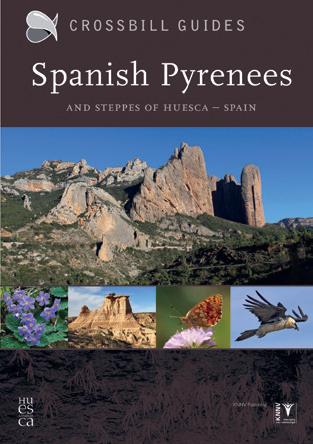
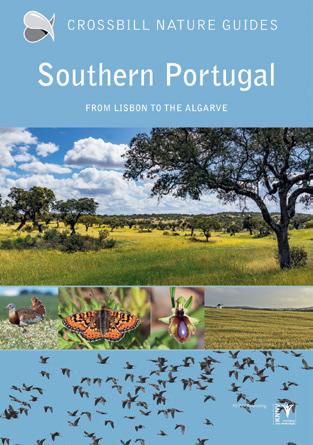
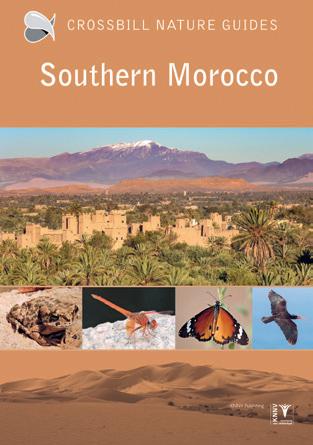
Spain Eastern Andalucía
From Córdoba to Cabo de Gata
Extremadura
Lanzarote and Fuerteventura
Spanish Pyrenees and the steppes of Huesca
Tenerife and La Gomera
Western Andalucía
From Huelva to Málaga
Available titles in Dutch
Netherlands Achterhoek en Liemers
Veluwe
Wadden
Weerribben-Wieden
Available titles in German
Germany
Eifel
Iceland Island
Ireland / UK Irland
Spain
Extremadura
More titles are in preparation. Check our website for further details and updates. WWW.CROSSBILLGUIDES.ORG
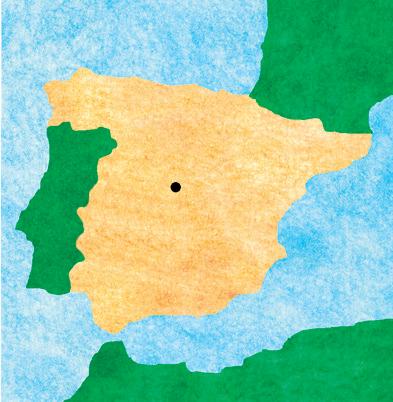
Western Andalucía
Andalucía is a region of contrast. There are wild mountains and extensive marshes, dry semi-desert and barren karst, but also leafy woodlands laced with murmuring streams. The biodiversity is the highest of any of the Spanish regions. Andalucía is the stronghold of the endangered Iberian Lynx, herds of wild Ibex roam the mountains and large numbers of vultures and eagles nest on remote, precipitous cliffs. In the windbeaten dune scrub, the Chameleon shelters, while huge numbers of waterfowl feed in the marshes. Each corner of Andalucía is different, but all share one characteristic – they all have jewels of natural areas that stand out for one reason or another. This region is too large and diverse to do it justice in a single guidebook. This book covers western Andalucía – Huelva, Seville, Cádiz and Málaga. It describes routes and sites in, amongst others, Coto Doñana, Cádiz and the strait of Gibraltar, Alcornocales, Sierra de Grazalema, las Nieves and Morena.
• The guide that covers the wildflowers, birds and all other wildlife
• Routes, where-to-watch-birds information and other observation tips
• Insightful information on landscape and ecology
“Everything you need to turn up in the right place and at the right time to find some of the best wildlife in Europe”
Chris Packham – BBC Springwatch
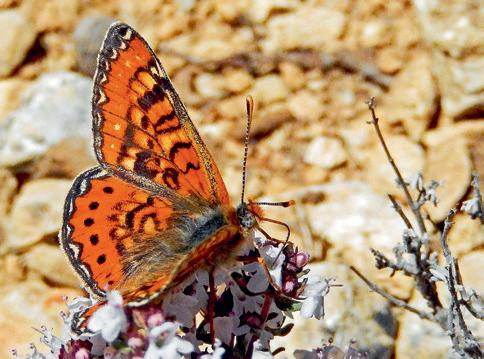
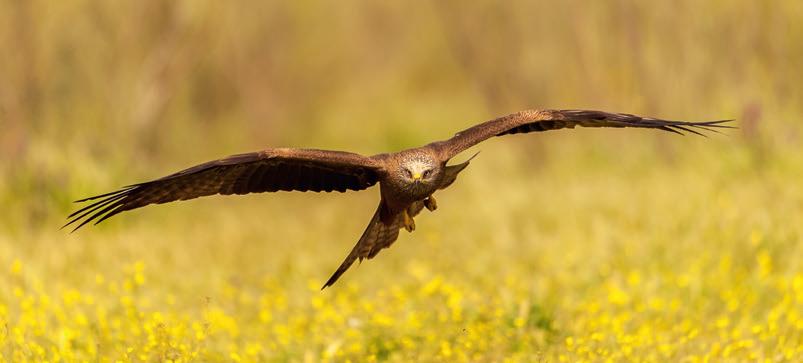

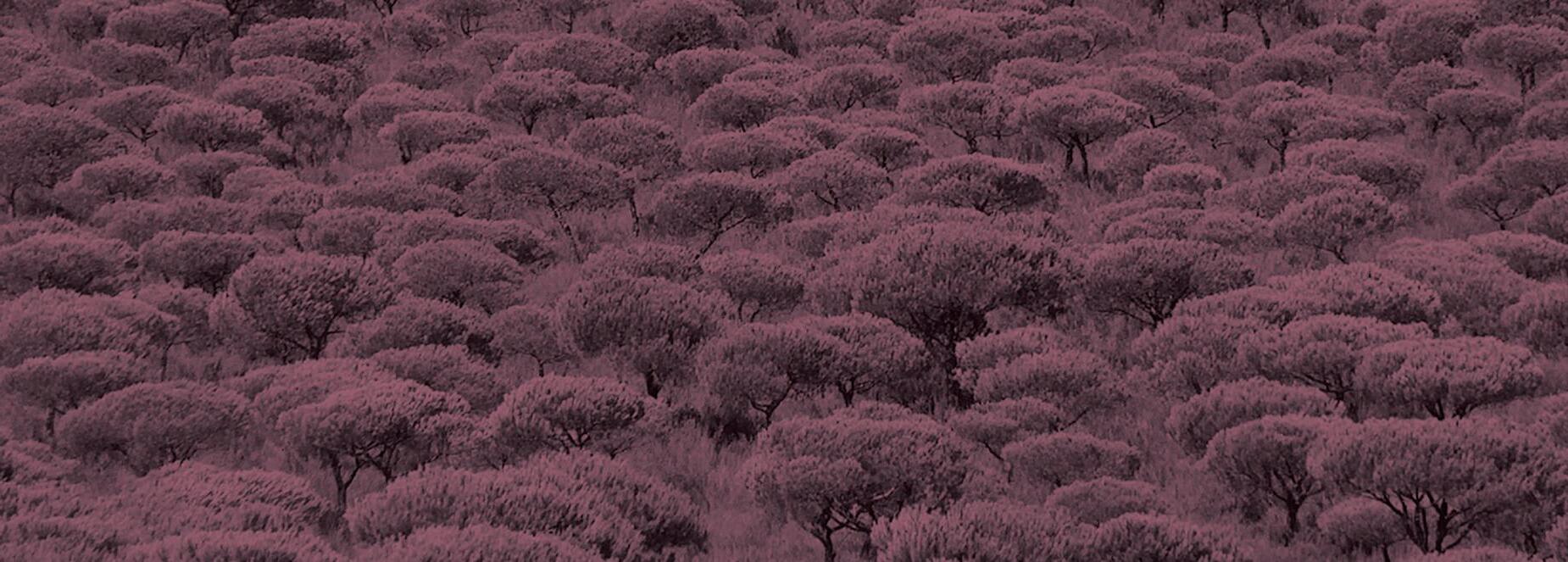 MADRID
MADRID